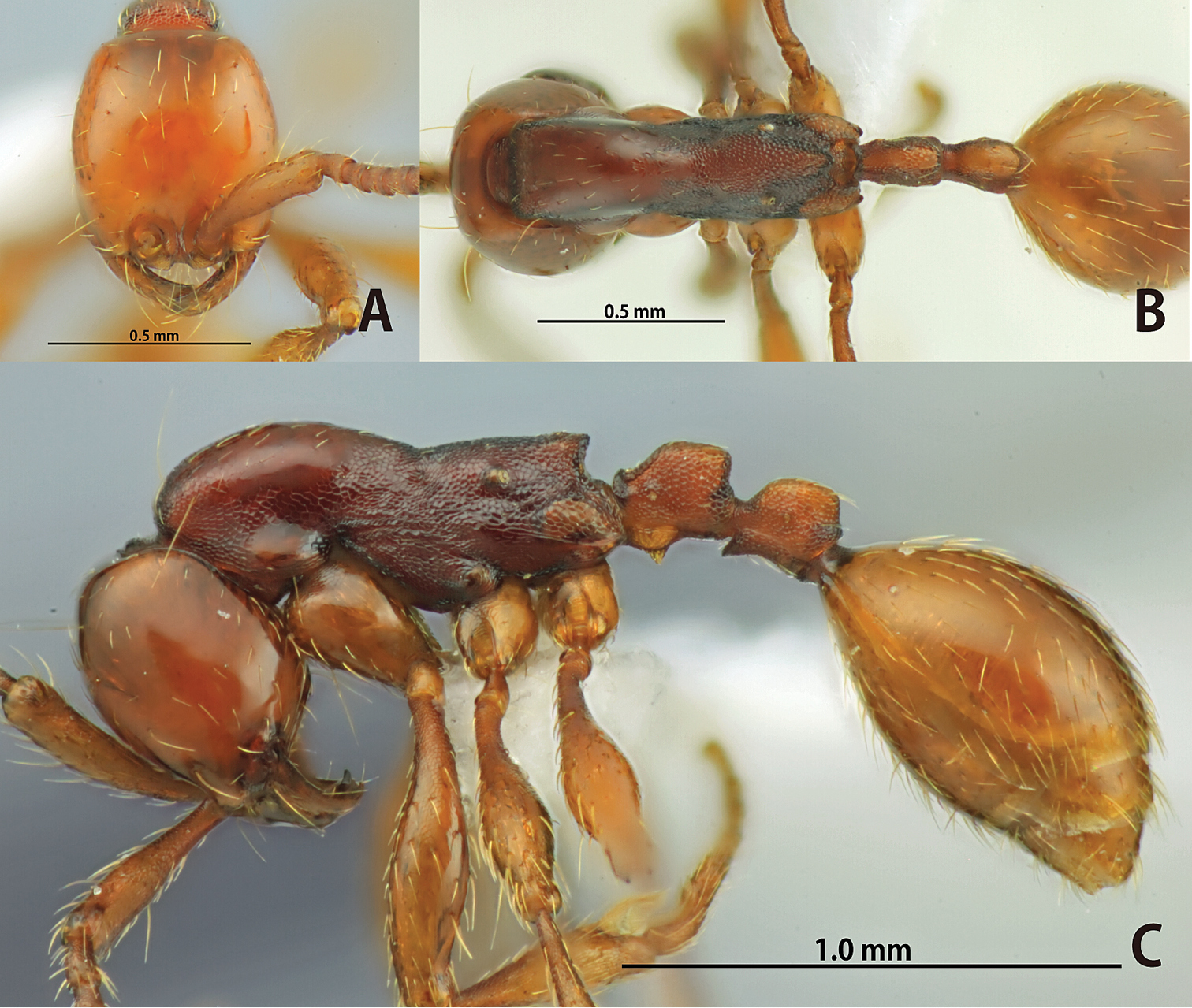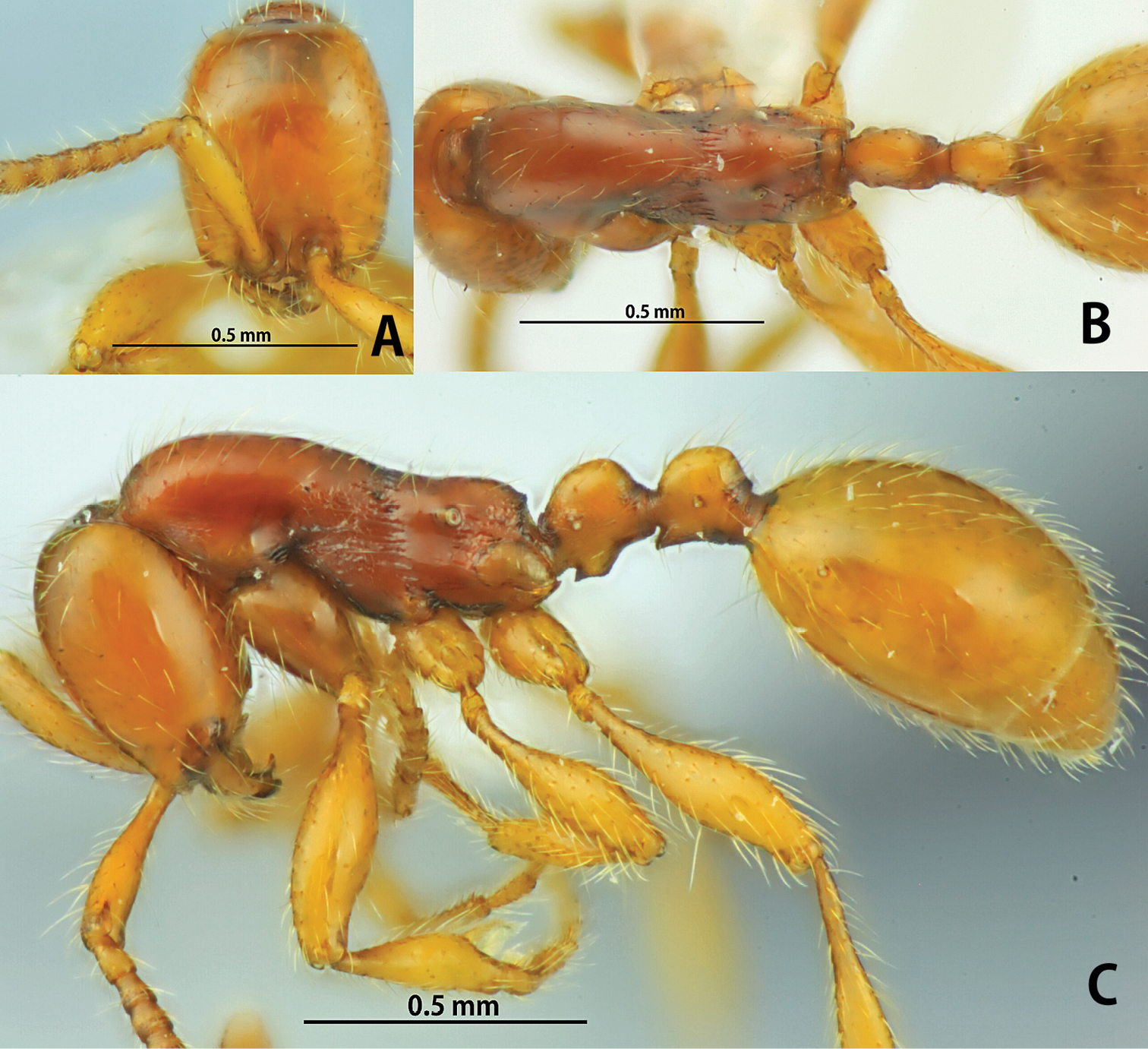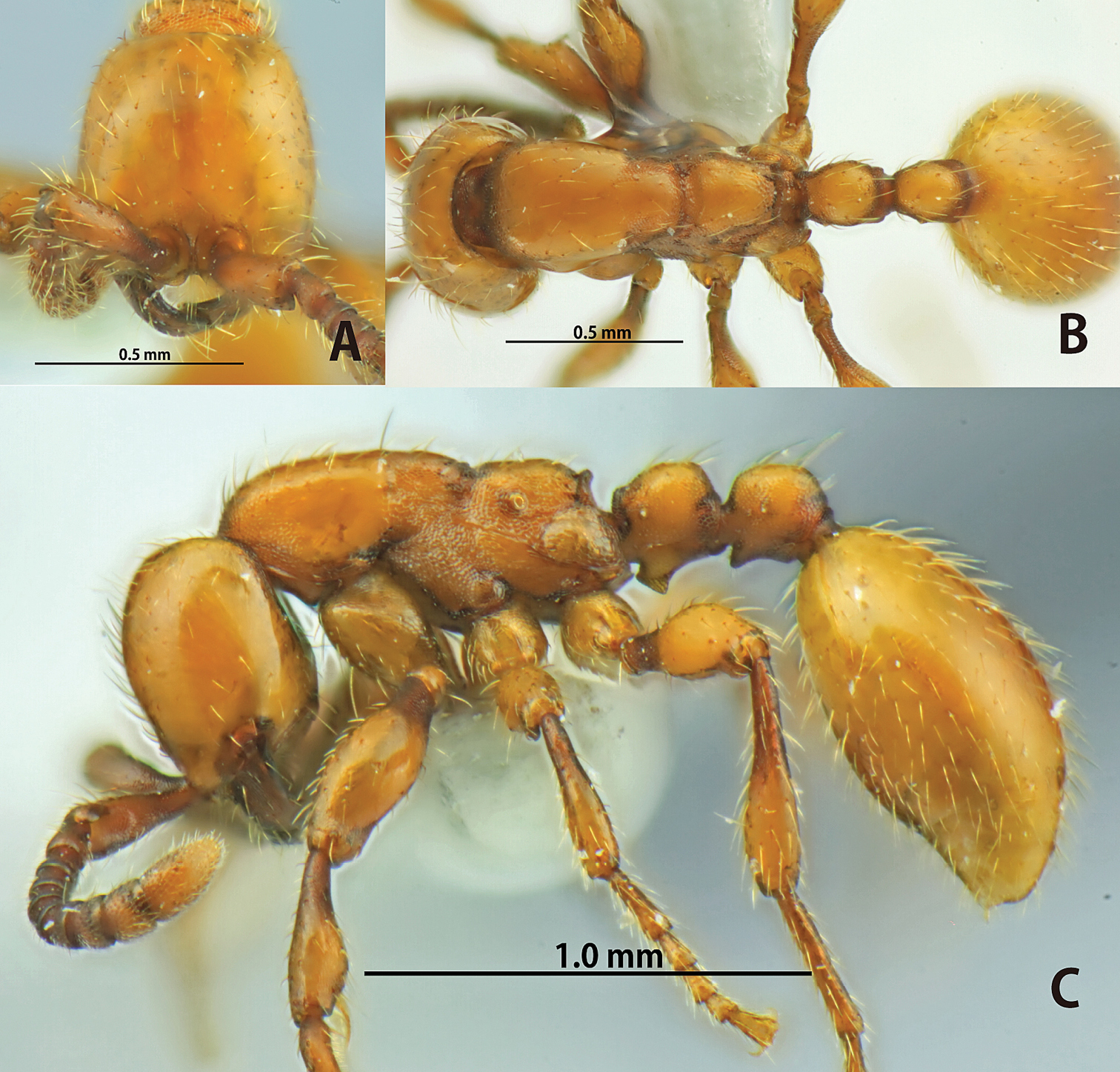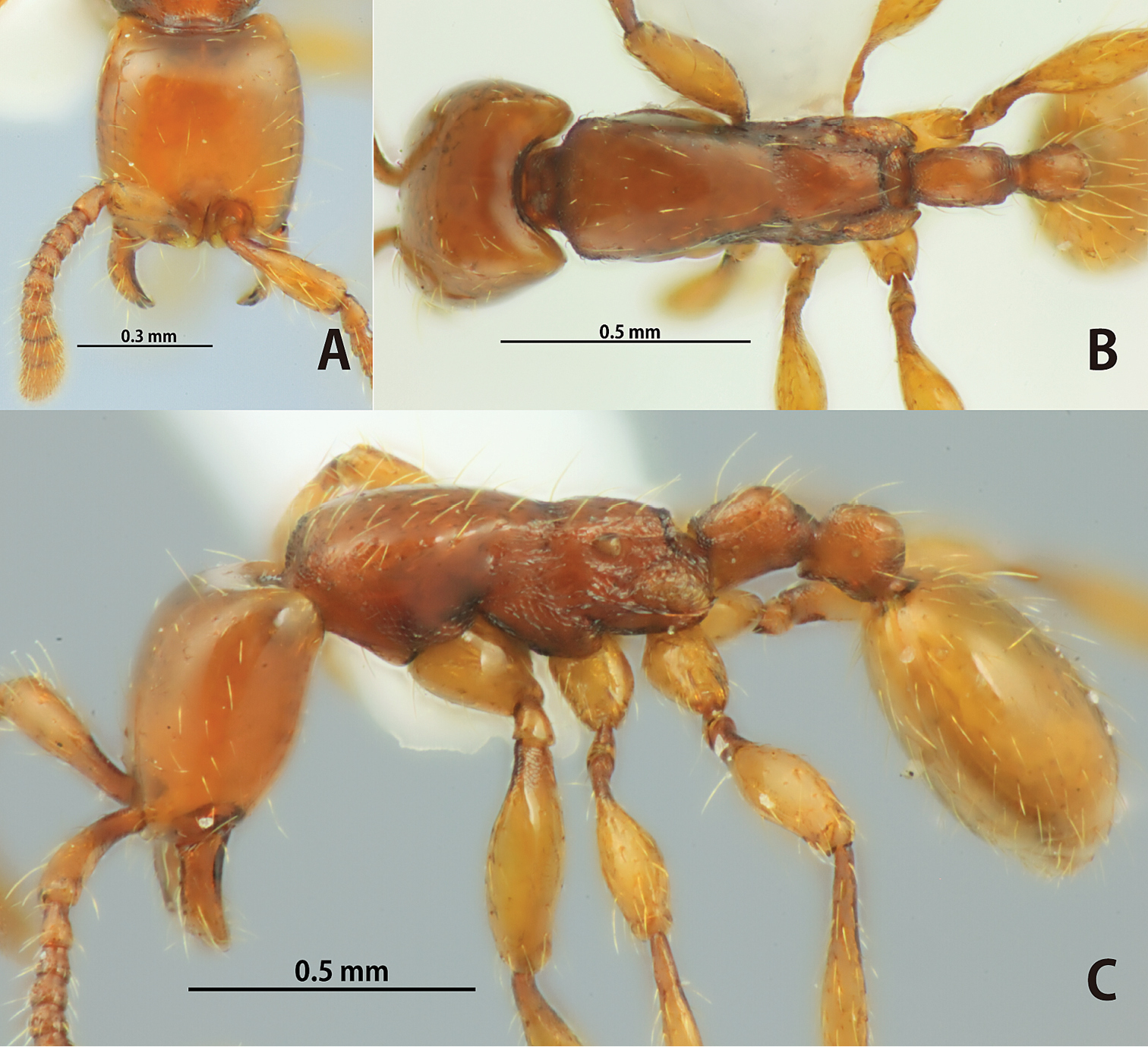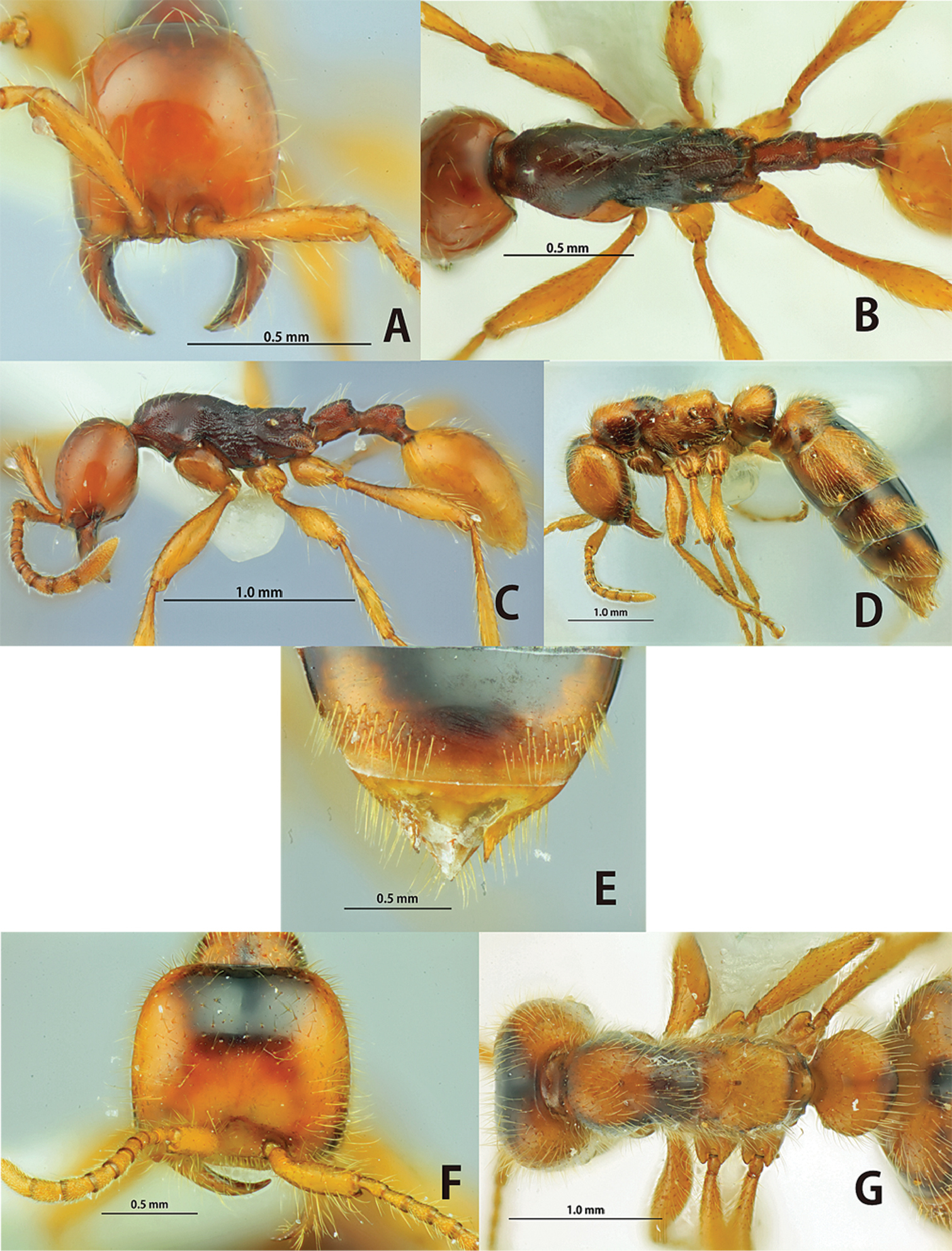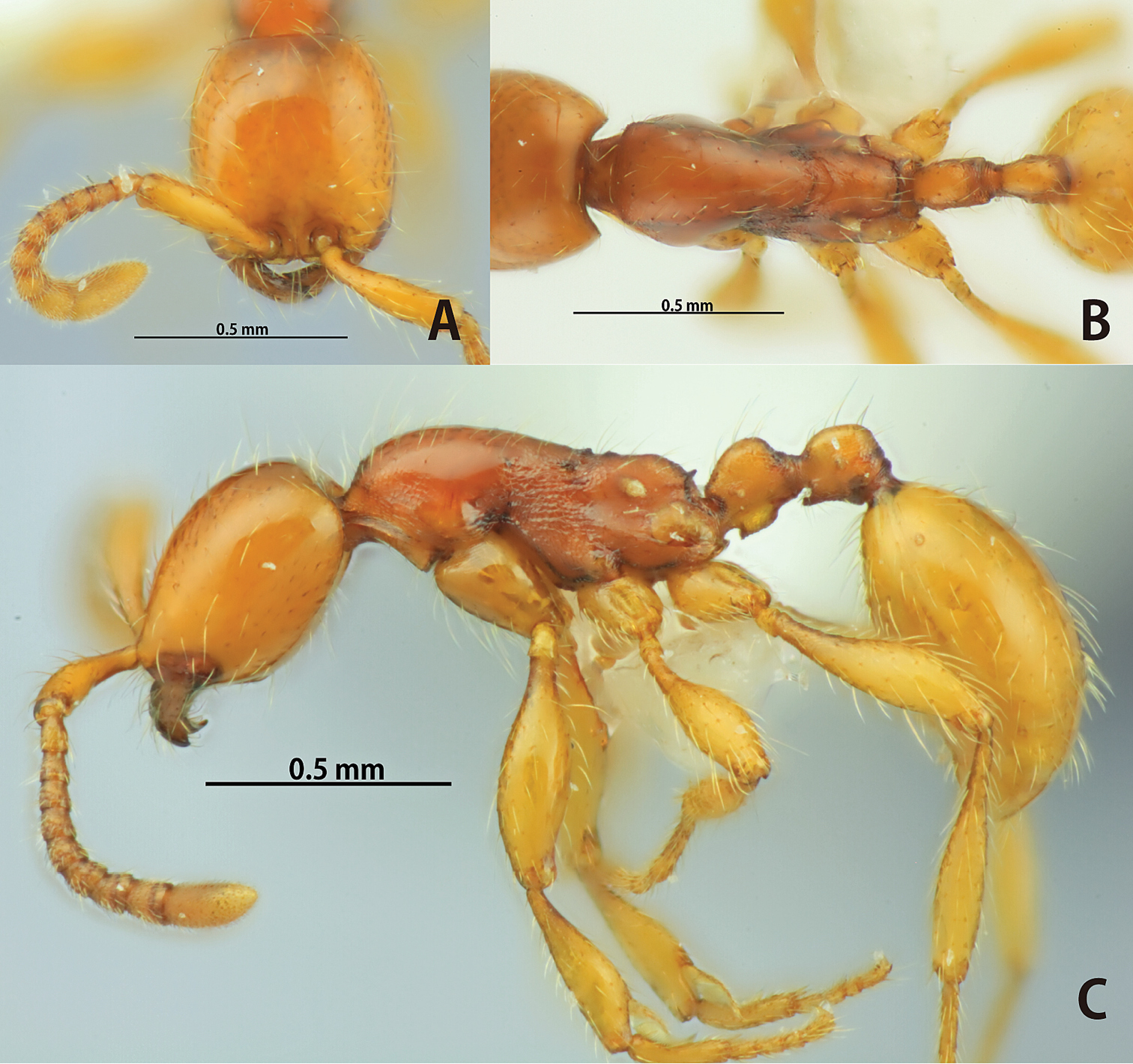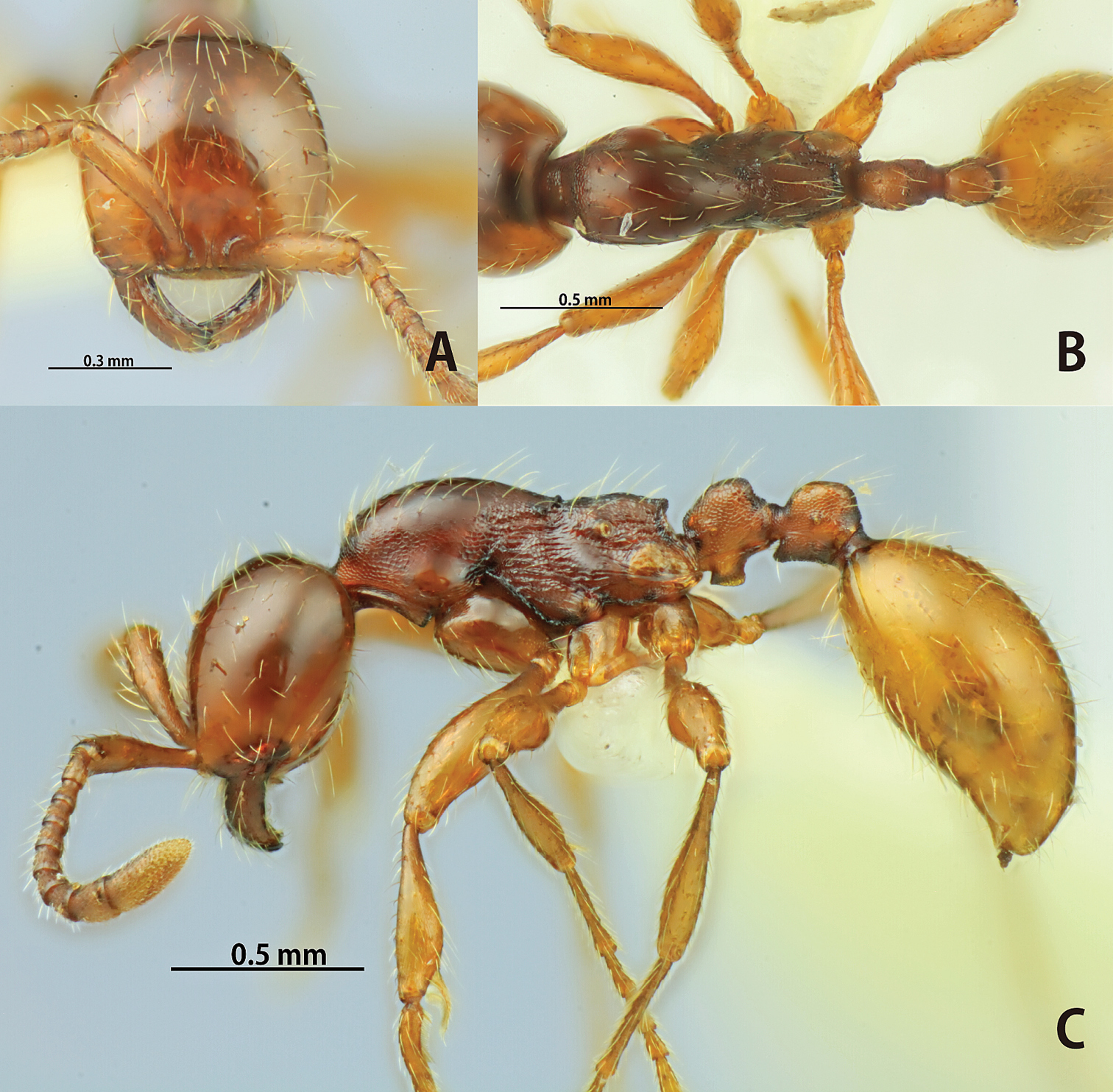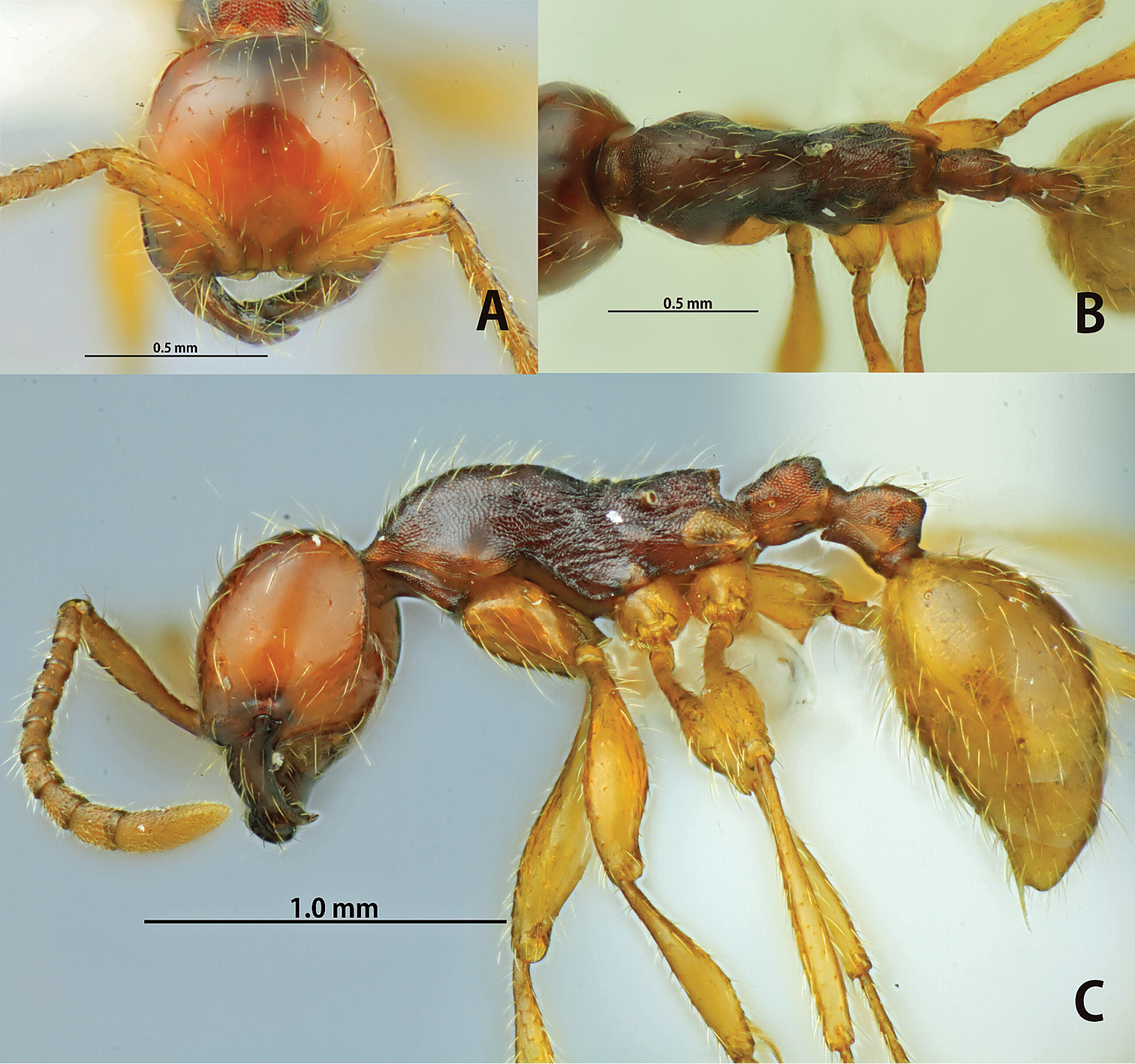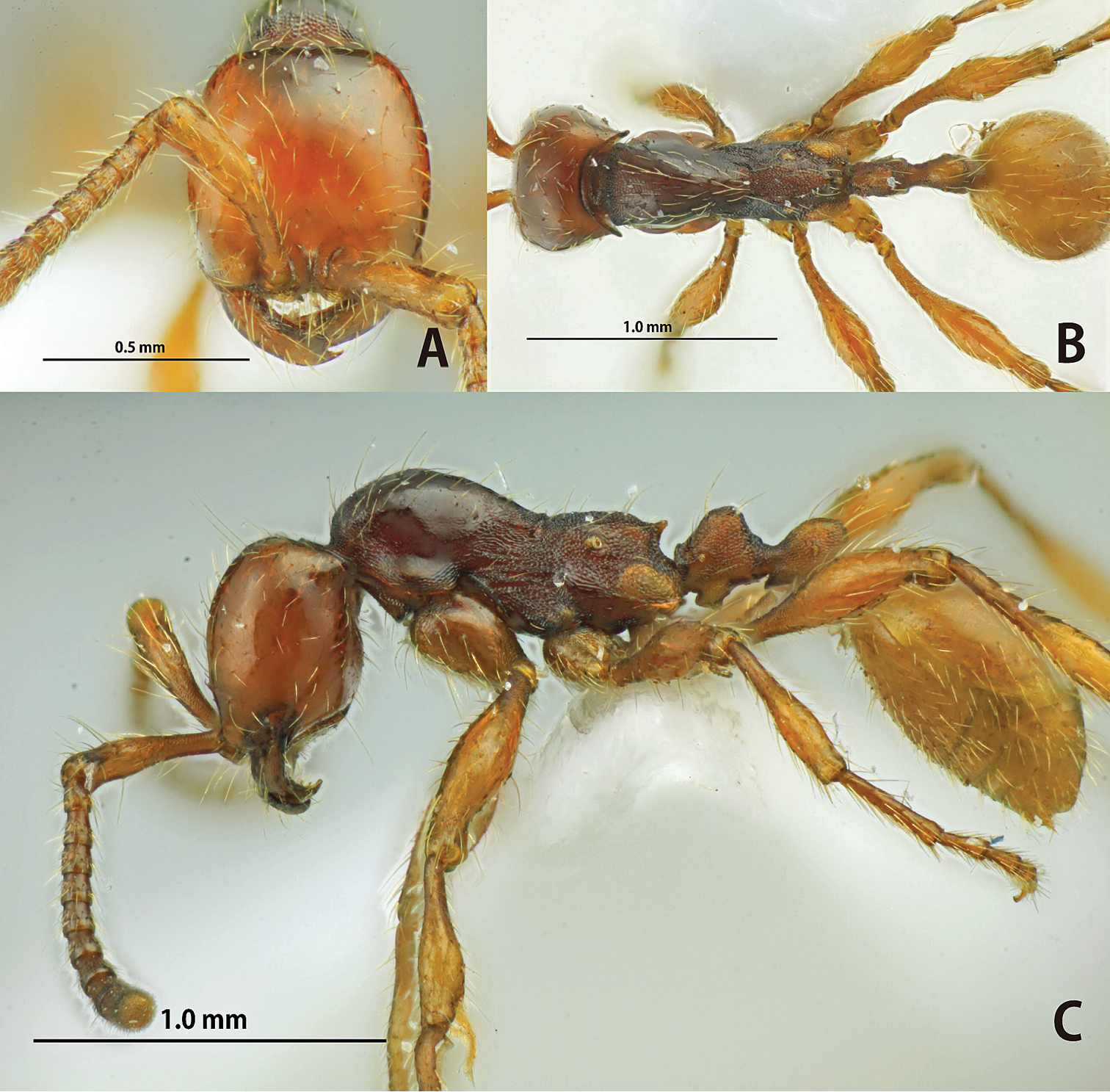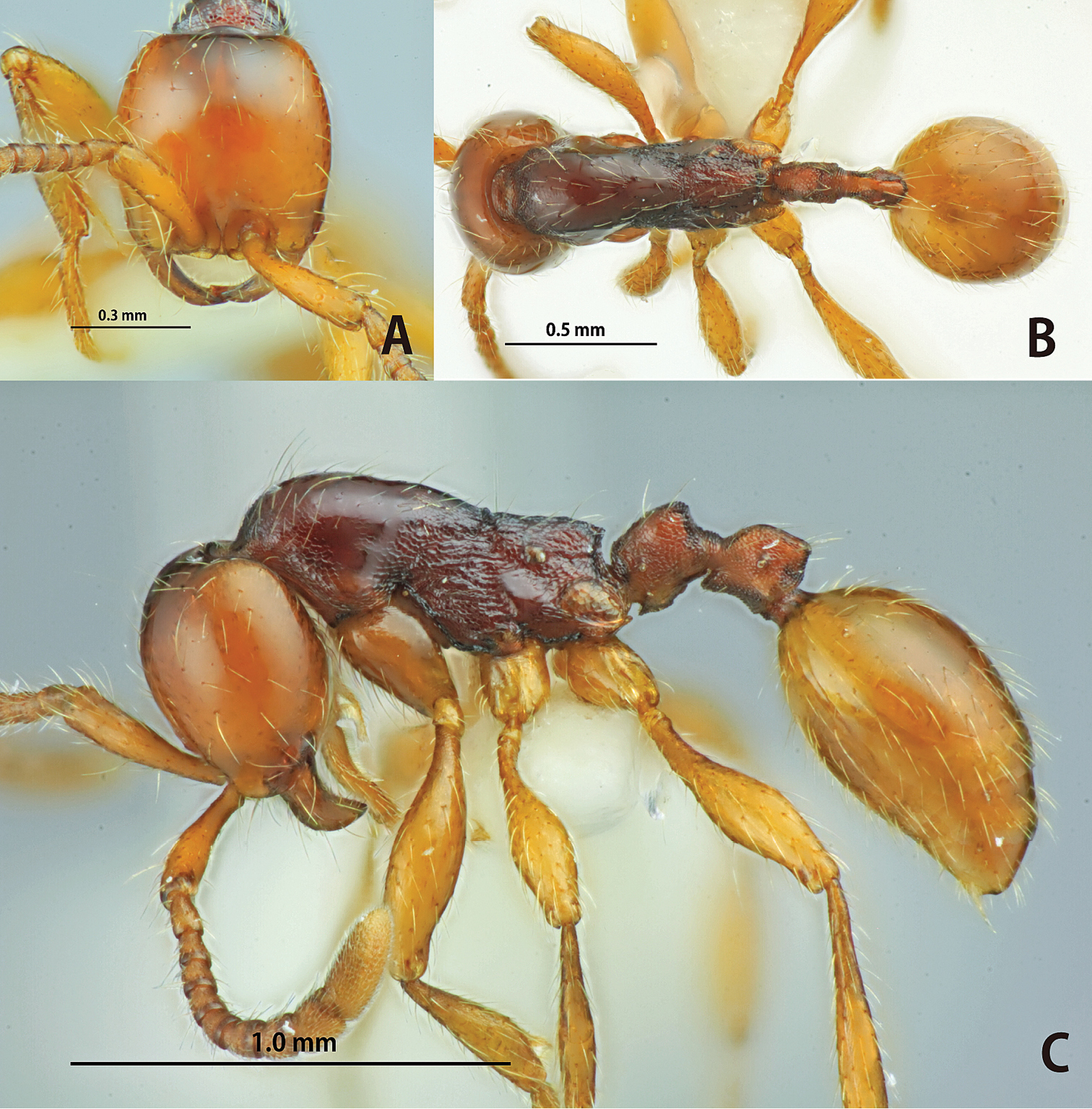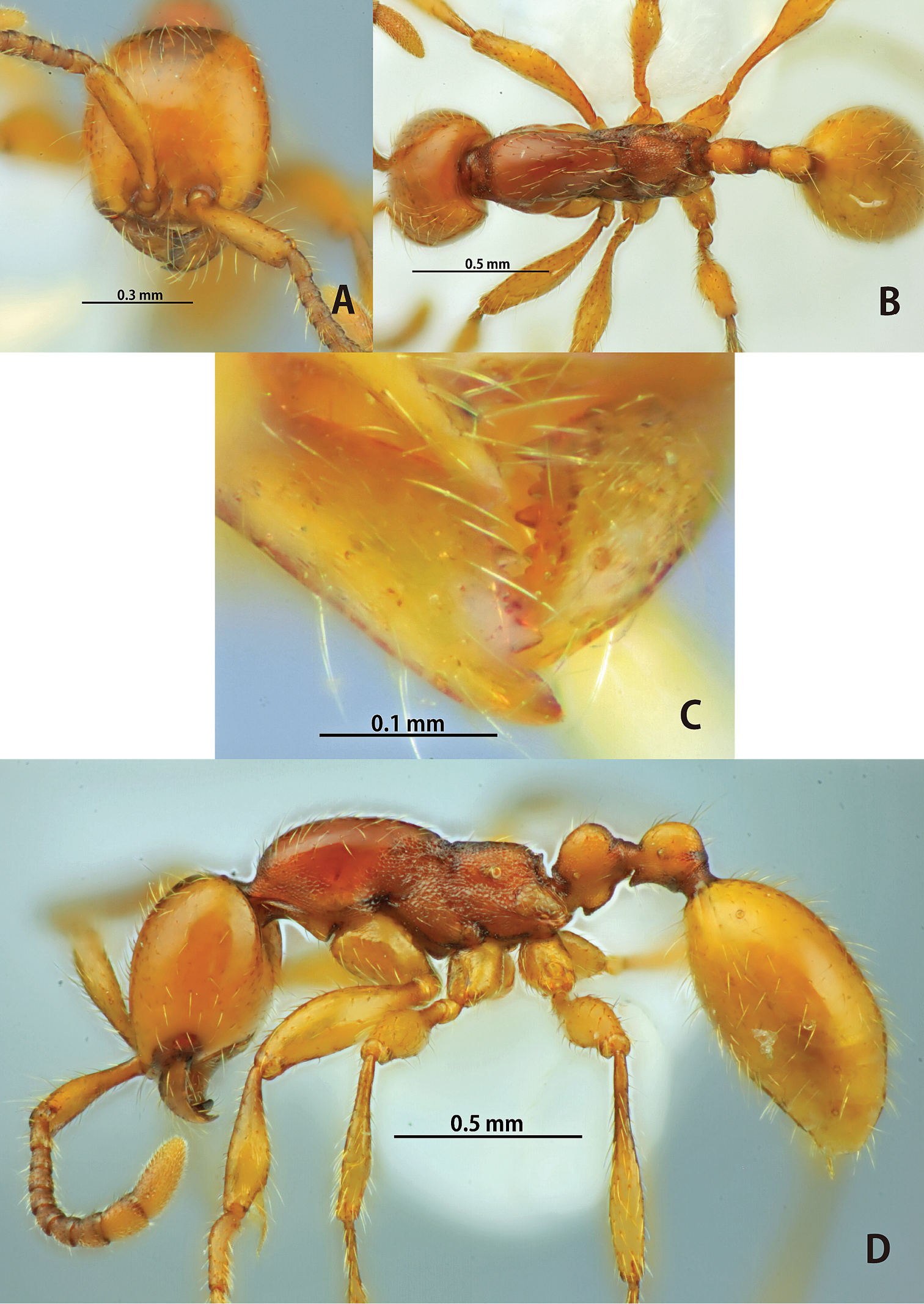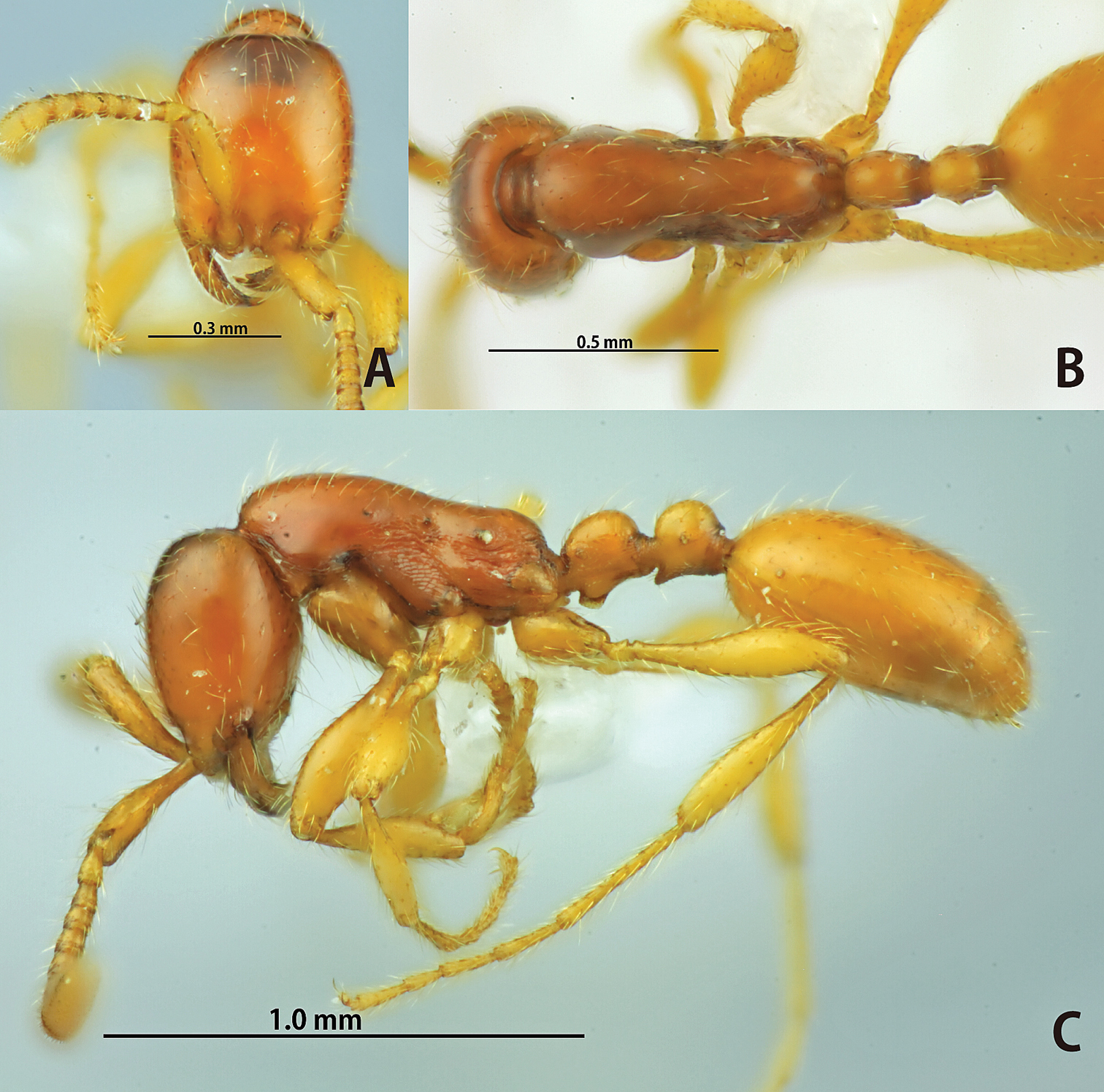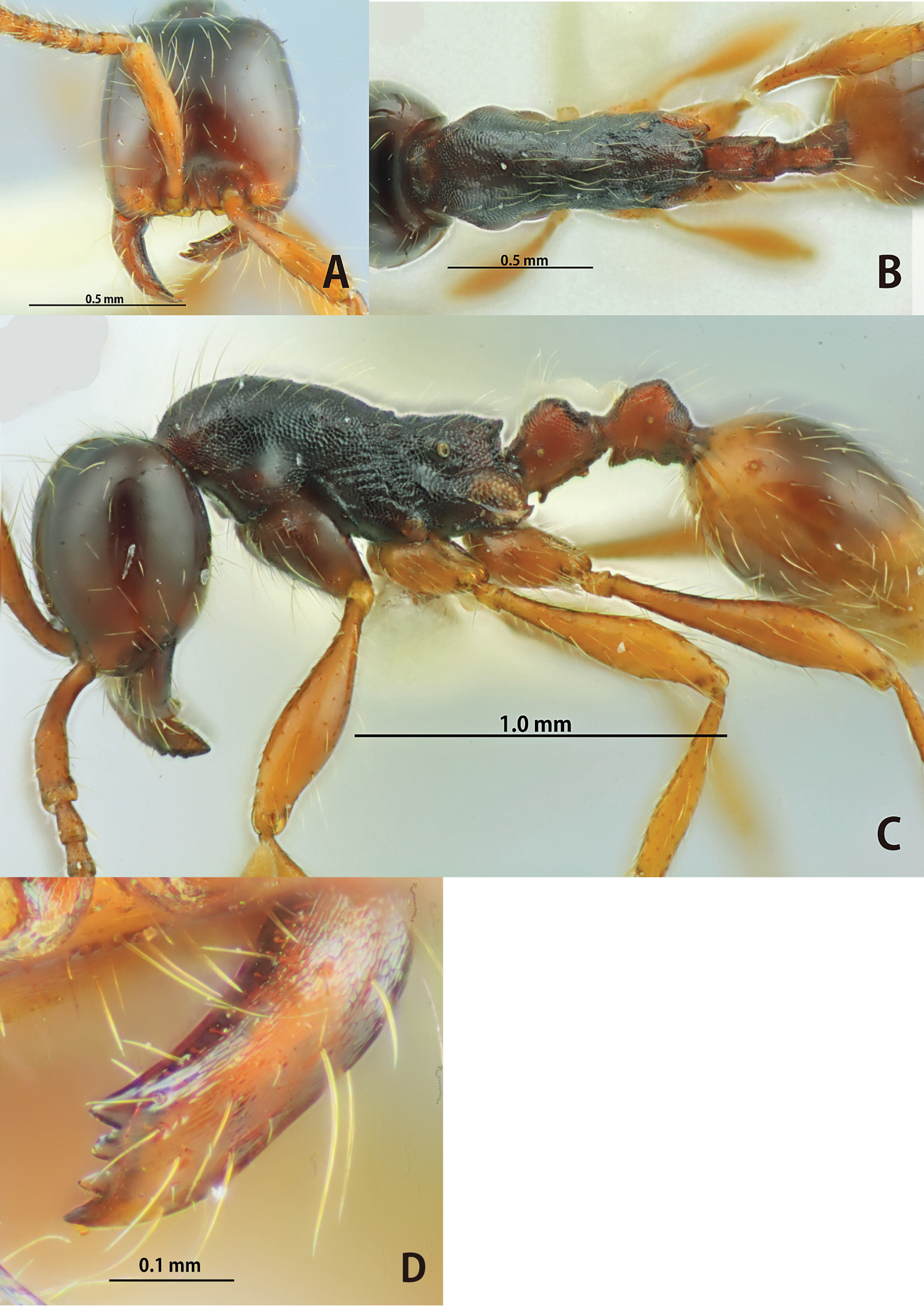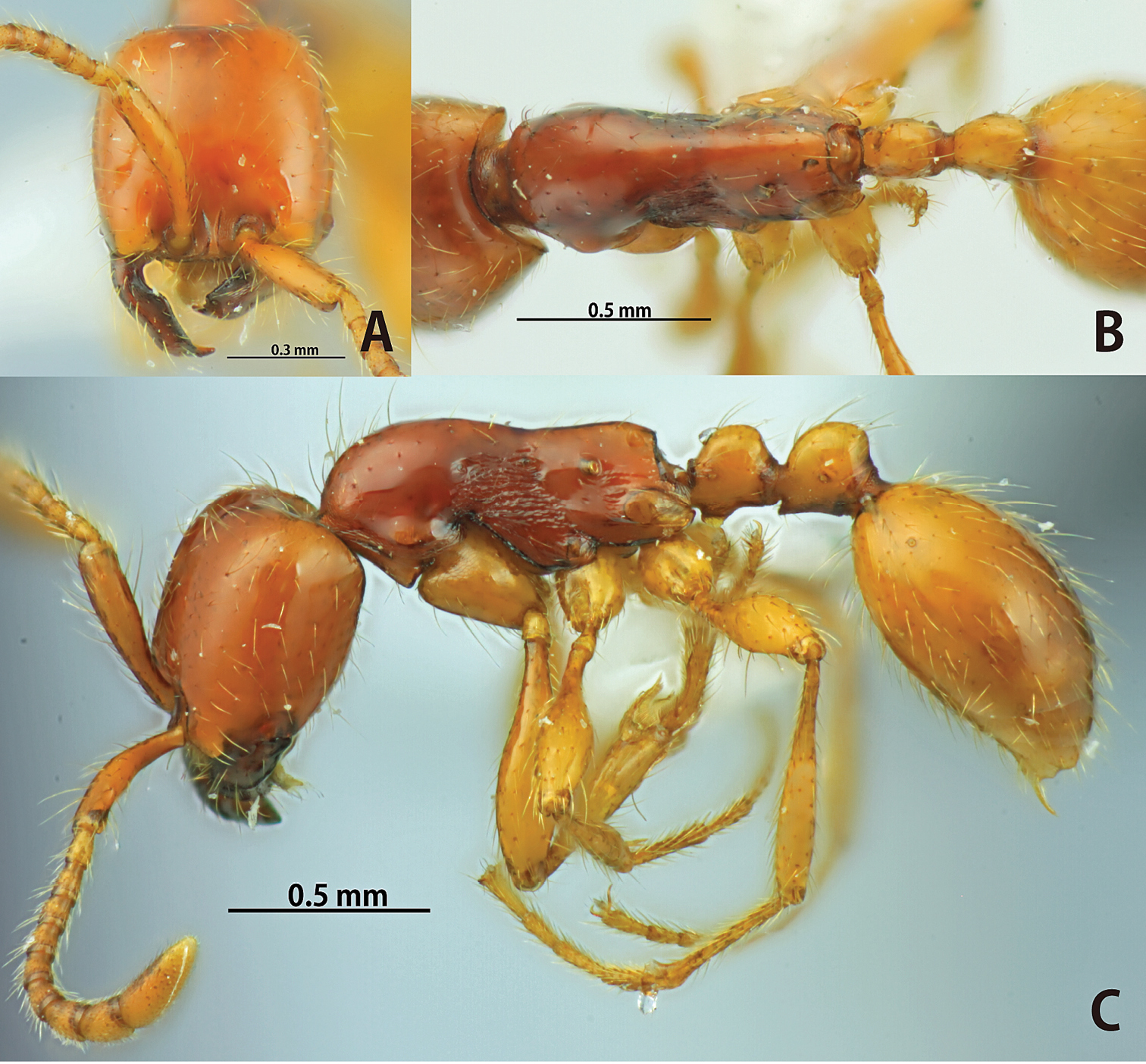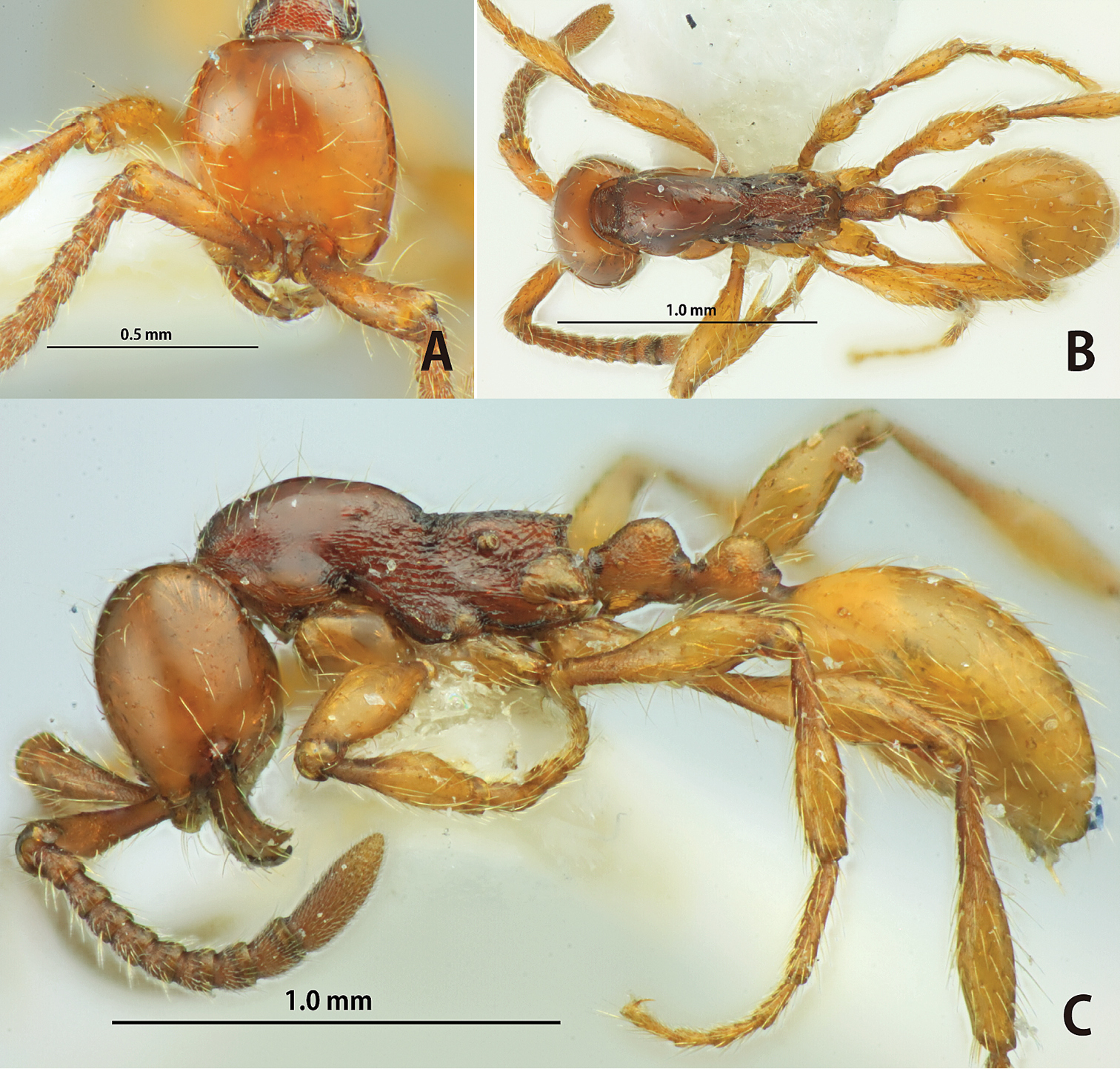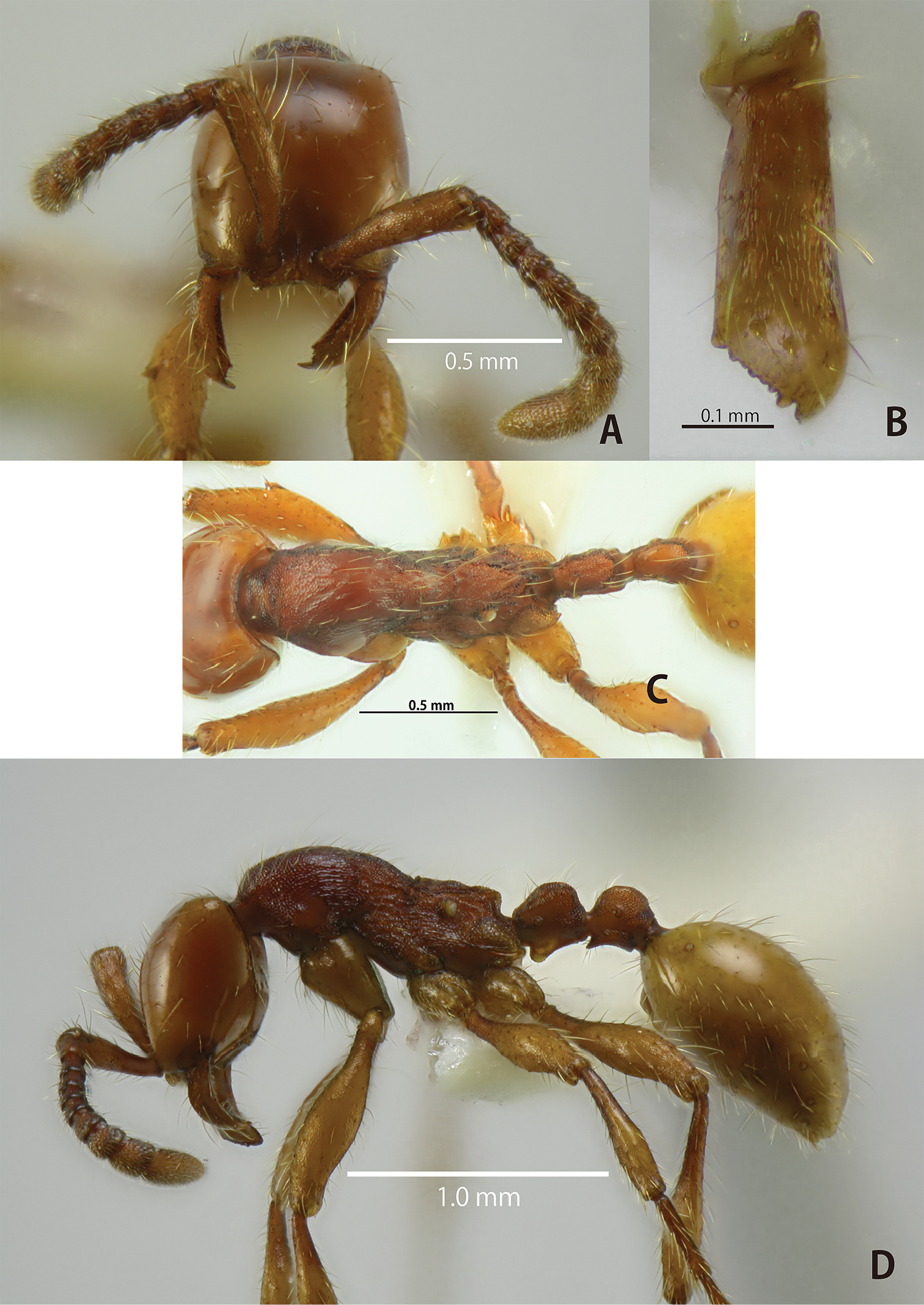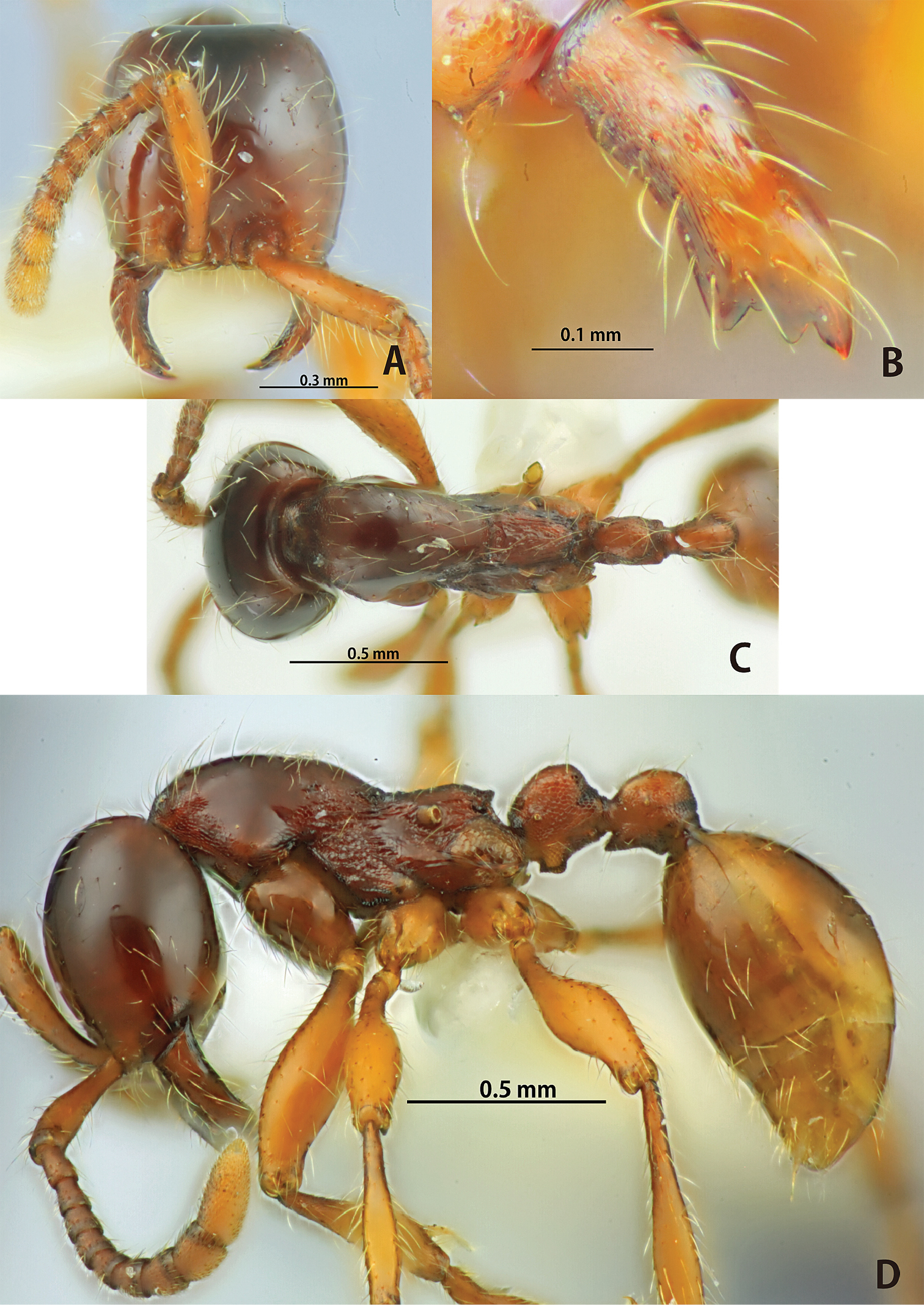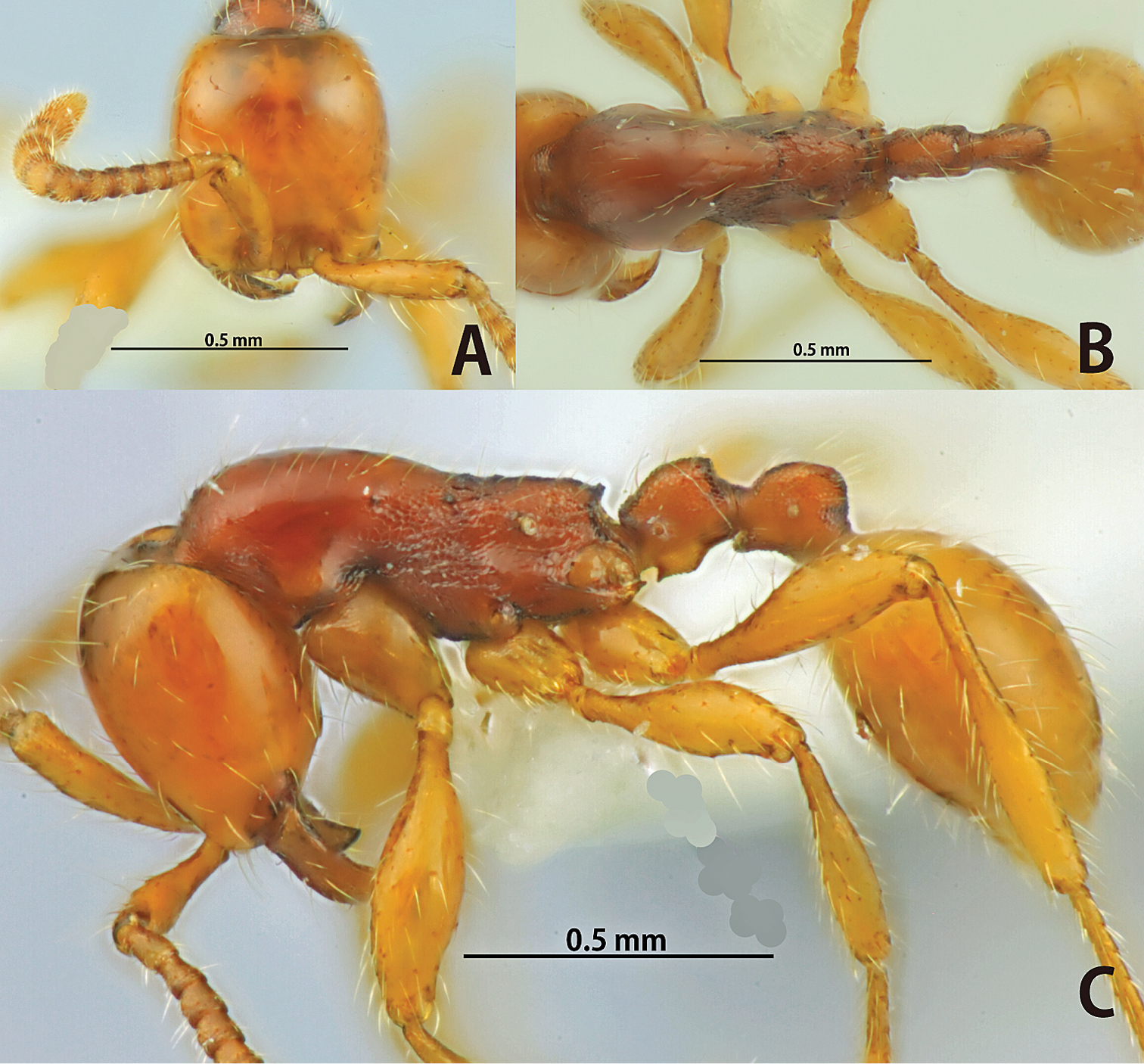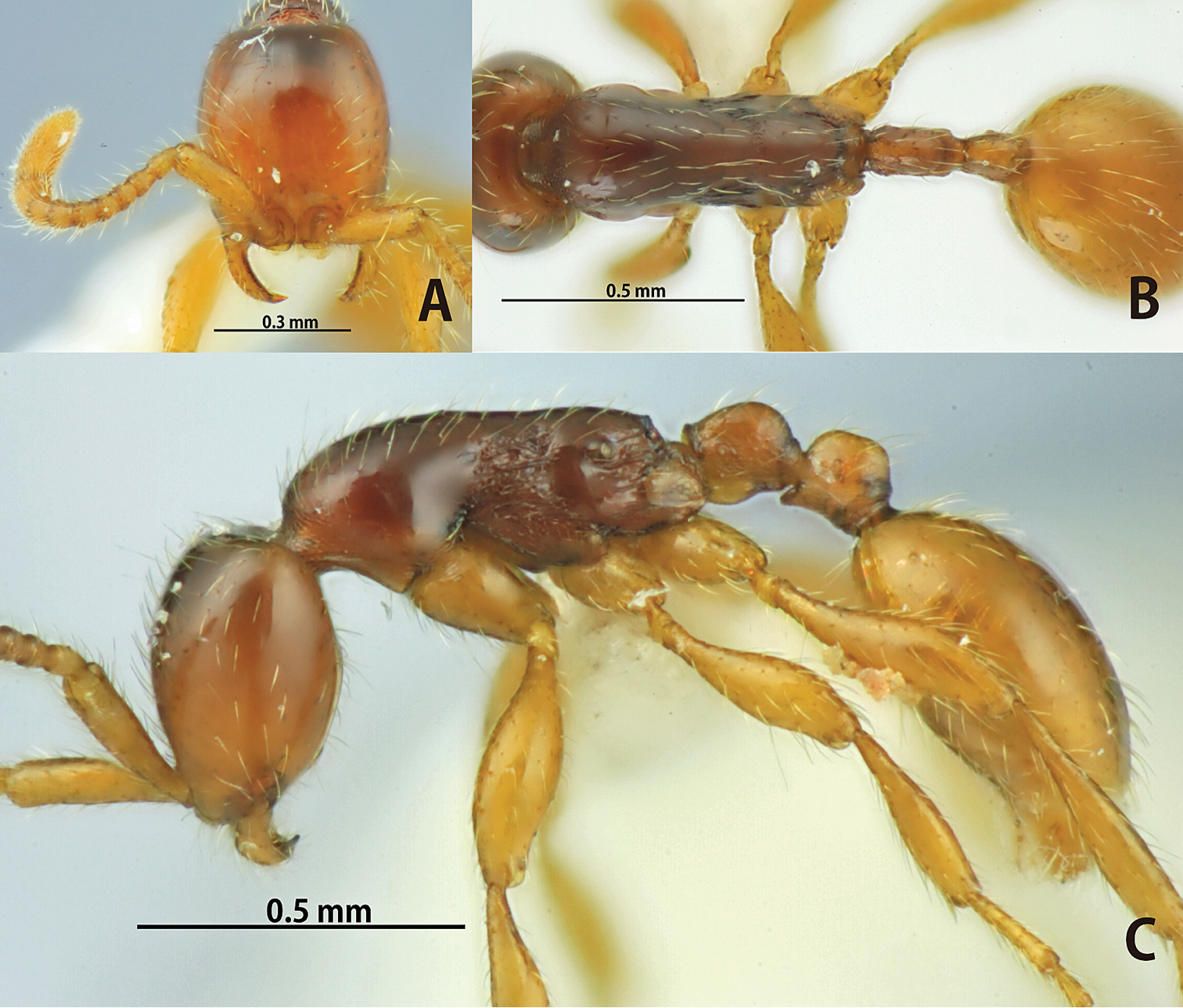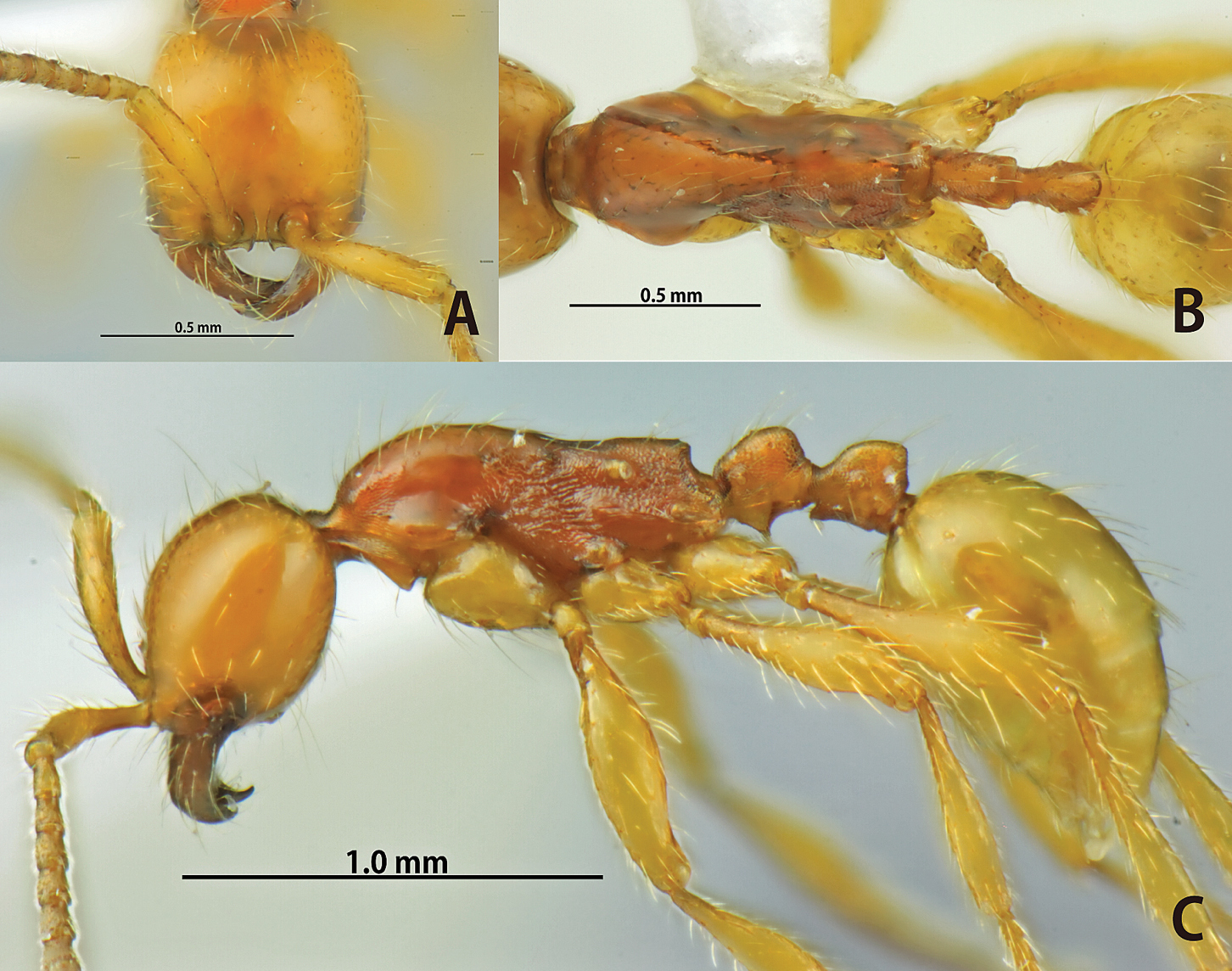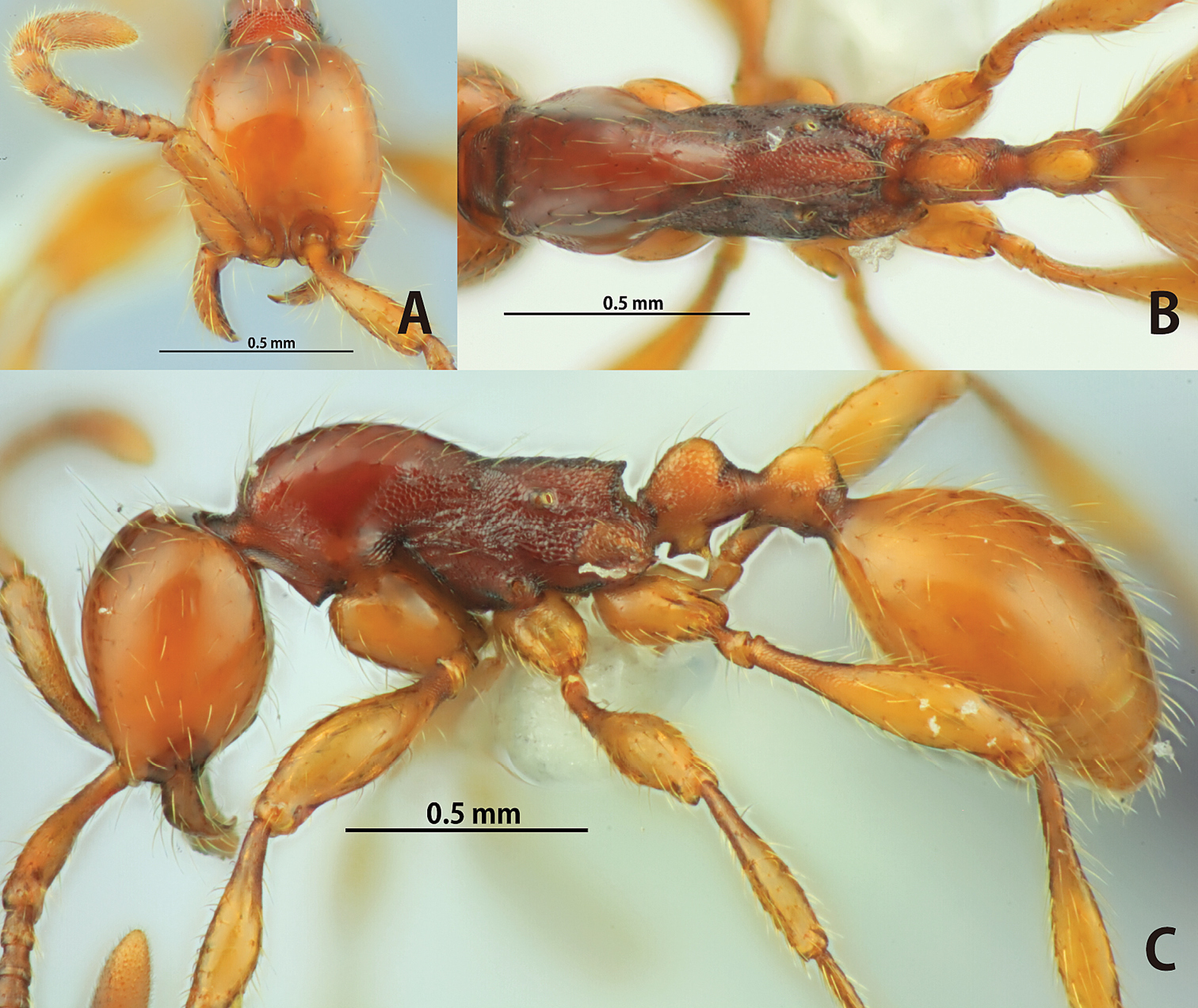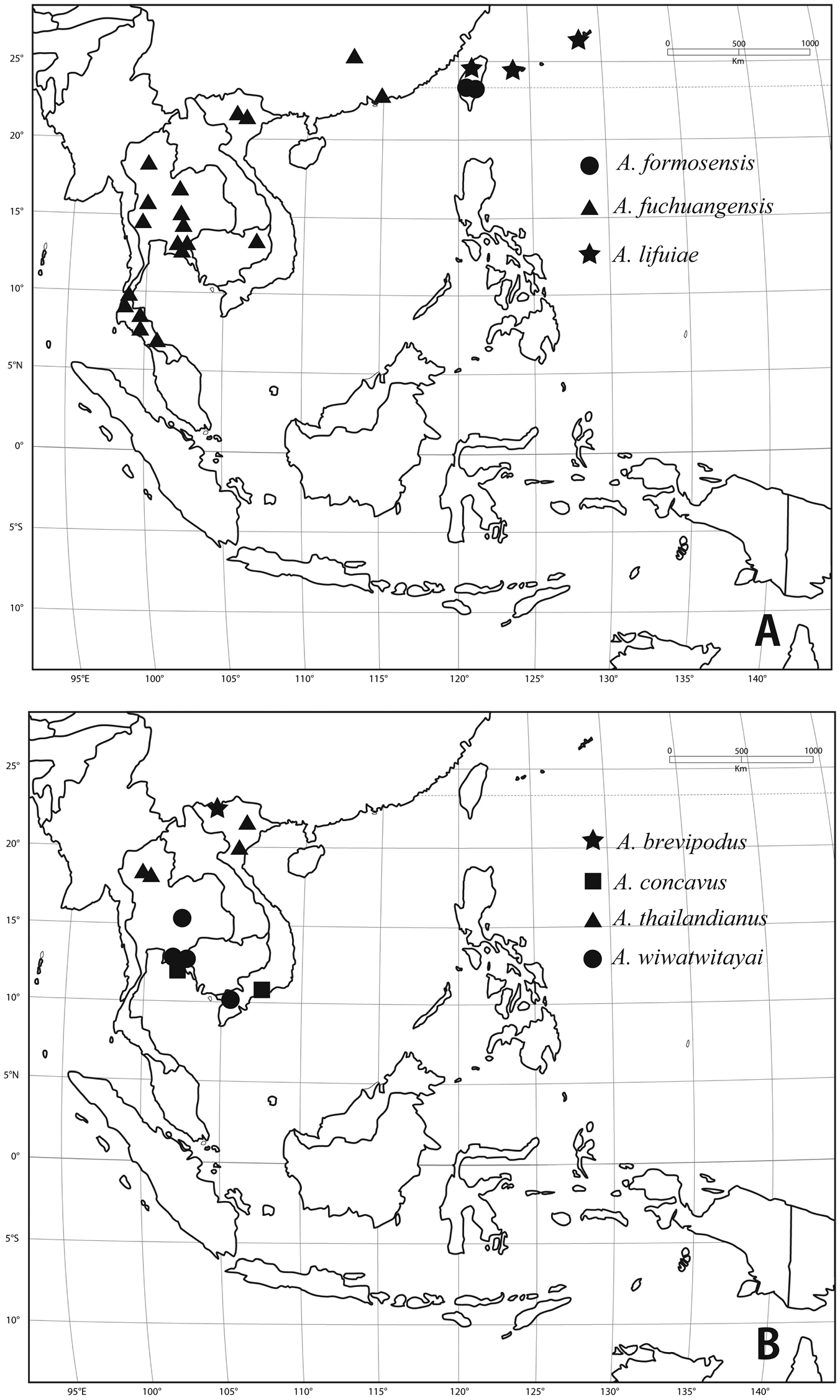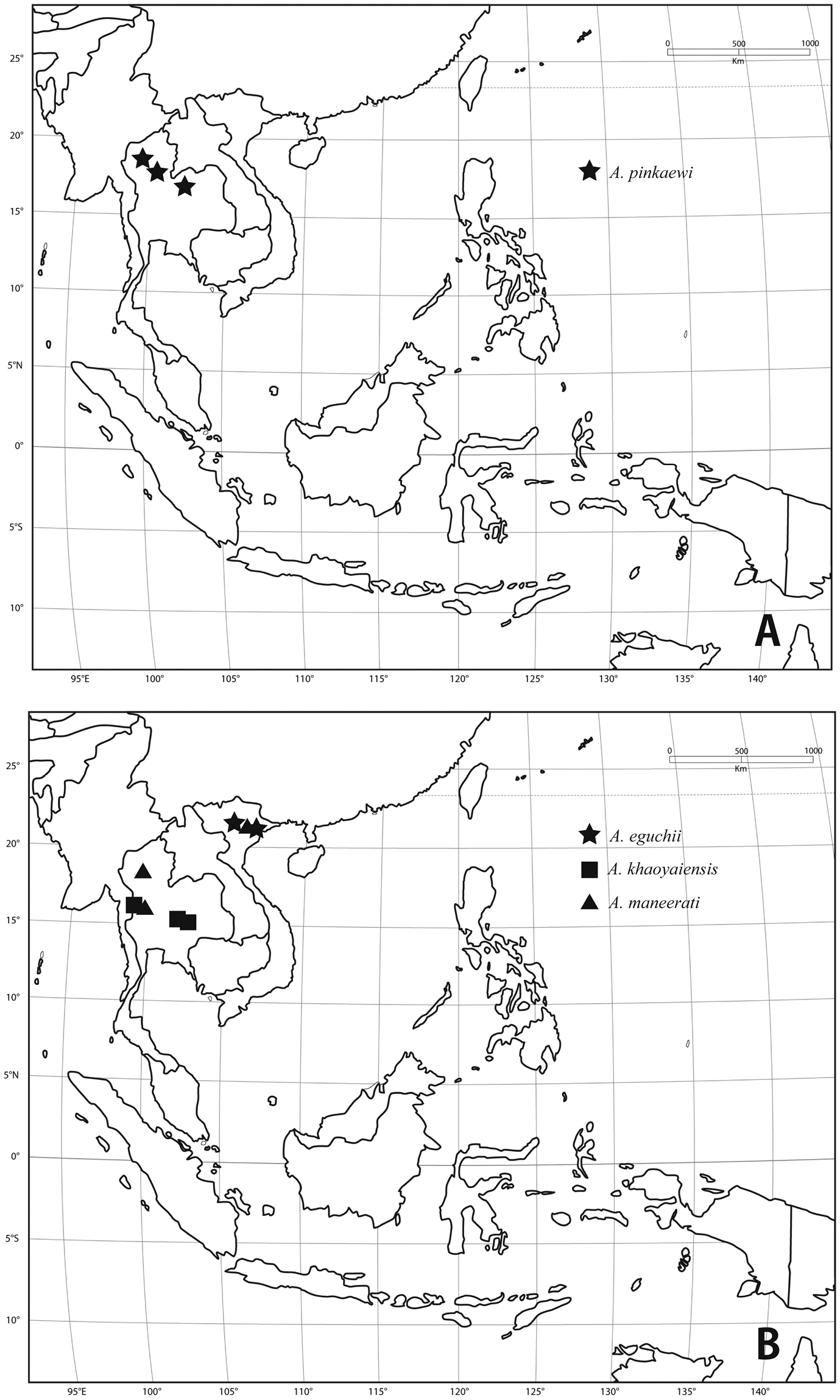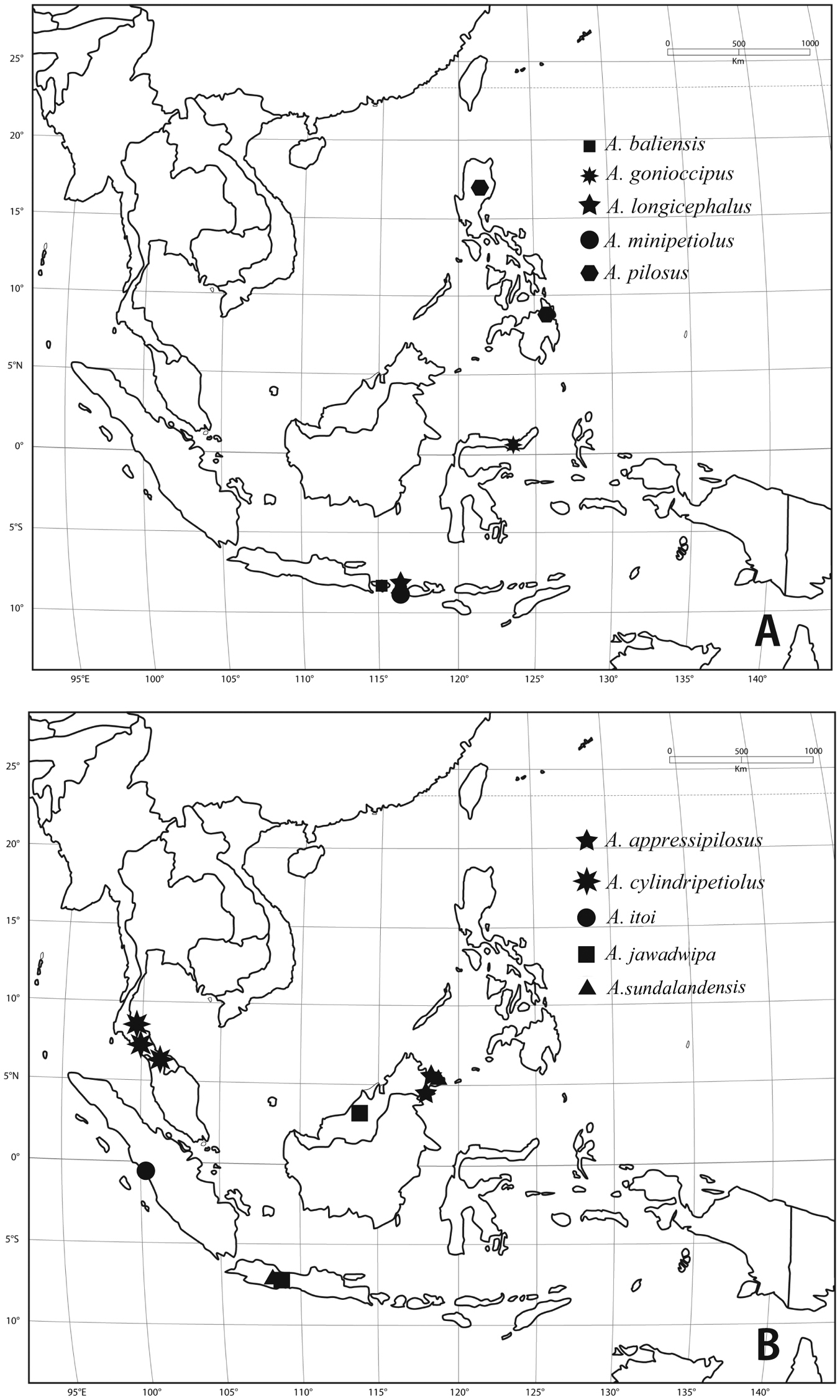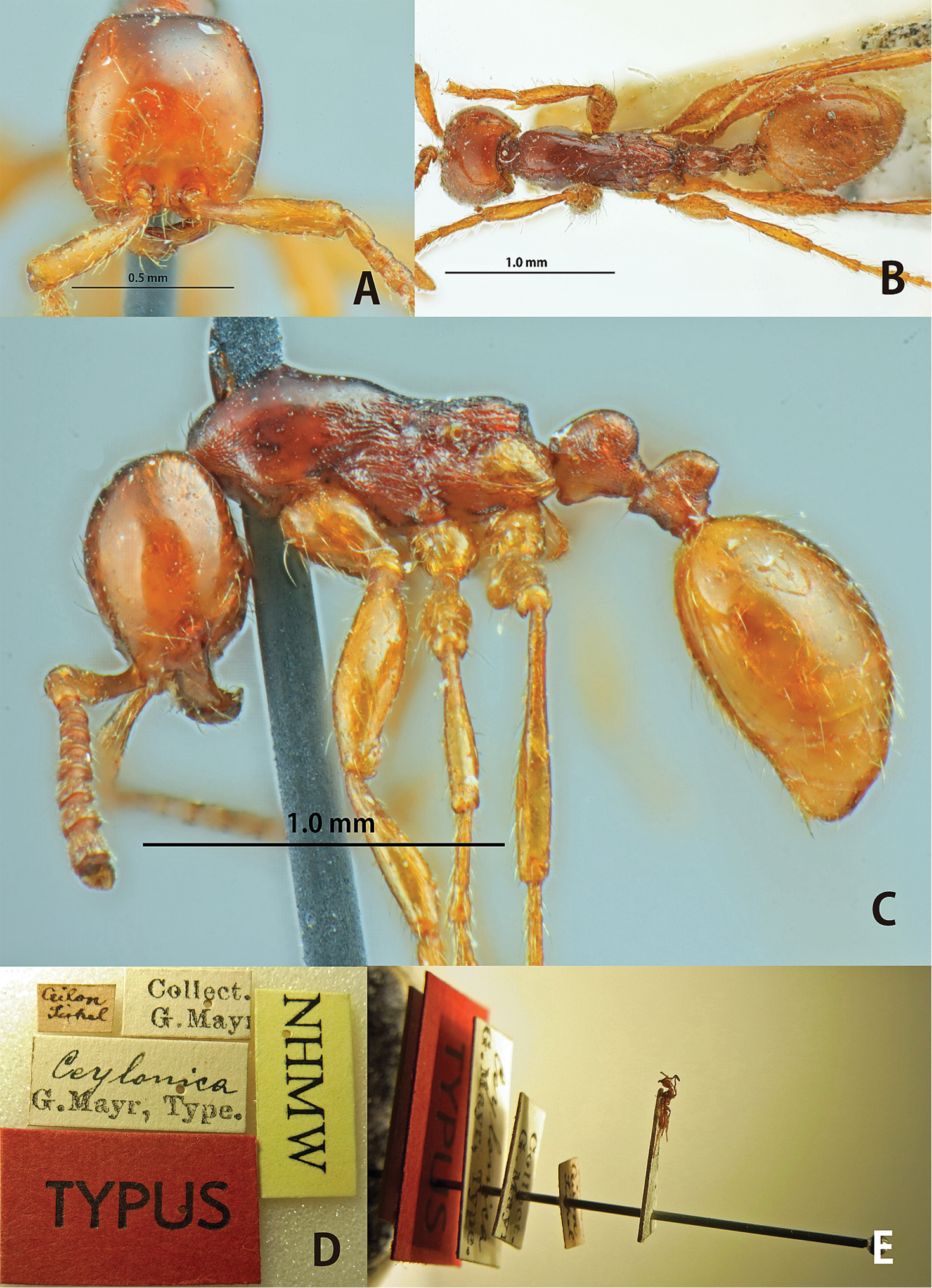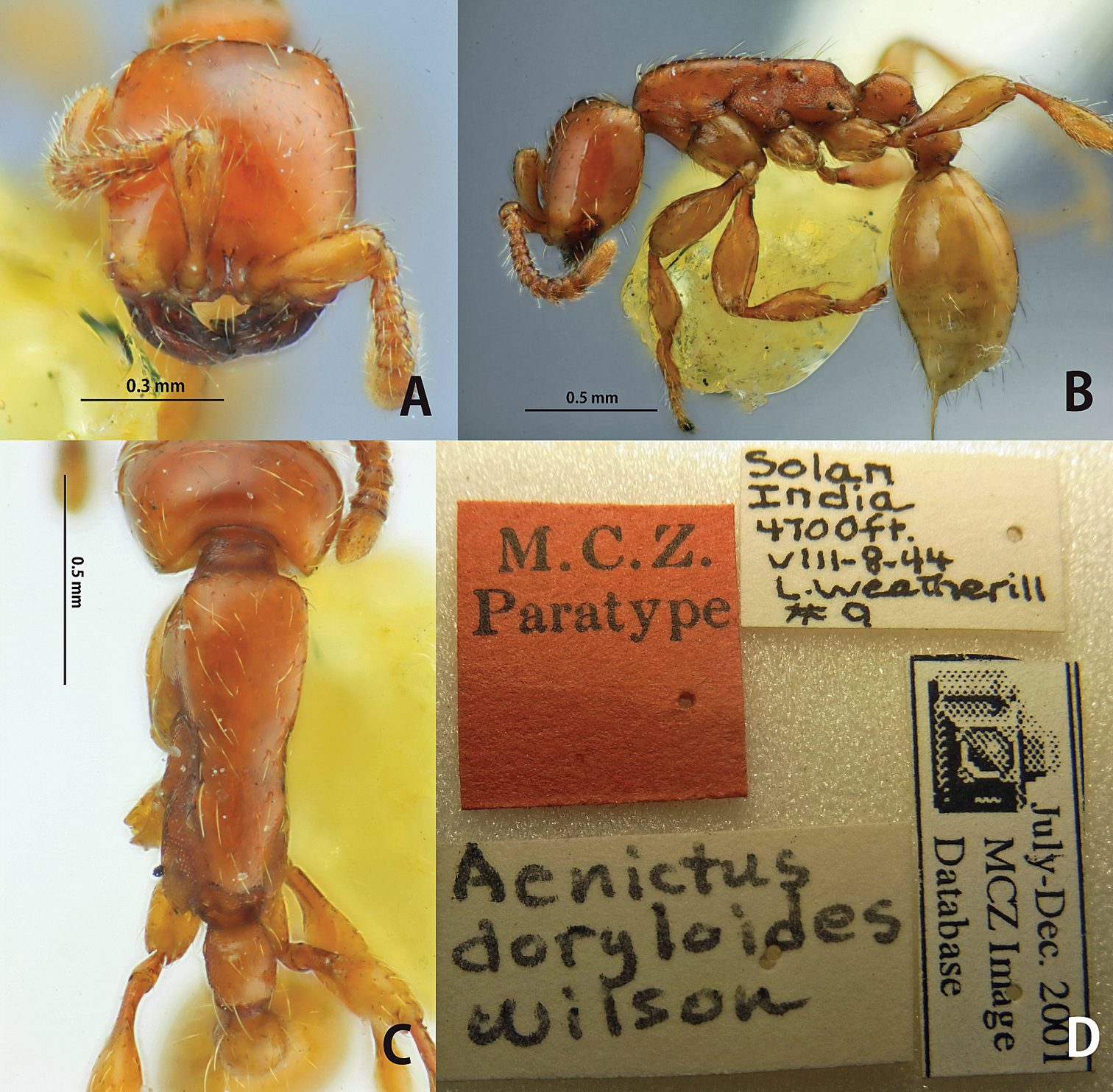






(C) 2013 Weeyawat Jaitrong. This is an open access article distributed under the terms of the Creative Commons Attribution License 3.0 (CC-BY), which permits unrestricted use, distribution, and reproduction in any medium, provided the original author and source are credited.
For reference, use of the paginated PDF or printed version of this article is recommended.
The genus Aenictus is a diverse group of army ants in the Old World tropics and subtropics. The Southeast Asian species of the Aenictus ceylonicus group are revised to include twenty-three species (4 named and 19 new species): Aenictus appressipilosus sp. n., Aenictus baliensis sp. n., Aenictus brevipodus sp. n., Aenictus concavus sp. n., Aenictus cylindripetiolus sp. n., Aenictus eguchii sp. n., Aenictus formosensis Forel, 1913 stat. n., Aenictus fuchuanensis Zhou, 2001, Aenictus gonioccipus sp. n., Aenictus itoi sp. n., Aenictus jawadwipa sp. n., Aenictus khaoyaiensis sp. n., Aenictus lifuiae Terayama, 1984, Aenictus longicephalus sp. n., Aenictus maneerati sp. n., Aenictus minipetiolus sp. n., Aenictus pilosus sp. n., Aenictus pinkaewi sp. n., Aenictus sundalandensis sp. n., Aenictus thailandianus Terayama & Kubota, 1993, Aenictus watanasiti sp. n., Aenictus wilaiae sp. n., and Aenictus wiwatwitayai sp. n. Aenictus ceylonicus var. formosensis Forel is removed from synonymy with Aenictus ceylonicus and raised to full species. Lectotype and paralectotypes are designated for Aenictus ceylonicus. Redescriptions of Aenictus ceylonicus (Mayr, 1866) (India and Sri Lanka) andAenictus doryloides Wilson, 1964 (India) are provided. The queen of Aenictus cylindripetiolus is described. A key to the Southeast Asian species of the group is given based on the worker caste. Most of the Southeast Asian species of this species group have more or less limited distribution ranges. This may be due to the poor dispersal ability generally seen among the Aenictus species, in which the propagule (reproductive unit) is an apterous queen plus accompanying workers.
Army ants, Aenictus ceylonicus species group , taxonomy, Southeast Asia
Aenictus Shuckard, 1840 (subfamily Aenictinae) is one of the true army ant genera (
The genus is one of the larger ant genera of the world. Currently 187 valid species and subspecies names are listed (http://www.antwiki.org/Category:Aenictus_species ). In Southeast Asia, 80 species have been named. Among them 57 species belonging to 12 species groups are known only from the worker caste (
In the present paper we deal with the largest species group, the Aenictus ceylonicus group in Southeast Asia and describe nineteen new species based on the worker caste. Morphological and bionomic information is presented for each species. A key to the Southeast Asian species is given. We omit the male-based names from the species treatment in this paper, following
This study is mainly based on the materials deposited in the SKY collection at Kagoshima University (Japan), Ant Museum of Kasetsart University (Thailand) and The Natural History Museum of the National Science Museum (Thailand). Holotypes, paratypes and syntypes of named species were loaned from the following museums, institutions, and private collections listed below. For their abbreviations we mainly follow Bolton (2007).
AMK Ant Museum, Faculty of Forestry, Kasetsart University, Thailand.
BMNH The Natural History Museum, London, U.K.
MCZC Museum of Comparative Zoology, Cambridge, MA, U.S.A.
MHNG Museum d’Histoire Naturelle, Geneva, Switzerland.
MZB Museum Zoologicum Bogoriense, Cibinong, Indonesia.
NHMW Naturhistorisches Museum, Wien, Austria.
NIAST The National Institute of Agro-Environmental Sciences, Tsukuba, Japan.
SKYC SKY Collection at Kagoshima University, Japan.
TARI Taiwan Agricultural Research Institute, Taiwan.
THNHM Natural History Museum of the National Science Museum, Thailand.
UMS ‘BORNEENSIS’, Universiti Malaysia Sabah, Sabah, Malaysia.
VNMN Vietnam National Museum of Nature, Hanoi, Vietnam.
WJT Weeyawat Jaitrong
Most morphological observations were made with a Nikon SMZ1000 stereoscope. Multi-focused montage images were produced using Helicon Focus 4.75 Pro from a series of source images taken by a Canon EOS Kiss×4 digital camera attached to a Nikon ECLIPSE E600 microscope. When fine hairs and other parts which were not recognized automatically were found, the focused parts from the source images were copied to the montage image using the retouching function of Helicon Focus. Artifacts (ghost images) and unnecessary parts (unfocused appendages, etc.) surrounding or covering target objects were erased and cleaned up using the retouching function of Helicon Focus. Finally, the background was cleaned up, and the color balance, contrast and sharpness were adjusted using Adobe Photoshop Elements 7.
Workers of each species were measured for the following parts using a micrometer, reported here to the second decimal place.
The abbreviations used for the measurements and indices are as follows:
CI Cephalic index, HW/HL × 100.
HL Maximum head length in full-face view, measured from the anterior clypeal margin to the midpoint of a line drawn across the posterior margin of the head.
HW Maximum head width in full-face view.
ML Mesosomal length measured from the point at which the pronotum meets the cervical shield to the posterior margin of metapleuron in profile.
PL Petiole length measured from the anterior margin of the peduncle to the posteriormost point of tergite.
SI Scape index, SL/HW × 100.
SL Scape length, excluding the basal constriction and condylar bulb.
TL Total length, roughly measured from the anterior margin of head to the tip of gaster in stretched specimens.
The general terminology in the worker caste of the ants follows
Diagnosis.
Head and first gastral tergite smooth and shiny. Body yellowish, reddish or dark brown; typhlatta spot absent.
Remarks. The Aenictus ceylonicus group is a unique group easily separated from the other groups by the following characteristics: mandible linear; a gap present between mandibles and anterior margin of clypeus when mandibles are closed; anterior clypeal margin almost straight or feebly concave, lacking denticles.
1. Aenictus appressipilosus sp. n. (Borneo)
2. Aenictus baliensis sp. n.(Bali)
3. Aenictus brevipodus sp. n. (Vietnam)
4. Aenictus concavus sp. n.(Vietnam and Thailand)
5. Aenictus cylindripetiolus sp. n.(Thailand)
6. Aenictus eguchii sp. n.(Vietnam)
7. Aenictus formosensis Forel, 1913, stat. n. (Taiwan)
8. Aenictus fuchuanensis Zhou, 2001 (China, Laos and Thailand)
9. Aenictus gonioccipus sp. n. (Sulawesi)
10. Aenictus itoi sp. n. (Sumatra)
11. Aenictus jawadwipa sp. n. (Sabah, Sarawak and Java)
12. Aenictus khaoyaiensis sp. n. (Thailand)
13. Aenictus lifuiae Terayama, 1984 (southernmost part of Japan and Taiwan)
14. Aenictus longicephalus sp. n. (Lombok)
15. Aenictus maneerati sp. n. (Thailand)
16. Aenictus minipetiolus sp. n. (Lombok)
17. Aenictus pilosus sp. n. (Philippines)
18. Aenictus pinkaewi sp. n. (Thailand)
19. Aenictus sundalandensis sp. n. (Sumatra, Borneo and Java)
20. Aenictus thailandianus Terayama & Kubota, 1993 (Vietnam and Thailand)
21. Aenictus watanasiti sp. n. (Thailand)
22. Aenictus wilaiae sp. n. (Thailand)
23. Aenictus wiwatwitayai sp. n. (Thailand)
| 1 | Mandible with 2-6 teeth/denticles between subapical and basal teeth (mandible with more than 4 teeth/denticles) (Figs 11C, 17B) | 2 |
| – | Mandible with 0-1 tooth/denticle between subapical and basal teeth (mandible with 3-4 teeth/denticles) (Figs 13D, 18B) | 15 |
| 2 | Dorsal face of propodeum mostly smooth and shiny; lateral face of propodeum partly smooth and shiny; postpetiole entirely smooth and shiny (Figs 12B, 14B). | 3 |
| – | Propodeum entirely sculptured; postpetiole entirely sculptured or with smooth and shiny small area on dorsal face (Figs 5B, 16B, 22B) | 6 |
| 3 | Declivity of propodeum with lateral carinae, but not demarcated basally by a transverse carina (Fig. 12B, C) (Lombok) | Aenictus longicephalus sp. n. |
| – | Declivity of propodeum shallowly concave, encircled with a rim (Figs 2B, 14B) | 4 |
| 4 | Distal 2/3 of basal margin of mandible straight, proximal 1/3 narrowed toward base of mandible; anterior clypeal margin straight; petiole clearly smaller than postpetiole (Fig. 14C) (Lombok) | Aenictus minipetiolus sp. n. |
| – | Basal margin of mandible feebly concave; anterior clypeal margin concave; petiole larger than or as large as postpetiole (Figs 2C, 20C) | 5 |
| 5 | Promesonotum strongly convex and sloping gradually to metanotal groove; subpetiolar process with angulate posteroventral corner (Fig. 2C); antennal scape relatively long (SI 78-86) (Bali) | Aenictus baliensis sp. n. |
| – | Mesosoma almost flat dorsally or feebly convex; subpetiolar process lower, with its posteroventral corner rounded (Fig. 20C); antennal scape relatively short (SI 57-78) (Vietnam and Thailand) | Aenictus wiwatwitayai sp. n. |
| 6 | Vertex with 2 long standing hairs mixed with a few short appressed hairs; promesonotum with few appressed hairs and a few decumbent hairs (Fig. 1C) (Sabah) | Aenictus appressipilosus sp. n. |
| – | Vertex and promesonotum with dense standing or decumbent hairs (Figs 10C, 13C, 15C, 16) | 7 |
| 7 | Promesonotum entirely sculptured (punctate or reticulate) | 8 |
| – | Promesonotum largely smooth and shiny | 9 |
| 8 | Promesonotum sparsely reticulate and shiny or superficially micropunctate (entire promesonotum looks shiny); antennal scape superficially shagreened; petiole cylindrical, clearly longer than high (Fig. 5C) (S. Thailand) | Aenictus cylindripetiolus sp. n. |
| – | Promesonotum densely punctate and matt; antennal scape micropunctate; petiole round or subangulate, almost as long as high (Fig. 17D) (Vietnam and N. Thailand) | Aenictus thailandianus Terayama & Kubota |
| 9 | With head seen in profile and dorsal view occipital corner produced as a small lobe (Fig. 9C) (Sulawesi) | Aenictus gonioccipus sp. n. |
| – | With head seen in profile occipital corner without such a lobe (Figs 15C, 23C) | 10 |
| 10 | Masticatory margin of mandible with large acute apical tooth followed by a series of 6-7 denticles of two sizes, the larger alternating with 1-2 smaller (Fig. 11C); gap between anterior clypeal margin and mandibles relatively small or indistinct, with maximum width shorter than maximum width of mandible (S. Japan and Taiwan) | Aenictus lifuiae Terayama |
| – | Masticatory margin of mandible with large acute apical tooth followed by a medium-sized subapical tooth, 2-5 denticles, and a medium-sized basal tooth (Fig. 17B); gap between anterior clypeal margin and mandibles relatively large and distinct, with maximum width longer than maximum width of mandible | 11 |
| 11 | Subpetiolar process subtriangular, its apex directed downward, anteroventrally not angulate (Fig. 21C); postpetiole elevated posteriorly; its posterior face much steeper than anterior face (Fig. 21C) (Sumatra) | Aenictus itoi sp. n. |
| – | Subpetiolar process subrectangular or low, convex in its ventral outline, anteroventrally always angulate (Figs 1C, 9C, 23C); postpetiole with roundly convex dorsal outline (Figs 9C, 23C) | 12 |
| 12 | Subpetiolar process rectangular, ventrally with anterior and posterior corners (Figs 6C, 23C) | 13 |
| – | Subpetiolar process low, its ventral outline convex, almost straight or feebly concave, and anteroventral corner acutely angulate (Figs 15C, 19C) | 14 |
| 13 | Posteroventral corner of subpetiolar process bluntly angulate (not spiniform) (Fig. 6C); dorsal outline of propodeum weakly convex; metapleural gland bulla weakly sculptured and shiny (Vietnam) | Aenictus eguchii sp. n. |
| – | Posteroventral corner of subpetiolar process acutely produced below (spiniform) (Fig. 23C); dorsal outline of propodeum straight; metapleural gland bulla strongly sculptured (puncto-reticulate) and opaque (Borneo and Java) | Aenictus jawadwipa sp. n. |
| 14 | Promesonotum in profile weakly convex (Fig. 19C); propodeal dorsum feebly convex; petiole sessile with low node, its posterior face encircled with a thin carina; postpetiole almost as long as petiole (Thailand) | Aenictus wilaiae sp. n. |
| – | Promesonotum in profile strongly convex and forming a dome (Fig. 15C); propodeal dorsum clearly straight; petiole subsessile with high node, its posterior face not encircled with a carina; postpetiole slightly shorter than petiole (Philippines) | Aenictus pilosus sp. n. |
| 15 | Mandible with 3 teeth including apical and basal teeth (Fig. 18B). | 16 |
| – | Mandible with 4 teeth including apical and basal teeth (Fig. 13D). | 17 |
| 16 | With head seen in profile occipital corner round; promesonotum in profile strongly convex and forming a dome (Fig. 18D); petiole almost as long as high, with high node, and almost as long as postpetiole (Vietnam and Thailand) | Aenictus watanasiti sp. n. |
| – | With head seen in profile occipital corner roundly angulated (almost right-angled) (Figs 4C); promesonotum in profile with weakly convex or almost flat dorsal outline (Fig. 4C); petiole clearly longer than high, with low node, and slightly longer than postpetiole (Vietnam and Thailand) | Aenictus concavus sp. n. |
| 17 | Dorsal and lateral faces of pronotum largely smooth and shiny; petiole almost as long as high; head slightly longer than or almost as long as broad (CI 90-100) | 18 |
| – | Dorsal and lateral faces of pronotum entirely sculptured (superficially puncto-reticulate, punctate to reticulate); petiole cylindrical, distinctly longer than high; head slightly shorter than broad (CI 102-112) | 20 |
| 18 | Anterior clypeal margin distinctly concave; metanotal groove distinct, deep; foretibia relatively short, its length less than 0.5 times of head width; mesopleuron finely punctate without longitudinal rugulae (N. Vietnam) | Aenictus brevipodus sp. n. |
| – | Anterior clypeal margin almost straight or feebly concave; metanotal groove indistinct; foretibia relatively long, its length about 0.9-1.0 times as long as head width; mesopleuron with some longitudinal rugulae | 19 |
| 19 | Subpetiolar process low, ventral outline weakly convex, its anteroventral corner angulate (Thailand) | Aenictus khaoyaiensis sp. n. |
| – | Subpetiolar process well-developed, subrectangular with convex ventral lamella, and with anterior and posterior corners acutely or bluntly angulated (Taiwan) | Aenictus formosensis Forel, stat. n. |
| 20 | Subpetiolar process very low, with anterior and posterior denticles that protrude downward (Fig. 13C); head in full-face view rectangular, its posterior margin feebly concave (Fig. 13A) (Thailand) | Aenictus maneerati sp. n. |
| – | Subpetiolar process subrectangular or low, with its anteroventral corner acutely angulated and ventral outline straight or convex (Figs 8C, 22C); head in full-face view subrectangular or rounded, its posterior margin weakly concave, almost straight or weakly convex (Figs 8A, 16A, 22A) | 21 |
| 21 | Pronotum with central area superficially shagreened or rather smooth and shiny, and with lateral face reticulate and shiny; subpetiolar process low, with its anteroventral corner acutely angulate and ventral outline concave (Fig. 22C) (Sumatra, Borneo and Java) | Aenictus sundalandensis sp. n. |
| – | Pronotum micropunctate or reticulate and opaque (at most weakly shiny); subpetiolar process always low, with its anteroventral corner acutely angulate and ventral outline almost straight or convex (Figs 8C, 16C) | 22 |
| 22 | Pronotum entirely strongly punctate (N. Thailand) | Aenictus pinkaewi sp. n. |
| – | Anterior portion of pronotum densely punctate, lateral face of pronotum finely reticulate (China, Hong Kong, Laos and Thailand) | Aenictus fuchuanensis Zhou |
urn:lsid:zoobank.org:act:D2963B2E-90E3-4E37-A2B9-512D22442347
http://species-id.net/wiki/Aenictus_appressipilosus
Fig. 1A–CHolotype. MALAYSIA: Worker from E. Malaysia, Borneo, Sabah, Tawau Hills N.P., 7.VII.1996, leg. Sk. Yamane, SB96-SKY-01 (UMS). Paratypes.Eight workers, same data as holotype (SKYC, THNHM).
MALAYSIA: E. Malaysia, Borneo, Sabah, Danum Valley, 3.XI.1996, K. Eguchi leg., Eg96-BOR-153 (SKYC, THNHM).
(holotype and paratypes, n = 9). TL 2.70-2.85 mm; HL 0.58-0.60 mm; HW 0.54-0.55 mm; SL 0.45-0.48 mm; ML 0.90-0.95 mm; PL 0.25-0.28 mm; CI 92-93; SI 84-88.
(holotype and paratypes). Head in full-face view clearly longer than broad, anterior portion slightly broader than posterior portion, sides convex, posterior margin almost straight; occipital margin bearing a carina. Antennal scape relatively long, extending beyond 2/3 of head length but not reaching posterolateral corner of head. Frontal carina relatively long, slightly extending beyond the level of posterior margin of torulus. Parafrontal ridge indistinct, slightly extending beyond the level of posterior margin of torulus. Anterior clypeal margin almost straight or feebly concave. Masticatory margin of mandible with large acute apical tooth followed by a medium-sized subapical tooth, and 5-6 denticles; basal margin almost straight. Maximum width of gap between anterior clypeal margin and mandibles about 1.8 times as broad as maximum width of mandible. Promesonotum convex dorsally and sloping gradually to metanotal groove; metanotal groove indistinct; mesopleuron relatively long, not clearly demarcated from metapleuron; metapleural gland bulla relatively small, its maximum diameter about 1.8 times as long as distance between propodeal spiracle and metapleural gland bulla. Propodeum in profile with straight dorsal outline; propodeal junction acutely angulate, overhanging the declivitous face; declivity of propodeum seen from back tapering above, shallowly concave, and encircled with a thin rim. Petiole in profile trapezoidal, slightly longer than high, with straight dorsal outline; anterior slope of petiole seen in profile feebly concave; subpetiolar process low with anterior corner angulated and posteroventrally produced into a spine with acute tip, margin connecting anterior corner and base of the spine weakly concave. Postpetiole shorter than petiole, with its dorsal outline convex.
Head and gaster entirely smooth and shiny. Mandible very finely striate. Antennal scape superficially microreticulate, apical half slightly shiny. Mesosoma reticulate (reticulation coarser on lateral face of pronotum than on propodeum) except for anteriormost portion of pronotum punctate; promesonotal dorsum smooth and shiny; mesopleuron with relatively irregular longitudinal rugae.
Head with a pair of long standing hairs mixed with sparse short appressed hairs over the surface; mesosoma dorsally with relatively sparse appressed hairs mixed with 2-4 decumbent hairs; longest pronotal hair (decumbent hair) 0.10-0.13 mm long. Antennal scape, mesosoma, petiole and postpetiole reddish brown; head, gaster and legs yellowish brown.
Aenictus appressipilosus (paratype). A Head in full-face view B body in dorsal view C body in profile.
The specific name refers to the appressed hairs on promesonotum.
Borneo (Sabah) (Fig. 26B).
So far this species has been known only from lowland rainforests of Borneo. Seiki Yamane collected the type series at night.
Aenictus appressipilosus is a distinct species within the group in having 2 long standing hairs mixed with few short appressed hairs on the vertex and has a few appressed hairs mixed with few decumbent hairs on promesonotum (the other species have sparse to dense long standing hairs on head and pronotum).
urn:lsid:zoobank.org:act:8707D3EF-6087-435F-B9ED-B9AD53D5F8A4
http://species-id.net/wiki/Aenictus_baliensis
Fig. 2A–CHolotype. INDONESIA: Worker from Bali, Ubud, Aji Lodge, 23.IV.1998, leg. K. Eguchi, Eg98-BALI-650 (MZB). Paratypes. Six workers, same data as holotype (SKYC, THNHM) and seventeen workers from Indonesia, Bali, Ubud, Aji Lodge, 23-24.IV.1998, leg. Sk Yamane (SKYC, THNHM).
(holotype and paratypes, n = 7). TL 2.10-2.70 mm; HL 0.50-0.55 mm; HW 0.38-0.48 mm; SL 0.30-0.40 mm; ML 0.68-0.80 mm; PL 0.18-0.20 mm; CI 75-86; SI 79-86.
(holotype and paratypes). Head in full-face view subrectangular, clearly longer than broad, sides weakly convex, posterior margin straight; occipital margin bearing a distinct carina. Antennal scape relatively short, not reaching 2/3 of head length. Frontal carina relatively long, slightly extending beyond the level of posterior margin of torulus. Parafrontal ridge absent. Anterior clypeal margin concave, concealed by curved anterior extension of frontal carina. Masticatory margin of mandible with large acute apical tooth followed by a medium-sized subapical tooth, 4 denticles, and a medium-sized basal tooth; basal margin almost straight. Maximum width of gap between anterior clypeal margin and mandibles about 1.8 times as broad as maximum width of mandible. Promesonotum weakly convex dorsally and sloping gradually to metanotal groove; mesopleuron relatively long, demarcated from metapleuron by indistinct groove; metapleural gland bulla relatively large, its maximum diameter about 2.4 times as long as distance between propodeal spiracle and metapleural gland bulla. Propodeum in profile with feebly convex dorsal outline; propodeal junction angulate, nearly right-angled; declivity of propodeum widely and shallowly concave, encircled with a rim. Petiole slightly longer than high, with its dorsal outline convex; subpetiolar process low and subrectangular. Postpetiole shorter than petiole, with its dorsal outline roundly convex.
Head including mandible and antennal scape entirely smooth and shiny. Promesonotum smooth and shiny except for anteriormost portion punctate; propodeal dorsum and metapleuron smooth and shiny; mesopleuron and lateral face of propodeum shagreened; petiole entirely smooth and shiny except for lateral face superficially reticulate; postpetiole smooth and shiny.
Head and mesosoma dorsally with relatively dense standing hairs; longest pronotal hair 0.15–0.18 mm long. Head, petiole, gaster, and legs yellowish brown; mesosoma reddish brown.
Aenictus baliensis(holotype). A Head in full-face view B body in dorsal view C body in profile.
The specific name is after the type locality, Bali Island of Indonesia.
Bali (Fig. 26A).
So far this species has been known only from the type locality near a lowland secondary forest.
Aenictus baliensis is similar to Aenictus longicephalus, Aenictus minipetiolus and Aenictus wiwatwitayai in having a mandible with more than 4 teeth and smooth and shiny propodeum. It is most similar in general appearance to Aenictus minipetiolus, but can be separated from the latterby the straight basal margin of the mandibles (distal 2/3 of basal margin of mandible straight, proximal 1/3 sloping gradually to the base of mandible in the latter), pronotum with dense standing hairs (a few hairs, less than 10 in the latter), and body size being smaller than in the latter (TL 2.10-2.70 mm, HW 0.38-0.48 mm in Aenictus baliensis; TL 2.70-3.10 mm, HW 0.54-0.65 mm in Aenictus minipetiolus).
urn:lsid:zoobank.org:act:6B1C740F-AB1C-430B-A5B4-CA4D6C94D6D4
http://species-id.net/wiki/Aenictus_brevipodus
Fig. 3A–CHolotype. VIETNAM: Worker from N. Vietnam, Lao Cai Prov., Van Ban Dist., Liem Phu (450-650 m alt.), 28.IX.2006, leg. K. Eguchi, Eg28ix06-10 (VNMN). Paratypes. Nine workers, same data as holotype (SKYC, THNHM).
(Holotype and paratypes, n = 3). TL 3.00-2.85 mm; HL 0.60-0.58 mm; HW 0.58-0.50 mm; SL 0.40-0.38 mm; ML 1.00-0.95 mm; PL 0.25 mm; CI 90-96; SI 65-70.
(holotype and paratypes). Head in full-face view subrectangular, slightly longer than broad, sides weakly convex and posterior margin feebly convex; with head in profile occipital corner bearing a distinct carina. Antennal scape relatively short, not reaching 1/2 of head length. Frontal carina relatively long, extending beyond the level of posterior margin of torulus. Parafrontal ridge indistinct. Anterior clypeal margin strongly concave, lacking denticles and concealed by curved anterior extension of frontal carina. Masticatory margin of mandible with 4 teeth, including a large apical tooth; basal margin strongly concave. Maximum width of gap between anterior clypeal margin and mandibles 1.8-2.0 times as broad as maximum width of mandible. Promesonotum rather stout, weakly convex dorsally and sloping gradually to metanotal groove; metanotal groove distinct, deep; anepisternum demarcated from katepisternum by a shallow groove; mesopleuron clearly demarcated from metapleuron by a deep groove. Propodeum in profile with weakly convex dorsal outline; propodeal junction angulated, nearly right-angled; declivity of propodeum shallowly concave, and encircled with a distinct rim; metapleural gland bulla relatively large, its maximum diameter about 3.3 times as long as distance between propodeal spiracle and metapleural gland bulla. Petiole almost as long as high, with its dorsal outline convex; subpetiolar process generally very low, subrectangular with its anteroventral and posteroventral corners angulate, and margin between the corners almost straight. Postpetiole rounded, almost as long as petiole. Legs relatively short.
Head and gaster smooth and shiny; basal half of antennal scape densely microreticulate but apical half superficially microreticulate and shiny; mandible finely striate except along masticatory margin smooth and shiny. Pronotum smooth and shiny except for anteriormost portion reticulate; mesothorax densely reticulate; metapleuron reticulate, partly smooth and shiny; propodeum entirely reticulate, its dorsum somewhat shiny. Petiole and postpetiole entirely reticulate except dorsa smooth and shiny. Basal 1/3 of femora finely microreticulate, apical 2/3 smooth and shiny; basal half of tibiae microreticulate (but the reticulation weaker than on basal 1/3 of femora), apical half smooth and shiny.
Head and mesosoma dorsally with relatively dense standing hairs; longest pronotal hair 0.13-0.15 mm long. Body yellowish brown; antenna and mandible dark brown; legs yellowish brown except basal 1/3 of femora dark brown.
Aenictus brevipodus(holotype). A Head in full-face view B body in dorsal view C body in profile.
The specific name refers to the short legs, especially fore tibiae.
Vietnam (Fig. 24B).
So far this species has been known only from the type locality in the lowland (450–650 m alt.).
Remarks. Aenictus brevipodus is similar to Aenictus doryloides Wilson, 1964, as they share the strongly concave anterior clypeal margin and basal margin of mandible (Figs 3A and 28A). However, Aenictus brevipodus is easily separated from the latter by the following characteristics: promesonotum weakly convex (mesosomal dorsum flat in the latter); metanotal groove distinct and deep (indistinct or almost absent in the latter).
urn:lsid:zoobank.org:act:B0ADA617-00A4-40B2-9909-1D3537A509C7
http://species-id.net/wiki/Aenictus_concavus
Fig. 4A–CHolotype. THAILAND: Worker from E. Thailand, Chanthaburi Prov., Pong Nam Ron Dist., Hin Dad Waterfall, 15.V.2008, leg. W. Jaitrong, WJT08-E094 (THNHM). Paratypes. Nine workers, same data as holotype (SKYC, THNHM)
VIETNAM: Dong Nai Prov., S. Cat Tien N.P., 9.X.2004, leg. E. Eguchi, Eg04-VN-526 (SKYC). THAILAND: NE. Thailand, Nakhon Ratchasima Prov., Khao Yai, 5.XII.1998, leg. D. Wiwatwitaya (AMK, THNHM).
(holotype and paratypes, n = 7). TL 2.20–2.30 mm; HL 0.54–0.56 mm; HW 0.48–0.50 mm; SL 0.33–0.35 mm; ML 0.75–0.78 mm; PL 0.20–0.25 mm; CI 84–89; SI 68–70.
(holotype and paratypes). Head in full-face view clearly longer than broad, with anterior portion narrower than posterior portion, sides convex, posterior margin strongly concave; with head in profile occipital corner convex, with a distinct protuberance on occipital corner; occipital margin bearing a distinct carina. Antennal scape relatively short, not reaching 2/3 of head length. Frontal carinae relatively short, fused at the level of antennal base to form a single carina, reaching the level of posterior margin of torulus. Parafrontal ridge feeble and incomplete. Anterior clypeal margin strongly concave, concealed by curved anterior extension of frontal carinae. Masticatory margin of mandible with 3 teeth including a large apical tooth; basal margin convex. Maximum width of gap between anterior clypeal margin and mandibles about 3.3 times as broad as maximum width of mandible. Promesonotum almost flat or feebly convex dorsally; metanotal groove indistinct; mesopleuron relatively short, demarcated from metapleuron by an indistinct groove; metapleural gland bulla relatively large, its maximum diameter 3 times as long as distance between propodeal spiracle and metapleural gland bulla. Propodeum in profile with feebly convex dorsal outline; propodeal junction bluntly angulate; declivity of propodeum widely and shallowly concave, encircled with a distinct rim. Petiole slightly longer than high, with its dorsal outline convex; subpetiolar process weakly developed, its anteroventral corner acutely angulate and ventral outline almost straight or feebly concave. Postpetiole distinctly shorter than petiole, subrectangular.
Head including mandible and antennal scape entirely smooth and shiny. Promesonotum smooth and shiny except for anteriormost portion reticulate; mesopleuron, metapleuron, and propodeum reticulate; in addition mesopleuron and metapleuron with relatively irregular longitudinal rugae; petiole and postpetiole reticulate except dorsa smooth and shiny. Legs entirely smooth and shiny.
Head with relatively sparse standing hairs mixed with dense short hairs over surface; mesosoma dorsally with relatively sparse standing hairs mixed with sparse decumbent hairs; longest pronotal hair 0.15–0.18 mm long. Head, mesosoma, petiole, and postpetiole reddish brown; gaster and legs yellowish brown.
Aenictus concavus(holotype). A Head in full-face view B body in dorsal view C body in profile.
The specific name refers to the strongly concave vertex of the head.
Vietnam, Thailand (Fig. 24B).
So far this species is found only in the lowland. The type series was collected in a wet evergreen forest near a stream. The colony from Khao Yai National park was collected in a bamboo forest.
Aenictus concavus is separated from the other species of the group by the following characteristics: head in profile relatively flattened with occipital corner convex bearing a distinct protuberance, in full-face view with posterior margin strongly concave (occipital corner round in the other species except Aenictus gonioccipus); promesonotum almost flat or feebly convex dorsally.
The single specimen collected from Cat Tien National Park (Eg04-VN-526) is extremely similar to the type series in all characters except for slightly more developed sculpture on mesopleuron, metapleuron, and propodeum and a slightly more angulated propodeal junction.
urn:lsid:zoobank.org:act:1BC59AC5-20E0-40E1-96A4-6E5CBFD81E91
http://species-id.net/wiki/Aenictus_cylindripetiolus
Fig. 5A–GHolotype. THAILAND: Worker from S. Thailand, Trang Prov., Na Yong Dist., Khao Chong Botanical Garden, evergreen forest, 10.VIII.2009, leg. W. Jaitrong, WJT09-TH2023 (THNHM). Paratypes. Twenty-seven workers, same data as holotype (BMNH, MCZC, SKYC, THNHM) and one queen, same data as holotype (THNHM).
THAILAND: S. Thailand, Pang Nga Prov., Ban Bang Muang, Ton Chang Fah Falls, 100 m alt., 18.I.1995, leg. Schulz & Vock, 322 (NHMW); S. Thailand, Phang Nga Prov., Khao Lak, Khao Lak N.P., 12.I.1993, leg. Schulz, 828 (NHMW); S. Thailand, Songkhla Prov., Sadao Dist., Longkong Orch., 26.VIII.1998, leg. Pramote (SKYC); S. Thailand, Nakhon Si Thammarat Prov., Yod Nam waterfall, 27.IX.2008, leg. W. Jaitrong, WJT08-S1019 (SKYC, THNHM).
(holotype and paratypes, n = 10). TL 2.90–3.15 mm; HL 0.60–0.65 mm; HW 0.60–0.65 mm; SL 0.53–0.58 mm; ML 0.98–1.05 mm; PL 0.26–0.28 mm; CI 100–102; SI 88–92.
(paratype). TL 6.15 mm; HL 1.03 mm; HW 1.18 mm; SL 0.58 mm; ML 1.68 mm; PL 0.50 mm; CI 115; SI 49.
(holotype and paratypes). Head in full-face view subrectangular, almost as long as broad, sides weakly convex, posterior margin almost straight or feebly convex. Antennal scape relatively long, slightly extending beyond 2/3 of head length. Frontal carina relatively long, extending beyond the level of posterior margin of torulus. Parafrontal ridge feeble and incomplete. Anterior clypeal margin weakly concave, concealed by curved anterior extension of frontal carina. Masticatory margin of mandible with large acute apical tooth followed by a medium-sized subapical tooth, 2 denticles, and a medium-sized basal tooth; basal margin feebly concave. Maximum width of gap between anterior clypeal margin and mandibles about 1.4 times as broad as maximum width of mandible. Promesonotum convex dorsally and sloping gradually to metanotal groove; mesopleuron relatively short, demarcated from metapleuron by a shallow groove; metapleural gland bulla relatively small, its maximum diameter about 1.7 times as long as distance between propodeal spiracle and metapleural gland bulla. Propodeum in profile with straight dorsal outline; propodeal junction acutely angulated, overhanging declivitous face; declivity of propodeum broadly and shallowly concave, encircled with a distinct rim. Petiole cylindrical, distinctly longer than high, with its dorsal outline slightly elevated posteriorly, posterior face of petiole flat, and encircled with an indistinct carina; subpetiolar process generally weakly developed, with its ventral outline sinuate, and anteroventral corner acutely angulated. Postpetiole almost as long as petiole, seen in profile with its dorsal outline slightly elevated posteriorly and its ventral outline concave.
Head and gaster entirely smooth and shiny. Mandible very finely striate. Antennal scape superficially reticulate. Mesosoma entirely reticulate, but the sculpturation on pronotum weaker than elsewhere; mesopleuron with longitudinal rugae. Petiole and postpetiole entirely reticulate. Legs entirely smooth and shiny except basal portions of femora and tibiae superficially microreticulate.
Head and mesosoma dorsally with relatively sparse standing hairs mixed with sparse shorter hairs; longest pronotal hair 0.15-0.18 mm long. Head including antennal scape reddish brown; mandible, mesosoma, petiole, and postpetiole dark reddish brown; gaster and legs yellowish brown; mesosoma reddish brown.
(paratype). Head in full-face view subrectangular, slightly shorter than broad, with sides weakly convex, posterior margin weakly concave. Head with a weakly impressed furrow from tip of indistinct frontal carina to occipital margin. Antennal scape relatively short, about half as long as the head, basally narrow, gradually widening apicad; antennal segments II-X each longer than broad; II-V almost of same length. Frontal carina indistinct. Parafrontal ridge absent. Anterior clypeal margin almost straight. Mandible half as long as head, subfalcate, slender, broadest at base, with sharp apex; masticatory margin lacking denticles. Mesosoma rather stout, its dorsal outline almost flat; pronotum and mesonotum fused, with a very shallow suture between them; pronotum slightly broader than mesonotum and propodeum, its median part strongly steeply declining anteriorly; metanotal groove recognizable but shallow; propodeal declivity almost flat, not encircled by a rim. Petiole slightly shorter than high, with its dorsal outline slightly elevated posteriorly, anterior face of petiole concave and posterior face flat; subpetiolar process large, subrectangular, anterior corner and posterior corner each bluntly angulate. Gaster large and elongate; first tergite narrower and much shorter than second, with a very shallow furrow running longitudinally; second tergite longest; third as long as fourth; pygidium small, triangular, with subtruncate tip. Legs relatively long and slender; femora and tibiae clavate.
Entire body smooth and shiny except for lateral face of propodeum and propodeal declivity superficially reticulate but shiny.
Entire body with relatively dense standing hairs; hairs slightly shorter on pronotum than on head, mandible and antennal scape; longest pronotal hair 0.15-0.18 mm long. Head including antennal scape and clypeus yellowish brown; mandible slightly darker; lower gena and large marking on upper frons and vertex dark brown. Mesosoma with ground colour yellowish brown; lateral faces of pronotum and mesonotum, and posterior 2/3 of dorsum of mesonotum dark brown; anterior slope of pronotum reddish brown with a pair of black spots below. Mesopleuron, metapleuron and lateral face of propodeum partly darker. Anterior face of petiole yellowish brown; posterior face extensively and lateroventral portion dark reddish brown; gaster with ground colour yellowish brown to reddish brown; seen from above first tergite with a median spot connected to dark apical band; second tergite with a large triangular median marking, third and fourth tergites with a basal band that is medially widened. Legs yellowish brown.
Aenictus cylindripetiolus (A, B, C holotype D, E, F, G paratype queen). A, F Head in full-face view B, G body in dorsal view C, D body in profile E tip of gaster (6th gastral tergite and pygidium).
The specific name refers to the cylindrical petiole of the worker.
S. Thailand (Fig. 26B).
This species mainly inhabits lowland primary forests; only one colony was collected from a longkong orchard. The type series was found under a log in a rainforest during the rainy season. No worker activity was seen around the log and no immatures were found in the bivouac.
Aenictus cylindripetiolus is similar to Aenictus thailandianus in having a mandible with more than 4 teeth, and entirely sculptured promesonotum. See under Aenictus thailandianus.
urn:lsid:zoobank.org:act:7EF02B04-1345-46F3-AE45-0B7802273D42
http://species-id.net/wiki/Aenictus_eguchii
Fig. 6A–CHolotype. VIETNAM: Worker from N. Vietnam, Ha Tai Prov., Ba Vi N.P. (ca. 400 m alt.), 12.XI.1999, leg. K. Eguchi, Eg99-VN-126 (VNMN). Paratypes. Seventeen workers, same data as holotype (BMNH, MCZC, SKYC, THNHM).
VIETNAM: N. Vietnam, Hai Phong Prov., Cat Ba N.P., 15.VII.1999, leg. V. T. Bui (SKYC).
(holotype and paratypes, n = 10). TL 2.20–2.60 mm; HL 0.46–0.58 mm; HW 0.43–0.55 mm; SL 0.30–0.43 mm; ML 0.70–0.85 mm; PL 0.18–0.23 mm; CI 92–96; SI 71–77.
(holotype and paratypes). Head in full-face view subrectangular, slightly longer than broad, sides convex and posterior margin almost straight. Antennal scape reaching 2/3 of head length. Frontal carina relatively long, slightly extending beyond the level of posterior margin of torulus. Parafrontal ridge absent. Anterior clypeal margin almost straight, lacking denticles and concealed by curved anterior extension of frontal carina. Masticatory margin of mandible with large acute apical tooth followed by a medium-sized subapical tooth, 2 denticles, and a medium-sized basal tooth; basal margin almost straight. Maximum width of gap between anterior clypeal margin and mandibles about 2.1 times as broad as maximum width of mandible. Promesonotum weakly convex dorsally and sloping gradually to metanotal groove; metanotal groove indistinct; metapleural gland bulla relatively large and transparent, its maximum diameter about 2.8 times as long as distance between propodeal spiracle and metapleural gland bulla. Propodeum in profile with almost straight or feebly concave dorsal outline; propodeal junction angulated, nearly right-angled; declivity of propodeum shallowly concave, and encircled with a rim. Petiole almost as long as high, with its dorsal outline weakly convex; subpetiolar process generally very low, subrectangular with its anteroventral and posteroventral corners angulate, and margin between the corners almost straight. Postpetiole almost as long as petiole, with its dorsal outline convex.
Head including antennal scape entirely smooth and shiny. Promesonotum smooth and shiny except for punctate anteriormost portion; mesopleuron, metapleuron, and propodeum entirely punctate; in addition, mesopleuron with longitudinal rugae. Petiole and postpetiole entirely reticulate except small area on dorsa smooth and shiny. Legs entirely smooth and shiny.
Head and mesosoma dorsally with relatively dense standing hairs; longest pronotal hair 0.20–0.23 mm long. Head, mesosoma, petiole, and postpetiole reddish brown; gaster and legs yellowish brown.
Aenictus eguchii(paratype). A Head in full-face view B body in dorsal view C body in profile.
The scientific name is dedicated to Dr. Katsuyuki Eguchi, who donated the type series to us.
Vietnam (Fig. 25B).
Little is known about the bionomics of Aenictus eguchii. However, judging from the data for the specimens examined this species inhabits lowland primary forests.
Aenictus eguchii is most similar in general appearance to Aenictus jawadwipa from Sundaland. However, they differ in some characters. The posteroventral corner of the subpetiolar process is bluntly angulate (not spiniform) in the former, but acutely angulate (spiniform) in the latter. The dorsal outline of the propodeum is straight in the latter but weakly convex in the former. The metapleural gland bulla is more strongly sculptured (puncto-reticulate and opaque) in the former than in the latter (weakly sculptured and shiny). The promesonotum in profile is more distinctly convex in the former than in the latter.
http://species-id.net/wiki/Aenictus_formosensis
Fig. 7A–CAenictus ceylonicus var. formosensis: two syntype workers from Taiwan, Taihorin (not examined).
TAIWAN: Taichung, Tunghai University, 1.V.2009, leg. Ky. Nakamura, TI09-KY01 (SKYC, THNHM); Nantou County, 12.VIII.1985, leg. M. Terayama, 85-T-W13 (SKYC, THNHM).
(n = 10). TL 2.05–2.95 mm; HL 0.50–0.63 mm; HW 0.45–0.63 mm; SL 0.31–0.53 mm; ML 0.70–0.93 mm; PL 0.15–0.23mm; CI 90–100; SI 69–84.
Head in full-face view round, slightly longer than broad (in some specimens almost as long as broad), sides convex and posterior margin almost straight or feebly concave; occipital margin lacking collar. Antennal scape reaching 2/3 of head length; antennal segments II longer than broad; III-VI each almost as long as broad; terminal segment (X) almost as long as VII+VIII+IX. Frontal carina short, reaching the level of posterior margin of torulus. Parafrontal ridge absent. Anterior clypeal margin almost straight, lacking denticles. Masticatory margin of mandible with 4 teeth, including a large apical tooth; basal margin weakly concave, lacking denticles. Maximum width of gap between anterior clypeal margin and mandibles about 2.5 times as broad as maximum width of mandible. Promesonotum convex dorsally and sloping gradually to metanotal groove; metanotal groove distinct; metapleural gland bulla relatively small, its maximum diameter about 2.7 times as long as distance between propodeal spiracle and metapleural gland bulla. Propodeum in profile with feebly convex dorsal outline; propodeal junction angulated, nearly right-angled; declivity of propodeum wide, shallowly concave, and encircled with a distinct rim. Petiole sessile and short, almost as long as high, with its dorsal outline elevated posteriorly; subpetiolar process developed, subrectangular, with anterior and posterior corners acutely angulated (posterior corner bluntly angulated in some specimens). Postpetiole somewhat smaller than petiole, with its dorsal outline convex.
Head entirely smooth and shiny. Mandible with fine longitudinal striation, except along masticatory margin smooth and shiny. Basal half of antennal scape microreticulate; apical half smooth and shiny (dorsal face); ventral face of antennal scape entirely superficially reticulate. Promesonotum smooth and shiny except anteriormost portion punctate, lateral face of pronotum partly superficially reticulate and shiny; upper portions of mesopleuron and metapleuron with approximately 10 longitudinal rugae; lower portion of mesopleuron reticulate, somewhat shiny; lower portion of metapleuron somewhat smooth and shiny (in smaller workers the smooth area extending to upper portion); lateral face of propodeum with 3-5 longitudinal rugae (not clear in smaller workers). Petiole entirely punctate but in smaller workers the dorsal face superficially shagreened to smooth and shiny; postpetiole densely punctuate with smooth and shiny dorsal face. Femora entirely smooth and shiny except basal 1/4 micropunctate; tibiae superficially sculptured but shiny.
Head and mesosoma dorsally with relatively dense standing hairs; longest pronotal hair 0.18–0.20 mm long. Head, mesosoma, petiole and postpetiole reddish brown; gaster, antenna and legs yellowish brown, paler than head, mesosoma and waist; mandible dark brown.
Aenictus formosensis (not-type from Taiwan). A Head in full-face view B body in dorsal view C body in profile.
Taiwan (Fig. 24A).
Nothing is known about the bionomics of Aenictus formosensis. However, a colony (TI09-KY01) was collected from a lowland secondary forest on the Tunghai University campus.
Aenictus formosensis has been confused and synonymized with the closely related Aenictus ceylonicus, but can be distinguished from the latter as follows: mandible with 4 teeth including apical tooth (3 teeth in the latter); subpetiolar process well developed, subrectangular (weakly developed in the latter); postpetiole almost as long as high (very short, distinctly shorter than high in the latter). This species is also similar to Aenictus khaoyaiensis in having a 4-toothed mandible and smooth and shiny pronotum. However, it is separated from the latter by the well-developed subpetiolar process that is subrectangular (low, with ventral outline convex and anteroventral corner angulate in the latter).
http://species-id.net/wiki/Aenictus_fuchuanensis
Fig. 8A–CCHINA: Holotype and 19 paratype workers from Fuchaun County, Guangxi, 18.VI.1998, Shanyi Zhou leg (not examined).
HONG KONG: New Territory, Taipo Kau, 26.VI.1999, leg. Sk. Yamane, HK99-SKY-03 (SKYC, THNHM); Victoria Park, 27.VI.1999, leg. Sk. Yamane (SKYC, THNHM). LAOS: Vientiane, Naxaythong Dist., Sivilay Village, 10.VI.2010, leg. W. Jaitrong, WJT10-LAO13 (= LA10-SKY-058, SKYC, THNHM). THAILAND: Uthai Thani Prov., Ban Rai Dist., Kan Ma Kud Village, 18.VI.2010, leg. W. Jaitrong, HKK10-06-04 (SKYC, THNHM); same loc., 17.VI.2010, W. Jaitrong leg., HKK10-06-08 (THNHM); NE. Thailand, Chaiyaphum Prov., Phu Kheao, 11.VI.1998, leg. W. Jaitrong, WJT98-TH058 (SKYC, THNHM); NE. Thailand, Chaiyaphum Prov., Phu Kheao, 30.I.1999, leg. W. Jaitrong, WJT99-TH056 (SKYC, THNHM); NE. Thailand, Nakhon Ratchasima Prov., Sakaerat, 27.VI.1998, leg. W. Jaitrong, AMK-10-03-100-51 (AMK); same loc., 9.VII.1999, leg. W. Jaitrong (SKYC, THNHM); same loc., 9.VII.1999, leg. Sk. Yamane, TH99-SKY-06 (SKYC, THNHM); C. Thailand, Nakhon Nayok Prov., Nang Rong Waterfall, 30.III.2005, leg. Sk. Yamane, TH05-SKY-04 (SKYC, THNHM); E. Thailand, Chachoengsao Prov., Thatakiab Dist., 27.VIII.2005, leg. W. Jaitrong, THNHM-I05-3461 (SKYC, THNHM; same loc., 29.V.2005, leg. W. Jaitrong, WJT05-E202 SKYC, THNHM); same loc., 22.VIII.2003, leg. Sk. Yamane, TH03-SKY-58 (SKYC, THNHM); same loc., 21.VIII.2003, leg. Sk. Yamane, TH03-SKY-29 (SKYC, THNHM); E. Thailand, Chanthaburi Prov., Pheao, 22.XI.2003, leg. D. Wiwatwitaya, TH03-DC18 (AMK, SKYC, THNHM), same loc., 4.IX.2006, leg. W. Jaitrong, WJT06-15 (SKYC, THNHM); E. Thailand, Chanthaburi Prov., Khao Soi Dao, 3.VI.2001, leg. Sk. Yamane, TH01-SKY-01 (AMK, SKYC, THNHM); same loc., leg. Sk. Yamane, TA970702-1 (SKYC, THNHM); same loc., leg. Sk. Yamane, TH99-SKY-06 (SKYC, THNHM); S. Thailand, Ranong Prov., Khlong Naka, Ranong Prov., 12.VIII.2009, leg. W. Jaitrong, WJT09-TH2059 (SKYC, THNHM); S. Thailand, Surathani Prov., Lumpun Village, 11.X.2011, leg. W. Jaitrong, TH11-WJT-27 (SKYC, THNHM); S. Thailand, Trang Prov., Khao Chong Botanical Garden, 16.IV.2000, leg. W. Jaitrong, AMK-10-01-03-117-70 (AMK); S. Thailand, Songkhla Prov., Ton Nga Chang, 24.VII.1997, leg. H. Okido, TH97-HO-102 (SKYC, THNHM). CAMBODIA: Ratanakiri Prov., Virachey N.P., 13.X.2007, leg. Stephane De Greef, SDG433 (SKYC).
(n = 10). TL 3.10–3.45 mm; HL 0.63–0.70 mm; HW 0.70–0.75 mm; SL 0.53–0.58 mm; ML 0.98–1.05 mm; PL 0.25–0.28 mm CI 107–112; SI 75–79.
Head in full-face view slightly shorter than broad, anterior portion slightly broader than posterior portion, sides convex and posterior margin almost straight; occipital margin bearing a carina. Antennal scape relatively long, reaching 2/3 of head length. Frontal carina short, slightly extending beyond the level of posterior margin of torulus. Masticatory margin of mandible with 4 teeth, including a large apical tooth; basal margin feebly concave. Maximum width of gap between anterior clypeal margin and mandibles about 2 times as broad as maximum width of mandible. Promesonotum strongly convex dorsally and sloping gradually to metanotal groove that is indistinct; metapleural gland bulla relatively small, its maximum diameter about 2 times as long as distance between propodeal spiracle and metapleural gland bulla. Propodeum in profile with almost straight dorsal outline; propodeal junction acutely angulated; declivity of propodeum broad, shallowly concave, and encircled with a distinct rim. Petiole cylindrical, distinctly longer than high, with its dorsal outline slightly elevated posteriorly, posterior face of petiole flat, and encircled with a indistinct carina; subpetiolar process generally weakly developed, seen in profile its ventral outline almost straight or weakly convex, and anteroventral corner acutely angulated. Postpetiole almost as long as petiole, with its dorsal outline elevated posteriorly.
Head entirely smooth and shiny. Mandible with fine longitudinal striation. Basal half of antennal scape microreticulate; apical half smooth and shiny. Promesonotum reticulate except anteriormost portion punctate; mesopleuron, metapleuron and propodeum punctuate; in addition mesopleuron and metapleuron with approximately 10 longitudinal rugae. Petiole and postpetiole densely punctate. Femora entirely smooth and shiny except punctate basal portion; tibiae entirely smooth and shiny.
Head and mesosoma dorsally with relatively dense standing hairs; longest pronotal hair 0.23–0.25 mm long. Head and mesosoma dark reddish brown; petiole, postpetiole and antenna reddish brown; gaster and legs yellowish brown, paler than head, mesosoma and waist; mandible dark brown.
Aenictus fuchuanensis (non-type from Hong Kong). A Head in full-face view B body in dorsal view C body in profile.
South China, Hong Kong, Laos and Thailand (Fig. 24A).
Although nothing is mentioned by
Aenictus fuchuanensis is similar to Aenictus maneerati, Aenictus pinkaewi, and Aenictus sundalandensis in having the long cylindrical petiole and the short head (CI 100-112). It is most similar to Aenictus pinkaewi but the sculpturing on the mesosoma is weaker than in the latter (anterior portion of pronotum densely punctate, lateral face of pronotum finely reticulate in the former, while promesonotum entirely punctate in the latter).
urn:lsid:zoobank.org:act:0A3490FF-1195-450B-90FC-E80E8D7DC0EC
http://species-id.net/wiki/Aenictus_gonioccipus
Fig. 9A–CHolotype. INDONESIA: Worker from Sulawesi, Minasha Prov., Dumoga Bone N.P., E-Side, vic. Duluduo, 0˚35'N 124˚54'E, 100 m alt., 4-9.XII.2000, leg. A. Schulz, 598 (MHMW). Paratypes. Four workers, same data as holotype (MHMW).
(holotype and paratypes, n = 5). TL 3.05–3.25 mm; HL 0.63–0.65 mm; HW 0.60–0.63 mm; SL 0.50–0.53 mm; ML 1.05–1.08 mm; PL 0.25–0.28 mm; CI 96; SI 83–88.
(holotype and paratypes). Head in full-face view slightly longer than broad, sides weakly convex and posterior margin almost straight; occipital margin bearing a distinct carina; with head in profile occipital corner angulate, nearly right-angled. Antennal scape reaching 2/3 of head length. Frontal carina relatively short, not reaching the level of posterior margin of torulus. Parafrontal ridge incomplete. Anterior clypeal margin concave, lacking denticles and concealed by curved anterior extension of frontal carina. Masticatory margin of mandible with large acute apical tooth followed by a medium-sized subapical tooth, 4–5 denticles, and a medium-sized basal tooth; basal margin weakly concave. Maximum width of gap between anterior clypeal margin and mandibles about 2.3 times as broad as maximum width of mandible. Promesonotum strongly convex dorsally and sloping gradually to metanotal groove that is indistinct; mesopleuron not clearly demarcated from metapleuron. Propodeum in profile with weakly convex dorsal outline; propodeal junction developed into a high, thin transverse ridge, which in profile appears a large, acute tooth overhanging propodeal declivity; the declivity shallowly concave, and encircled with a rim; metapleural gland bulla relatively small, its maximum diameter about 2.1–2.5 times as long as distance between propodeal spiracle and metapleural gland bulla. Petiole subsessile, almost as long as high but its node short, with dorsal outline elevated posteriorly; subpetiolar process generally very low, subrectangular with its anteroventral and posteroventral corners angulate, and margin between the corners almost straight. Postpetiole slightly longer than petiole, with its dorsal outline convex.
Head and gaster smooth and shiny; basal half of antennal scape densely microreticulate but apical half superficially microreticulate and shiny; mandible finely striate. Promesonotum smooth and shiny except for anteriormost portion reticulate and posteriormost portion punctate; mesopleuron, metapleuron, and propodeum entirely reticulate; in addition, mesopleuron with 4–5 longitudinal rugae. Petiole entirely reticulate; postpetiole reticulate (the reticulation weaker than in petiole) except its dorsum smooth and shiny. Basal 1/3 and apical 1/3 of femora sculptured, median swollen area smooth and shiny; tibiae microreticulate, partly smooth and shiny.
Head and mesosoma dorsally with relatively sparse standing hairs mixed with dense decumbent hairs; longest pronotal hair 0.28–0.30 mm long. Head and gaster reddish brown; antenna, mesosoma, petiole and postpetiole dark reddish brown; legs reddish brown to dark reddish brown.
Aenictus gonioccipus(holotype). A Head in full-face view B body in dorsal view C body in profile.
The specific name refers to the angulated occipital corner seen in profile.
Sulawesi (Fig. 26A).
So far this species has been known only from the type locality located in the lowland (100 m alt.).
Aenictus gonioccipus is a distinct species and can be separated from the other members of the group by having the posterolateral corner of head in profile angulated and nearly right-angled (corner is rounded in the other species).
urn:lsid:zoobank.org:act:4078D524-0662-4AD9-8473-D96E9FEA8BB4
http://species-id.net/wiki/Aenictus_itoi
Fig. 21A–CHolotype. INDONESIA: Worker from W. Sumatra, Padang, Sukarami, 1–5.I.1992, leg. F. Ito, FI92-25 (MZB). Paratypes. Four workers, same data as holotype (SKYC, THNHM).
W. Sumatra, Padang, Sukarami, 22.VIII.1996, leg. F. Ito (SKYC).
(Holotype and paratype workers, n = 5). TL 2.75–3.00 mm; HL 0.58–0.61 mm; HW 0.58–0.63 mm; SL 0.46–0.53 mm; ML 0.88–0.98 mm; PL 0.20–0.25 mm; CI 100–102; SI 80–88.
(holotype and paratypes). Head in full-face view round, almost as long as broad, sides and posterior margin convex; occipital margin bearing a carina. Antennal scape relatively short, reaching only 2/3 of head length. Frontal carina relatively short, recahing the level of posterior margin of torulus. Parafrontal ridge incomplete or almost absent. Anterior clypeal margin concave, concealed by curved anterior extension of frontal carina. Masticatory margin of mandible with a large acute apical tooth followed by a medium-sized subapical tooth, 5 denticles, and a medium-sized basal tooth; basal margin concave. Maximum width of gap between anterior clypeal margin and mandibles about 1.8 times as broad as maximum width of mandible. Promesonotum convex dorsally and sloping gradually to metanotal groove; mesopleuron relatively long, not clearly demarcated from metapleuron; metapleural gland bulla relatively small, its maximum diameter as long as distance from propodeal spiracle to metapleural gland bulla. Propodeum in profile with straight dorsal outline; propodeal junction nearly right-angled; declivity of propodeum seen from back widely and shallowly concave, encircled with a rim. Petiole almost as long as high, with its dorsal outline elevated posteriorly; subpeiolar process subtriangular, anteroventrally not angulate, its apax directed downward. Postpetiole almost as long as petiole but slightly narrower than petiole, seen in profile with its dorsal outline elevated posteriorly.
Head including antennal scape and gaster entirely smooth and shiny. Mandible very finely striate. Promesonotum smooth and shiny except for anteriormost part punctate; mesopleuron, metapleuron, lateral face of propodeum wrinkled; propodeal dorsum reticulate; petiole densely punctate; lateral face of postpetipole superficially reticulate, postpetiolar dorsum smooth and shiny.
Head and mesosoma dorsally with relatively dense standing hairs; longest pronotal hair 0.18–0.20 mm long. Head, petiole, gaster, and legs yellowish brown; mesosoma reddish brown.
The specific name is dedicated to Professor Dr. Fuminori Ito of Kagawa University (Japan), who donated the type series to us.
W. Sumatra (Fig. 26B).
So far this species has been known only from the type locality in a lowland rainforest.
This species can be separated from the other members by the subpetiolar process being developed, subtriangular, with its apex spiniform and directed downward.
urn:lsid:zoobank.org:act:BEF84EAD-9894-40AD-B703-2A2AC2C9FB6A
http://species-id.net/wiki/Aenictus_jawadwipa
Fig. 23A–CHolotype. INDONESIA: Worker from W. Java, Cibodas Botanical Garden, 29.XI.2009, leg. W. Jaitrong, WJT09-ID16 (MZB). Paratypes. Forty-three workers, same data as holotype (BMHN, MCZC, MZB, SKYC, THNHM).
MALAYSIA: E. Malaysia, Borneo, Sarawak, Lambir N.P., 8 ha Plot, 26.VI.2004, leg. Sk. Yamane, SR04-SKY-13 (SKYC, THNHM); E. Malaysia, Borneo, Sabah, Tawau Hills N.P., 12.VII.1996, leg. Sk. Yamane, SB96-SKY-29 (SKYC, THNHM); E. Malaysia, Borneo, Sabah, Sepilok Forest, 27.VIII.1995, leg. Sk. Yamane (SKYC, THNHM); E. Malaysia, Borneo, Sabah, Kinabalu, Poring, 16.III.1995, leg. Sk. Yamane (SKYC).
(Holotype and paratype workers, n = 10): TL 2.40–2.90 mm; HL 0.53–0.58 mm; HW 0.48–0.53 mm; SL 0.40–0.45 mm; ML 0.78–0.88 mm; PL 0.20–0.23 mm; CI 90–91; SI 84–86.
(holotype and paratypes). Head in full-face view slightly longer than broad, sides convex, posterior margin weakly convex; occipital margin bearing a carina. Antennal scape relatively short, reaching 2/3 of head length. Frontal carina relatively long, slightly extending beyond the level of posterior margin of torulus. Parafrontal ridge feeble and incomplete. Anterior clypeal margin feebly concave. Masticatory margin of mandible with large acute apical tooth followed by a medium-sized subapical tooth, and 4 denticles; basal margin almost straight. Maximum width of gap between anterior clypeal margin and mandibles about 1.9 times as broad as maximum width of mandible. Promesonotum strongly convex dorsally and sloping gradually to metanotal groove; mesopleuron relatively long, not clearly demarcated from metapleuron; metapleural gland bulla relatively small, its maximum diameter about 1.6 times as long as distance between propodeal spiracle and metapleural gland bulla. Propodeum in profile relatively long, with straight dorsal outline; propodeal junction acutely angulated, overhanging the declivitous face of propodeum; the declivity widely and shallowly concave, encircled with a distinct rim. Petiole almost as long as high, seen in profile its node short and dorsal outline convex; subpetiolar process developed, with anteroventral and posteroventral corners angulated, margin connecting anterior and posterior corners strongly concave. Postpetiole slightly smaller than petiole, with its dorsal outline convex.
Head and gaster entirely smooth and shiny. Mandible very finely striate. Basal portion of antennal scape microreticulate, 2/3 apical smooth and shiny. Pronotum entirely smooth and shiny except for anteriormost portion densely punctate; mesopleuron, metapleuron, propodeum, and petiole reticulate; in addition mesopleuron and metapleuron with 3-4 longitudinal or irregular rugae; anterior, lateral and posterior faces of postpetiole reticulate, but its dorsum smooth and shiny.
Head and mesosoma dorsally with relatively dense standing hairs mixed with decumbent hairs; longest pronotal hair 0.25–0.28 mm long. Head, petiole, gaster, and legs yellowish brown; mesosoma reddish brown.
The specific name is after the type locality, Java Island (in Sanscrit).
Borneo (Sabah and Sarawak) and W. Java (Fig. 26B).
The type series of this species was collected from highland (ca. 1, 300 m alt., W. Java) by a stream in a primary forest. The non-type colonies from Borneo were all collected from lowland primary forests (200-700 m alt.). This species was active in both the day and night.
Aenictus jawadwipa is most similar in general appearance to Aenictus eguchii. See under Aenictus eguchii.
urn:lsid:zoobank.org:act:38A0C2E4-65F2-42BA-A884-AE74BBDF7E39
http://species-id.net/wiki/Aenictus_khaoyaiensis
Fig. 10A–CHolotype. THAILAND: Worker from NE. Thailand, Nakhon Ratchasima Prov., Khao Yai N.P., tropical rainforest, 31.V.2000, leg. Sk. Yamane, TH00-SKY-35 (THNHM). Paratypes. Forty-four workers, same data as holotype (BMNH, MCZC, SKYC, THNHM).
THAILAND: N. Thailand, Tak Prov., Umphang Dist., 20.X.2000, leg. S. Hasin (SKYC, THNHM); NE. Thailand, Nakhon Ratchasima Prov., Sakaerat, 15.VII.2001, leg. C. Bourmas (SKYC, THNHM).
(holotype and paratypes, n = 10). TL 2.45–3.00 mm; HL 0.50–0.60 mm; HW 0.48–0.60 mm; SL 0.38–0.43 mm; ML 0.78–0.93 mm; PL 0.21–0.25 mm; CI 95–100; SI 65–79.
(holotype and paratypes). Head in full-face view subrectangular, almost as long as broad, sides weakly convex, posterior margin almost straight or feebly concave. Antennal scape relatively short, slightly extending beyond 1/2 of head length. Frontal carina relatively long, slightly extending beyond the level of posterior margin of torulus. Parafrontal ridge almost absent. Anterior clypeal margin feebly concave, concealed by curved anterior extension of frontal carina. Masticatory margin of mandible with 4 denticles, including a large apical tooth; basal margin feebly concave. Maximum width of gap between anterior clypeal margin and mandibles about 2.8 times as broad as maximum width of mandible. Promesonotum strongly convex dorsally and sloping gradually to metanotal groove; mesopleuron demarcated from metapleuron by a shallow groove; metapleural gland bulla relatively large, its maximum diameter 2.3–2.8 times as long as distance between propodeal spiracle and metapleural gland bulla. Propodeum in profile extremely lower than pronotum and relatively short with feebly convex dorsal outline; propodeal junction angulate, overhanging the declivitous face of propodeum; the declivity broadly and shallowly concave, encircled with a distinct rim. Petiole almost as long as high, with its dorsal outline slightly elevated posteriorly; subpetiolar process low, with its anteroventral corner angulate and ventral margin weakly convex. Postpetiole subrectangular, almost as long as petiole, with its dorsal outline slightly elevated posteriorly.
Head entirely smooth and shiny. Mandible very finely striate. Antennal scape superficially sculptured but somewhat shiny. Promesonotum smooth and shiny except for anteriormost portion punctate; mesopleuron wrinkled and reticulate; in addition mesopleuron with several irregular longitudinal rugae; metapleuron reticulate partly smooth and shiny; petiole entirely reticulate; postpetiole reticulate except for dorsal faces smooth and shiny. Legs smooth and shiny except basalmost portions of femora and tibiae micropunctate.
Head and mesosoma dorsally with relatively sparse standing hairs mixed with relatively dense decumbent hairs; longest pronotal hair 0.18–0.20 mm long. Head including mandible and antennal scape, gaster and legs yellowish brown; mesosoma, petiole and postpetiole reddish brown but petiole and postpetiole paler than mesosoma.
Aenictus khaoyaiensis(holotype). A Head in full-face view B body in dorsal view C body in profile.
The specific name is after the type locality, Khao Yai National Park, northeastern Thailand.
Thailand (Fig. 25B).
This species inhabits both lowland primary and disturbed forests.
Aenictus khaoyaiensis is similar to Aenictus watanasiti. See under Aenictus watanasiti.
http://species-id.net/wiki/Aenictus_lifuiae
Fig. 11A–DHolotype (NAIST), 152 paratype workers (NAIST, TARI) and 1 paratype male (NAIST) from Taiwan, Kaoshiung Hsien, Taoyuan Xiang, Meishan Cun (ca. 800 m alt.). Holotype and nine paratype workers were examined.
JAPAN: S. Japan, C. Ryukyu, Okinawa-jima, Kunigami, 21.X.2006, leg. H. Ohnishi, Ohnishi-I-3 (SKYC, THNHM); S. Japan, S. Ryukyus, Taketomi-cho, Urauchi (Iriomote-jima), 10.X.2008, leg. M. Maruyama & T. Komatsu (SKYC, THNHM).
(holotype and paratypes, n = 10). TL 2.55–2.80 mm; HL 0.53–0.58 mm; HW 0.48–0.53 mm; SL 0.39–0.45 mm; ML 0.75–0.88 mm; PL 0.18–0.23 mm CI 90–91; SI 82–86.
Non-type workers (larger): TL 2.80–2.85 mm; HL 0.55–0.58 mm; HW 0.50–0.53 mm; SL 0.40–0.41 mm; ML 0.83–0.88 mm; PL 0.20–0.23 mm CI 91–95; SI 76–80.
Non-type workers (smaller): TL 2.10–2.20 mm; HL 0.48–0.50 mm; HW 0.40–0.43 mm; SL 0.23–0.25 mm; ML 0.63–0.68 mm; PL 0.15–0.18 mm CI 84–85; SI 56–59.
(holotype and paratypes). Head in full-face view subrectangular, distinctly longer than broad, with sides slightly convex and posterior margin almost straight. Antennal scape extending beyond midlength of head, but not reaching 2/3 of head length; antennal segment II almost as long as III and each longer than broad; IV-VIII each slightly broader than long; terminal segment about 2 times as long as broad. Frontal carina short, slightly extending beyond the level of posterior margin of torulus. Masticatory margin of mandible with a large apical tooth, followed by 6 teeth of two sizes, a larger alternating with a smaller; basal margin lacking denticles. In smaller workers maximum width of gap between anterior clypeal margin and mandibles about 0.9–1.0 times as broad as maximum width of mandible (larger workers almost lacking the gap). Promesonotum in profile strongly convex dorsally and sloping gradually to metanotal groove; metanotal groove rather distinct but shallow; mesopleuron clearly demarcated from metapleuron by a shallow groove; metapleural gland bulla relatively large and transparent, its maximum diameter about 3.0–3.5 times as long as distance between propodeal spiracle and metapleural gland bulla. Propodeum in profile with weakly convex to almost straight dorsal outline; propodeal junction angulated; declivity of propodeum narrowly and shallowly concave, encircled with a distinct rim. Petiole excluding subpetiolar process almost as long as high, with its dorsal outline convex; subpetiolar process weakly developed, with its ventral outline convex. Postpetiole clearly shorter than petiole, its dorsal outline convex.
Head and gaster entirely smooth and shiny. Mandible very finely striate. Antennal scape entirely superficially microreticulate, but shiny. Promesonotum entirely smooth and shiny except for reticulate anteriormost portion; mesopleuron, metapleuron, lateral face of propodeum reticulate; dorsal face of propodeum punctate, somewhat shiny; petiole with reticulate lateral face and smooth and shiny dorsal face; postpetiole same as petiole. Legs smooth and shiny.
Head and mesosoma dorsally with relatively dense standing hairs; longest pronotal hair 0.13–0.15 mm long. Head, petiole, postpetiole, gaster, and legs yellowish brown; mesosoma reddish brown.
Aenictus lifuiae (paratype). A Head in full-face view B body in dorsal view C mandibles D body in profile.
Japan and Taiwan (Fig. 24A).
Aenictus lifuiae, though variable in size and associated morphological characters, is easily distinguished from the other members of the group as follows: masticatory margin of mandible with large acute apical tooth followed by a series of 6–7 denticles of two sizes, the larger alternating with 1–2 smaller (almost same size as in the other members of the group); a gap between anterior clypeal margin and mandibles rather small or indistinct, maximum width shorter than 1 time as wide as maximum width of mandible (large and distinct in the others).
Three specimens collected from Okinawa-jima, Japan are slightly larger than the type series from Taiwan (HW 0.48–0.53 mm in the type series; 0.55–0.58 mm in Okinawan specimens).
urn:lsid:zoobank.org:act:65C3C364-B12F-4EEC-AB54-937B392DBF1E
http://species-id.net/wiki/Aenictus_longicephalus
Fig. 12A–CHolotype. INDONESIA: Worker from W. Lombok, nr. Semaya, Kopi house, 26.X.1998, leg. K. Eguchi, Eg98-LMB-1041 (MZB). Paratypes.Fourteen workers, same data as holotype (BMNH, MCZC, SKYC, THNHM).
(holotype and paratypes, n = 7). TL 2.00–2.35 mm; HL 0.43–0.55 mm; HW 0.35–0.45 mm; SL 0.23–0.33 mm; ML 0.55–0.70 mm; PL 0.18–0.20 mm; CI 82–83; SI 64–76.
(holotype and paratypes). Head in full-face view distinctly longer than broad, sides weakly convex, posterior margin almost straight; occipital margin bearing a distinct carina. Antennal scape relatively short, reaching only 1/2 of head length. Frontal carina relatively very short and indistinct, not reaching the level of posterior margin of torulus. Parafrontal ridge feeble and incomplete. Anterior clypeal margin almost straight or feebly concave, not concealed by curved anterior extension of frontal carina. Masticatory margin of mandible with large acute apical tooth followed by a medium-sized subapical tooth, 2 denticles, and a medium-sized basal tooth; basal margin almost straight. Maximum width of gap between anterior clypeal margin and mandibles about 1.8 times as broad as maximum width of mandible. Promesonotum weakly convex dorsally and sloping gradually to propodeal junction; metanotal groove evanescent; mesopleuron relatively long, demarcated from metapleuron by indistinct groove; metapleural gland bulla relatively large, its maximum diameter about 1.6 times as long as distance between propodeal spiracle and metapleural gland bulla. Propodeum in profile with feebly convex dorsal outline; propodeal junction rounded; declivity of propodeum slightly convex, with blunt lateral carinae but not demarcated basally by a transverse carina. Petiole almost as long as high, with its dorsal outline convex; subpetiolar process low and subrectangular. Postpetiole slightly smaller than petiole, with its dorsal outline roundly convex.
Head including antennal scape entirely smooth and shiny. Mandible very finely striate. Mesosomal dorsum entirely smooth and shiny; mesopleuron reticulate; metapleuron and lateral face of propodeum wrinkled. Petiole entirely smooth and shiny except lower portion reticulate; postpetiole entirely smooth and shiny.
Head and mesosoma dorsally with relatively dense decumbent hairs; longest pronotal hair 0.08–0.10 mm long (slightly shorter than petiolar hairs). Head including mandible and mesosoma reddish brown; petiole, postpetiole, gaster, antenna, and legs yellow to yellowish brown.
Aenictus longicephalus (holotype). A Head in full-face view B body in dorsal view C body in profile.
Specific epithet “longicephalus” is a Latin meaning “long-headed”.
Lombok (Fig. 26A).
So far this species has been known only from the type locality located in Lombok, east side of Wallace’s line.
Aenictus longicephalus is most similar to Aenictus minipetiolus from Lombok as they share the declivity of propodeum slightly convex, with blunt lateral carinae but not demarcated basally by a transverse carina, and smooth and shiny mesosomal dorsum. However, Aenictus longicephalus is easily separated from Aenictus minipetiolus by the following characteristics: propodeal junction rounded (angulate, right-angled in the latter); basal margin of mandible almost straight (distal 2/3 straight, proximal 1/3 sloping gradually to mandibular base in the latter); petiole larger than postpetiole (smaller than postpetiole in the latter).
urn:lsid:zoobank.org:act:24E66E3C-A08A-458A-B5D8-ABED662066E7
http://species-id.net/wiki/Aenictus_maneerati
Fig. 13A–DHolotype. THAILAND: Worker from N. Thailand, Tak Prov., Umphang Dist., 25.V.200, leg. W. Jaitrong, WJT00-TY01 (THNHM). Paratypes. Twenty-three workers, same data as holotype (AMK, BMNH, MCZC, SKYC, THNHM).
VIETNAM: N. Vietnam, Bac Giang, Tay Yen Tu (ca. 150 m alt.), 22.V.2004, leg. K Eguchi, Eg04-VN-073 (SKYC). THAILAND: N. Thailand, Chiang Mai Prov., Mae Yod, 28.IV.2000, leg. W. Jaitrong, TH00-WJT-01 (AMK).
(holotype and paratypes, n = 10). TL 2.80–3.05 mm; HL 0.65–0.68 mm; HW 0.65–0.68 mm; SL 0.50–0.53 mm; ML 1.00–1.03 mm; PL 0.25–0.28 mm; CI 100; SI 77–81.
(holotype and paratypes). Head in full-face view subrectangular, almost as long as broad, sides feebly convex and posterior margin feebly concave; occipital margin lacking collar. Antennal scape relatively long, extending beyond 2/3 of head length, but not reaching posterolateral corner of head. Frontal carina very short, not reaching the level of posterior margin of torulus. Parafrontal ridge absent. Anterior clypeal margin almost straight or feebly concave, lacking denticles. Masticatory margin of mandible with 4 teeth including a large apical tooth; basal margin feebly concave, lacking denticles. Maximum width of gap between anterior clypeal margin and mandibles about 2.4 times as broad as maximum width of mandible. Promesonotum strongly convex dorsally and sloping gradually to metanotal groove; metapleural gland bulla relatively large, its maximum diameter about 2.0 times as long as distance between propodeal spiracle and metapleural gland bulla. Propodeum in profile with almost straight dorsal outline; propodeal junction angulated; declivity of propodeum shallowly concave, and encircled with a distinct rim. Petiole subsessile, slightly longer than high, elevated posteriorly, posterior face of petiole shallowly concave, and encircled with a thin rim; subpetiolar process generally very low, with its anteroventral and posteroventral corners angulate, and margin between the corners concave. Postpetiole almost as long as petiole, with its dorsal outline convex.
Head entirely smooth and shiny. Mandible very finely punctate. Antennal scape superficially microreticulate, but shiny. Promesonotum reticulate except anteriormost portion punctate; mesopleuron, metapleuron and propodeum punctate; in addition, mesopleuron and metapleuron with approximately 10 longitudinal rugae; propodeal dorsum with several short longitudinal rugae in front of propodeal junction. Petiole and postpetiole densely punctate. Femora entirely smooth and shiny except basal portion punctate; tibiae punctate but slightly shiny.
Head and mesosoma dorsally with relatively dense standing hairs; longest pronotal hair 0.23–0.25 mm long. Head dark reddish brown; mesosoma dark brown; gaster and legs reddish brown or yellowish brown, paler than head and mesosoma.
Aenictus maneerati(holotype). A Head in full-face view B body in dorsal view C body in profile D mandible.
The scientific name is dedicated to Mr. Sompoch Maneerat of the Department of National Parks, Wildlife and Plant Conservation, who helped us in ant collecting in W. Thailand.
Vietnam and Thailand (Fig. 25B).
Little is known about the bionomics of Aenictus maneerati. However, judging from the type series and non-types this species inhabits primary forests.
Aenictus maneerati is similar to Aenictus fuchuanensis, Aenictus pinkaewi, and Aenictus sundalandensis in having the long cylindrical petiole and short head (CI 100-112). However, it is separated from the other three by the subrectangular head (in full-face view with weakly convex posterior margin in the latter) and unique subpetiolar process (very low, with downward-directed anterior and posterior denticles in the latter; fig. 13C).
urn:lsid:zoobank.org:act:F33B6D61-FC2F-44EF-87BD-1920533CE8CC
http://species-id.net/wiki/Aenictus_minipetiolus
Fig. 14A–CHolotype. INDONESIA: Worker from Lombok, near Senaru, 27.X.1998, leg. I.K.T. Ginarsa, KT-100 (MZB). Paratypes. Four workers, same data as holotype (SKYC, THNHM).
(holotype and paratypes, n = 5). TL 2.70–3.10 mm; HL 0.60–0.68 mm; HW 0.54–0.65 mm; SL 0.40–0.48 mm; ML 0.83–0.95 mm; PL 0.20–0.23 mm; CI 90–96; SI 72–74.
(holotype and paratypes). Head in full-face view subrectangular, slightly longer than broad, sides weakly convex, posterior margin feebly concave; occipital margin bearing a distinct carina. Antennal scape relatively short, not reaching 2/3 of head length. Frontal carina relatively short, reaching the level of posterior margin of torulus. Parafrontal ridge feeble and incomplete. Anterior clypeal margin almost straight, not concealed by curved anterior extension of frontal carina. Masticatory margin of mandible with large acute apical tooth followed by a medium-sized subapical tooth, 1-2 denticles, and a medium-sized basal tooth; basal margin bladed (distal 2/3 straight and proximal 1/3 sloping gradually to the base of mandible). Maximum width of gap between anterior clypeal margin and mandibles about 1.2 times as broad as maximum width of mandible. Promesonotum convex dorsally and sloping gradually to metanotal groove; mesopleuron relatively long, clearly demarcated from metapleuron by a groove; metapleural gland bulla relatively large, its maximum diameter about 1.6 times as long as distance between propodeal spiracle and metapleural gland bulla. Propodeum in profile with almost straight dorsal outline; propodeal junction angulate; declivity of propodeum flat, with blunt lateral carinae but not demarcated basally by a transverse carina. Petiole almost as long as high, node short, and dorsal outline convex; subpetiolar process low and short, its ventral outline convex. Postpetiole clearly larger than petiole, its dorsal outline slightly elevated posteriorly.
Head including mandible and antennal scape entirely smooth and shiny. Entire mesosoma smooth and shiny except for mesopleuron with relatively irregular longitudinal rugae; petiole and postpetiole entirely smooth and shiny.
Head and mesosoma dorsally with relatively sparse standing hairs; longest pronotal hair 0.23–0.25 mm long. Head, petiole, gaster, antennal scape, and legs yellowish brown; mesosoma reddish brown; mandible dark brown.
Aenictus minipetiolus(holotype). A Head in full-face view B body in dorsal view C body in profile.
The specific name refers to the small petiole.
Lombok (Fig. 26A).
So far this species has been known only from the type locality.
Aenictus minipetiolus is similar to Aenictus baliensis, Aenictus longicephalus and Aenictus wiwatwitayai (see under Aenictus baliensis). It is a distinct species and is easily distinguished from the other species of the group by the almost entirely smooth and shiny body and the unique mandible (distal 2/3 of basal margin straight, proximal 1/3 concave).
urn:lsid:zoobank.org:act:43F7FE2E-CEE9-4859-9677-666CEA0A663C
http://species-id.net/wiki/Aenictus_pilosus
Fig. 15A–CHolotype. PHILIPPINES: Worker from Philippines, Luzon, Mountain Prov., Sagada, Bokong waterfall, 1400 m alt., 19.II.1999, leg. A. Schulz, (NHMW). Paratypes. Seventeen workers, same data as holotype (NHMW).
PHILIPPINES: Mindanao, Surigao, SWB Bacuag, Payapag (9), Baguio waterfall, 6.II.2000, leg. Schödl (NHMW).
(holotype and paratypes, n = 6). TL 2.70–2.80 mm; HL 0.60–0.63 mm; HW 0.50–0.53 mm; SL 0.48–0.50 mm; ML 0.93–0.95 mm; PL 0.24–0.25 mm; CI 83–88; SI 90–95.
(holotype and paratypes). Head in full-face view subrectangular, clearly longer than broad, sides weakly convex, and posterior margin almost straight or feebly convex. Antennal scape reaching 2/3 of head length. Frontal carinae fused at the level of antennal base to form a single carina, slightly extending beyond the level of posterior margin of torulus. Parafrontal ridge almost absent. Anterior clypeal margin weakly concave, lacking denticles and concealed by curved anterior extension of frontal carina. Masticatory margin of mandible with large acute apical tooth followed by a medium-sized subapical tooth, 2-3 denticles, and a medium-sized basal tooth; basal margin almost straight. Maximum width of gap between anterior clypeal margin and mandibles about 2.6 times as broad as maximum width of mandible. Promesonotum strongly convex dorsally and sloping gradually to metanotal groove; metanotal groove indistinct; mesopleuron not clearly demarcated from metapleuron. Propodeum in profile relatively long with almost straight dorsal outline; propodeal junction angulated, nearly right-angled; declivity of propodeum shallowly concave, and encircled with a rim; metapleural gland bulla relatively large, its maximum diameter about 2.5 times as long as distance between propodeal spiracle and metapleural gland bulla. Petiole slightly longer than high, elevated posteriorly; subpetiolar process generally very low, with its anteroventral corner acutely angulate, and ventral margin feebly concave. Postpetiole slightly smaller than petiole, with its dorsal outline convex.
Head and gaster smooth and shiny; basal half of antennal scape densely microreticulate but apical half smooth and shiny; mandible finely striate. Promesonotum smooth and shiny except for anteriormost portion punctate; mesopleuron with slightly irregular rugae; metapleuron, and propodeum wrinkled and reticulate. Petiole entirely reticulate; postpetiole superficially reticulate and shiny. Basal 1/3 of femora sculptured, apical 2/3 (swollen area) smooth and shiny; tibiae microreticulate, partly smooth and shiny.
Head and mesosoma dorsally with relatively dense standing hairs; longest pronotal hair 0.33–0.35 mm long; legs with dense long decumbent hairs. Head reddish brown; antenna, mandible, mesosoma, petiole and postpetiole dark reddish brown; gaster and legs yellowish brown.
Aenictus pilosus(holotype). A Head in full-face view B body in dorsal view C body in profile.
The specific epithet “pilosus” is a Latin word meaning pilose. This refers to long decumbent hairs on the legs.
Philippines (Luzon and Mindanao) (Fig. 26A).
The type locality is located in the hinterland (1400 m alt.).
Remarks. Aenictus pilosus is most similar in general appearance to Aenictus wilaiae. See under Aenictus wilaiae.
urn:lsid:zoobank.org:act:57197F88-3164-4F5B-8CDA-B20404DF3A53
http://species-id.net/wiki/Aenictus_pinkaewi
Fig. 16A–CHolotype. THAILAND: Worker from N. Thailand, Chiang Mai Prov., Muang Dist., near Chiang Mai University, VI.2000, leg. W. Jaitrong, WJT00-CM01 (THNHM). Paratypes.Forty workers, same data as holotype (BMNH, MCZC, SKYC, THNHM).
THAILAND: N. Thailand, Chiang Mai Prov., Doi Ang Khang, 13.VII.2000, leg. W. Jaitrong, WJT00-TH047 (SKYC, THNHM); same loc., 30.I.1997, leg. W. Jaitrong, AMK-01-01-03-116 (AMK); NE. Thailand, Chaiyaphum Prov., Phu Kheao, hill evergreen forest, 16.IX.1998, leg. W. Jaitrong, WJT98-TH065 (SKYC, THNHM).
(holotype and paratypes, n = 10). TL 2.90–3.35 mm; HL 0.60–0.69 mm; HW 0.65–0.75 mm; SL 0.45–0.58 mm; ML 0.93–1.10 mm; PL 0.23–0.29mm; CI 105–109; SI 69–82.
(holotype and paratypes). Head in full-face view subrectangular, slightly shorter than broad, sides feebly convex, and posterior margin feebly concave. Antennal scape reaching 2/3 of head length; antennal segments II-VI each distinctly longer than broad, of approximately same length; terminal segment (X) slightly longer than VII+VIII+IX. Frontal carina short, reaching the level of posterior margin of torulus. Parafrontal ridge absent. Anterior clypeal margin almost straight or feebly concave, lacking denticles, concealed by curved anterior extension of frontal carina. Masticatory margin of mandible with 4 teeth including a large apical tooth; basal margin feebly concave, lacking denticles. Maximum width of gap between anterior clypeal margin and mandibles about 1.9 times as broad as maximum width of mandible. Promesonotum strongly convex dorsally and sloping gradually to metanotal groove; metanotal groove indistinct; mesopleuron demarcated from metapleuron by a shallow groove; metapleural gland bulla relatively small, its maximum diameter about 1.6 times as long as distance between propodeal spiracle and metapleural gland bulla. Propodeum in profile with almost straight dorsal outline; propodeal junction angulate, overhanging the declivitous face of propodeum; the declivity broadly and shallowly concave, encircled with a rim. Petiole cylindrical, distinctly longer than high, with its dorsal outline slightly elevated posteriorly; posterior face of petiole shallowly concave, and encircled with a thin carina; subpetiolar process generally very low, with its anteroventral corner acutely angulate, and ventral outline feebly convex. Postpetiole almost as long as petiole, node convex dorsally and elevated posteriorly.
Head and gaster entirely smooth and shiny. Mandible very finely striate. Antennal scape superficially microreticulate, but shiny. Promesonotum entirely punctate; mesopleuron, metapleuron and propodeum punctate; in addition, upper portion of mesopleuron, upper portion of metapleuron, and lateral face of propodeum with longitudinal rugae. Petiole and postpetiole densely reticulate. Legs entirely smooth and shiny except basal portion of femora densely micropunctate.
Head and mesosoma dorsally with relatively dense standing hairs mixed with sparse short decumbent hairs; longest pronotal hair 0.23–0.25 mm long. Head including antennal scape and mandible, petiole and postpetiole dark reddish brown; mesosoma dark brown; gaster dark reddish brown; tip and lateral face of gaster, and legs yellowish brown.
Aenictus pinkaewi(holotype). A Head in full-face view B body in dorsal view C body in profile.
The specific name is dedicated to Dr. Nantasak Pinkaew of Kasetsart University, who helped us during our field works in Thailand.
Thailand (Fig. 25A).
So far this species is known only from highlands. Workers carry out their raids and immigrations on the ground surface in highly varied situations from open areas, secondary forest to deep forest interiors during the day and night. The type series was collected by pitfall traps in a secondary forest. W. Jaitrong observed this species preying on ants of the genus Pheidole (Thailand, WJT00-TH047).
Aenictus pinkaewi is similar to Aenictus fuchuanensis, Aenictus maneerati, and Aenictus sundalandensis in having the long cylindrical petiole and short head (CI 100-112). It is most similar to Aenictus fuchuanensis (see under Aenictus fuchuanensis).
urn:lsid:zoobank.org:act:9DAD6F12-2DE8-44F9-8B7D-D65F75F4A776
http://species-id.net/wiki/Aenictus_sundalandensis
Fig. 22–CHolotype. INDONESIA: Worker from W. Java, Cibodas Botanical Garden, 28.XI.2009, leg. W. Jaitrong, WJT09-ID01 (MZB). Paratypes. Twenty-six workers, same data as holotype (BMHN, MCZC, MZB, SKYC, THNHM).
MALAYSIA: E. Malaysia, Borneo, Sabah, Danum Valley, 4.XI.1996, leg. K. Eguchi, Eg96-BOR-175 (SKYC, THNHM). INDONESIA: Riaw, Pelalawan, 3.I.2009, leg. Yulminarti, LC2-TS2 (SKYC, THNHM); E. Kalimantan, Sungai Wain Protection Area, 13.III.2001, leg. G. Fredriksson (SKYC; THNHM); same loc., WJT99-ID02 (THNHM); E. Java, Purwodadi Botanical Garden, 28.VIII.2003, leg. F. Ito, FI03-80 (SKYC).
(Holotype and paratype workers, n = 10). TL 3.00–3.30 mm; HL 0.61–0.68 mm; HW 0.65–0.73 mm; SL 0.54–0.56 mm; ML 1.03–1.13 mm; PL 0.25–0.29 mm; CI 106–108; SI 78–83.
(holotype and paratypes). Head in full-face view round, slightly broader than long, sides convex, posterior margin almost straight or feebly convex. Antennal scape relatively long, slightly extending beyond 2/3 of head length. Frontal carina relatively long, slightly extending beyond the level of posterior margin of torulus. Parafrontal ridge feeble and incomplete. Anterior clypeal margin concave, concealed by curved anterior extension of frontal carina. Masticatory margin of mandible with 4 teeth including a large apical tooth; basal margin almost straight or feebly concave. Maximum width of gap between anterior clypeal margin and mandibles about 1.9 times as broad as maximum width of mandible. Promesonotum strongly convex dorsally and sloping gradually to metanotal groove; mesopleuron not clearly demarcated from metapleuron; metapleural gland bulla relatively large, its maximum diameter about 2.7 times as long as distance between propodeal spiracle and metapleural gland bulla. Propodeum in profile with almost straight dorsal outline; propodeal junction acutely angulate, overhanging the declivitous face of propodeum; the declivity broadly and shallowly concave, encircled with a rim. Petiole subcylindrical, clearly longer than high, with its dorsal outline almost straight and elevated posteriad; subpetiolar process low, variable in shape (subtriangular to subrectangular). Postpetiole as long as petiole, convex dorsally and slightly elevated posteriorlly.
Head and gaster entirely smooth and shiny. Mandible very finely striate. Antennal scape supficially reticulate but shiny. Promesonotum reticulate with smooth and shiny bottoms except for anteriormost portion punctate and small area on dorsum smooth and shiny; upper portion of mesopleuron and upper portion of metapleuron with longitudinal rugae; lower portion of mesopleuron reticulate; propodeum entirely reticulate; in addition lateral face of propodeum with 2-3 longitudinal rugae. Petiole and postpetiole entirely reticulate. Legs entirely smooth and shiny except basal portion of femora superficially microreticulate.
Head and mesosoma dorsally with relatively sparse standing hairs mixed with sparse shorter hairs; longest pronotal hair 0.15–0.18 mm long. Head including antennal scape reddish brown; mandible, mesosoma, petiole, and postpetiole dark reddish brown; gaster and legs yellowish brown but gaster paler than legs.
The specific name refers to the range of the species, Sundaland (Sumatra, Borneo and Java).
Sumatra, Borneo (Sabah and E. Kalimantan), and Java (Fig. 26B).
The type series of this species was collected from the highland (ca. 1300 m alt., W. Java) in the night in an open site at a forest edge. The non-type colonies from Sumatra and Borneo were collected in both primary and disturbed forests.
Aenictus sundalandensis is similar to Aenictus fuchuanensis, Aenictus pinkaewi, and Aenictus maneerati in having the long cylindrical petiole and short head (CI 100-112). However, it is easily separated from the latter three by the central area of pronotum being superficially shagreened or reticulate, rather shiny, and the lateral face being reticulate with smooth and shiny bottoms.
http://species-id.net/wiki/Aenictus_thailandianus
Fig. 17A–DHolotype and 39 paratype workers (NAIST, SKYC) from N. Thailand, Chang Mai [Chiang Mai], Doi Step [Doi Suthep-Pui N.P.], ca. 1500 m alt. Six paratype workers (SKYC) were examined.
VIETNAM: N. Vietnam, Bac Giang, Tay Yen Tu (150 m alt.), 22.V.2004, leg. K. Eguchi, Eg04-VN-072 (SKYC); M. Vietnam, Nghe An Prov., Que Phong Dist., Ban Xan (1012 m alt.), 19.IV.1999, leg. T.V. Bui (SKYC). THAILAND: Chiang Mai Prov., Muang Dist., 9.VI.2001, leg. W. Jaitrong, WJT01-DST01 (SKYC, THNHM); same loc. (pine evergreen forest), 8.VI.2001, leg. S. Hasin (SKYC, THNHM); Chiang Mai Prov., Doi Ang Khang, 21.VIII.1998, leg. Sk. Yamane, TH98-SKY-30 (SKYC, THNHM); same loc., 17.VIII.2001, leg. W. Jaitrong, WJT01-AK10 (SKYC, THNHM).
(paratypes, n = 6). TL 3.33–3.50 mm; HL 0.68–0.78 mm; HW 0.65–0.73 mm; SL 0.50–0.58 mm; ML 1.10–1.23 mm; PL 0.28–0.33 mm CI 93–96; SI 77–81.
(paratypes). Head in full-face view slightly longer than broad, sides convex, posterior margin almost straight and occipital corner roundly angulate; occipital margin bearing a carina. Antennal scape relatively long, extending beyond 2/3 of head length but not reaching posterolateral corner of head. Frontal carina relatively long and distinct, extending beyond the level of posterior margin of torulus. Parafrontal ridge indistinct, slightly extending beyond the level of posterior margin of torulus. Anterior clypeal margin almost straight or feebly concave, its lateral portions forming blunt angle. Masticatory margin of mandible with a large acute apical tooth followed by a medium-sized subapical tooth, 8 denticles, and a medium-sized basal tooth; basal margin straight, lacking denticle. Maximum width of gap between anterior clypeal margin and mandibles about 1.5 times as broad as maximum width of mandible. Promesonotum strongly convex dorsally and sloping gradually to metanotal groove; metanotal groove indistinct or almost absent; mesopleuron relatively short and clearly demarcated from metapleuron by a deep groove; mesonotum demarcated from mesopleuron by a conspicuous ridge; metapleural gland bulla relatively large, its maximum diameter about 3 times as long as distance between propodeal spiracle and metapleural gland bulla. Propodeum in profile with weakly convex dorsal outline; propodeal junction angulated, overhanging the declivitous face of propodeum; the declivity narrowly and shallowly concave, encircled with a thin rim. Petiole almost as long as high, its node with dorsal outline elevated posteriorly; subpetiolar process low, with forward-directed lobe whose ventral margin is straight or feebly concave. Postpetiole slightly shorter than petiole, with its dorsal outline convex.
Head and gaster entirely smooth and shiny. Mandible very finely striate. Antennal scape entirely punctate. Mesosoma, petiole, and postpetiole strongly reticulate. Lateral face of pronotum partly smooth or superficially reticulate; mesopleuron and lateral face of propodeum with relatively irregular longitudinal rugae. Legs weakly microreticulate except for smooth coxae.
Head and mesosoma dorsally with relatively dense standing hairs; longest pronotal hair 0.30–0.33 mm long. Antennal scape, mesosoma, petiole and postpetiole reddish brown; head, gaster and legs yellowish brown.
Aenictus thailandianus (specimens from the type locality). A Head in full-face view B mandible C body in dorsal view D body in profile.
N. Vietnam and N. Thailand (Fig. 24B).
Nothing is mentioned by
Aenictus thailandianus is most similar to Aenictus cylindripetiolus in having the mandible with more than 4 teeth and entirely sculptured promesonotum. However, it can be separated from the latter by the following characteristics: Pronotum entirely punctate (reticulate in the latter); petiole almost as long as postpetiole, with high node (distinctly longer than high in the latter); femora superficially sculptured (punctate, shagreened or partly reticulate) (entirely smooth and shiny except basalmost portion micropunctate in the latter); body larger (TL 3.30–3.50 mm, HW 0.65–0.73 mm in the former; TL 2.90–3.15 mm, HW 0.60–0.65 mm in the latter).
urn:lsid:zoobank.org:act:C5688524-5D14-44B8-9367-FCEBA6F8A5AF
http://species-id.net/wiki/Aenictus_watanasiti
Fig. 18A–DHolotype. THAILAND: Worker from N. Thailand, Chiang Mai Prov., Muang Dist., 7.VI.2001, leg. W. Jaitrong, WJT01-DST02 (THNHM). Paratypes. Twenty-four workers, same data as holotype (BMNH, MCZC, SKYC, THNHM) and ten workers, same colony as holotype collected by K. Eguchi, Eg01-TH-080 (SKYC, THNHM).
VIETNAM: N. Vietnam, Vinh-Phuc Prov., Tam Dao, 8.XI.1999, leg. K. Eguchi, Eg99-VN-049 (SKYC, THNHM); N. Vietnam, Ha Tai Prov., Ba Vi N.P., 12.XI.1999, leg. H. Okido, VN99-HO-115 (SKYC); N. Vietnam, Lao Cai, Sa Pa, Y Linh, 1.V.2002, leg. K. Eguchi, Eg02-VN-206 (SKYC);N. Vietnam, Ha Tai Prov., Ba Vi N.P., 11.XI.1999, leg. K. Eguchi, Eg99-VN-101 (SKYC, THNHM). THAILAND: N. Thailand, Chiang Mai Prov., Muang Dist., V.2008, leg. S. Sonthichai, WJT08-ST01 (SKYC, THNHM); N. Thailand, Tak Prov., Umphang Dist., 20.X.2000, leg. S. Hasin (AMK, SKYC); NE. Thailand, Nakhon Ratchasima Prov., Khao Yai, 30.V.2000, leg. W. Lappon (SKYC, THNHM).
(holotype and paratypes, n = 10). TL 2.65–3.05 mm; HL 0.53–0.65 mm; HW 0.50–0.66 mm; SL 0.38–0.50 mm; ML 0.80–1.03 mm; PL 0.20–0.26 mm; CI 96–106; SI 70–79.
(holotype and paratypes). Head in full-face view subrectangular, almost as long as broad, sides convex, posterior margin feebly concave. Antennal scape relatively short, slightly extending beyond 1/2 of head length. Frontal carina relatively short, not reaching the level of posterior margin of torulus. Parafrontal ridge incomplete. Anterior clypeal margin feebly concave, concealed by curved anterior extension of frontal carina. Masticatory margin of mandible with 3 teeth, including a large apical tooth; basal margin feebly concave. Maximum width of gap between anterior clypeal margin and mandibles about 2 times as broad as maximum width of mandible. Promesonotum strongly convex dorsally and sloping gradually to metanotal groove; mesopleuron not clearly demarcated from metapleuron; metapleural gland bulla relatively large, its maximum diameter about 3.8 times as long as distance between propodeal spiracle and metapleural gland bulla. Propodeum in profile extremely lower than pronotum and relatively short with weakly convex dorsal outline; propodeal junction angulate; declivity of propodeum broadly and shallowly concave, encircled with a distinct rim. Petiole slightly longer than high, elevated posteriorly; subpetiolar process low and subrectangular, anteroventral corner acutely angulate, but posteroventral corner bluntly angulate. Postpetiole almost as long as petiole, with its dorsal outline roundly convex.
Head entirely smooth and shiny. Mandible very finely striate. Basal 1/3 of antennal scape microreticulate, apical 2/3 smooth and shiny. Promesonotum smooth and shiny except for anteriormost portion reticulate; upper portion of mesopleuron reticulate; lower portion of mesopleuron and propodeum with several longitudinal rugae; metapleuron reticulate. Petiole entirely reticulate; postpetiole reticulate except for dorsal face smooth and shiny. Legs smooth and shiny except basalmost portion of femora and tibiae micropunctate.
Head and mesosoma dorsally with relatively dense standing hairs mixed with decumbent hairs; longest pronotal hair 0.18-0.20 mm long. Head including mandible and antennal scape, mesosoma, petiole, postpetiole, and first gastral tergite dark reddish brown; tip of gaster and gastral sternites, yellowish brown.
Aenictus watanasiti(holotype). A Head in full-face view B mandible C body in dorsal view D body in profile.
The specific name is dedicated to Assoc. Prof. Suparoek Watanasit of Prince of Songkhla University, who has been a leading myrmecologist in Thailand.
Vietnam and Thailand.
Judging from the specimens examined this species is distributed from the lowland to highland (300–1100 m alt.).
Aenictus watanasiti is most similar to Aenictus khaoyaiensis, but the mandible has 3 teeth (4 teeth in the latter) and the subpetiolar process is subrectangular (low, with anteroventral corner acutely angulate and ventral outline feebly convex in the latter).
urn:lsid:zoobank.org:act:5168CD87-A7DF-4218-BC56-7C1F7C45EE82
http://species-id.net/wiki/Aenictus_wilaiae
Fig. 19A–CHolotype. THAILAND: Worker from E. Thailand, Chachoengsao Prov., Thatakiab Dist., 29.V.2005, leg. W. Jaitrong, WJT05-E203 (THNHM). Paratypes. Thirty-three workers, same data as holotype (BMNH, MCZC, SKYC, THNHM).
THAILAND: N. Thailand, Uthai Thani Prov., Ban Rai Dist., Kan Ma kud Village, 18.VI.2010, leg. W. Jaitrong, HKK10-06-03 (THNHM); NE. Thailand, Chaiyaphum Prov., Phu Kheao, 10.X.2002, leg. N. Kongjam (AMK, SKYC); same loc., 30.I.1999, leg. W. Jaitrong, WJT99-AG22; NE. Thailand, Nakhon Ratchasima Prov., Khao Yai, 16.VIII.2002, leg. D. Wiwatwitaya (AMK, SKYC, THNHM); NE. Thailand, Nakhon Ratchasima Prov., Sakaerat, 15.IX.2001, leg. W. Jaitrong, WJT01-TH30 (SKYC, THNHM); same loc., 20.V.2005, leg. S. Hasin (AMK); W. Thailand, Kanchanaburi Prov., Sai Yok, 140 m alt., 30.VI.2002, leg. Sk. Yamane, TH02-SKY-19 (SKYC, THNHM); E. Thailand, Chanthaburi Prov., Khao Soi Dao, 15.V.2008, leg. W. Jaitrong, WJT08-E099 (SKYC, THNHM); same loc., 2.VI.2001, leg. Sk. Yamane, TH01-SKT-35 (SKYC, THNHM); same loc., Hin dad Waterfall, 15.V.2008, leg. W. Jaitrong, WJT08-E099 (SKYC, THNHM); E. Thailand, Chachoengsao Prov., Thatakiab Dist., 23.IV.2003, leg. W. Jaitrong, WJT03-TH17 (SKYC, THNHM); S. Thailand, Nakhon Si Thammarat Prov., Thasala Dist., 13.III.2007, Sk. Yamane leg., TH07-SKY-26 (SKYC, THNHM); S. Thailand, Songkhla Prov., 24.IV.1997, leg. N. Noon-anant, N97-2 (SKYC, THNHM).
(holotype and paratypes, n = 10). TL 2.10–2.55 mm; HL 0.53–0.55 mm; HW 0.50–0.53 mm; SL 0.36–0.39 mm; ML 0.75–0.83 mm; PL 0.18–0.23 mm; CI 95–100; SI 71–74.
(holotype and paratypes). Head in full-face view subrectangular, slightly longer than broad, sides weakly convex and posterior margin almost straight or feebly concave. Antennal scape relatively short, not reaching 2/3 of head length. Frontal carina slightly extending beyond the level of posterior margin of torulus. Parafrontal ridge absent. Anterior clypeal margin almost straight, lacking denticles and partly concealed by curved anterior extension of frontal carina. Masticatory margin of mandible with a large acute apical tooth followed by a medium-sized subapical tooth, 2 denticles, and a medium-sized basal tooth; basal margin feebly concave. Maximum width of gap between anterior clypeal margin and mandibles about 1.8 times as broad as maximum width of mandible. Promesonotum convex dorsally and sloping gradually to metanotal groove; mesopleuron not clearly demarcated from metapleuron; metapleural gland bulla relatively small, its maximum diameter about 2 times as long as distance between propodeal spiracle and metapleural gland bulla. Propodeum in profile with almost straight or feebly concave dorsal outline, sloping gradually to propodeal junction; propodeal junction nearly right-angled; declivity of propodeum shallowly concave, and encircled with a distinct rim. Petiole almost as long as high, with its dorsal outline slightly elevated posteriorly; subpetiolar process generally very low, with its anteroventral corner angulate and ventral margin convex. Postpetiole almost as long as petiole, with its dorsal outline convex.
Head entirely smooth and shiny. Mandible very finely striate. Antennal scape superficially microreticulate, but shining. Promesonotal dorsum smooth and shiny except for anteriormost portion punctate, lateral face of pronotum superficially microreticulate and shiny; mesopleuron, metapleuron, and propodeum entirely reticulate except for metapleuron partly smooth and shiny; in addition, mesopleuron with longitudinal rugae; lateral face of propodeum with 2-3 short longitudinal rugae. Petiole and postpetiole densely punctate. Legs entirely smooth and shiny.
Head and mesosoma dorsally with relatively dense standing hairs; longest pronotal hair 0.10–0.13 mm long. Head, gaster, and legs yellowish brown; mesosoma, petiole, and postpetiole reddish brown; mandible reddish brown.
Aenictus wilaiae(holotype). A Head in full-face view B body in dorsal view C body in profile.
The specific name is dedicated to the late Mrs Wilai Jaitrong, the great mother of the first author.
Thailand.
This species mainly inhabits lowland primary forests. W. Jaitrong observed this species preying on other ants (HKK10-06-03; Monomorium pharaonis) and termites (HKK10-06-03) in Thailand.
Aenictus wilaiae is most similar in general appearance to Aenictus pilosus. However, it is separated from the latter by the following characteristics: promesonotum in profile weakly convex (strongly convex, forming a dome in the latter); propodeum in profile with feebly convex dorsal outline (clearly straight in the latter); petiole sessile with low node, its posterior face encircled with a thin carina (not encircled with a carina in the latter); ventral margin of subpetiolar process convex (concave in the latter); postpetiole almost as long as petiole (slightly longer in the latter); body smaller.
urn:lsid:zoobank.org:act:1D0703A6-A518-405F-A2AC-325007CFF56D
http://species-id.net/wiki/Aenictus_wiwatwitayai
Fig. 20A–CHolotype. THAILAND: Worker from NE. Thailand, Nakhon Ratchasima Prov., Sakaerat Environmental Research Station, dry evergreen forest, 9.VII.1999, leg. Sk. Yamane, TH99-SKY-05 (THNHM). Paratypes. Nineteen workers, same data as holotype (BMHN, MCZC, SKYC, THNHM).
VIETNAM: Kien Giang Prov., Phu Quoc N.P. (ca. 10 m alt.), 30.IV.2007, leg. K. Eguchi, Eg30iv07-12 (SKYC); Nghe An, Khe Kem, Pu Mat N.P., 20.III.2006, leg. K. Eguchi, Eg20iii06-03 (SKYC). THAILAND: Chacheongsao Prov., Thatakiab Prov., 20.IX.2003, leg. H. Iamsa-ard, WJT03-TH526 (SKYC, THNHM); Chanthaburi Prov., Khao Soi Dao, 2.VI.2001, leg. Sk. Yamane, TH01-SKY-29 (SKYC, THNHM).
(holotype and paratypes). Larger workers (n = 10): TL 2.00–2.05 mm; HL 0.45–0.50 mm; HW 0.40–0.45 mm; SL 0.28–0.35 mm; ML 0.63–0.68 mm; PL 0.18–0.20 mm; CI 89–90; SI 69–78. Smaller worker (n = 1): TL 1.80 mm; HL 0.40 mm; HW 0.35 mm; SL 0.20 mm; ML 0.55 mm; PL 0.15 mm; CI 88; SI 57.
(holotype and paratypes). Head in full-face view subrectangular, clearly longer than broad, sides convex, posterior margin straight; occipital margin bearing a carina. Antennal scape relatively short, not reaching 2/3 of head length. Frontal carina relatively short, not reaching the level of posterior margin of torulus. Parafrontal ridge feeble and incomplete. Anterior clypeal margin concave, concealed by curved anterior extension of frontal carina. Masticatory margin of mandible with a large acute apical tooth followed by a medium-sized subapical tooth, 2-3 denticles, and a medium-sized basal tooth; basal margin almost straight. Maximum width of gap between anterior clypeal margin and mandibles about 2.4 times as broad as maximum width of mandible. Promesonotum weakly convex or almost straight dorsally and sloping gradually to propodeal junction; metanotal groove indistinct; mesopleuron relatively long, demarcated from metapleuron by an indistinct groove; metapleural gland bulla relatively large, its maximum diameter about 2.2 times as long as distance between propodeal spiracle and metapleural gland bulla. Propodeum in profile with almost straight or feebly convex dorsal outline; propodeal junction nearly right-angled; declivity of propodeum widely and shallowly concave, encircled with a distinct rim. Petiole slightly longer than high, its node low, dorsally convex; subpetiolar process weakly produced below, its anteroventral corner acutely angulate and ventral margin convex. Postpetiole subrectangular, shorter than petiole, with its dorsal outline almost straight.
Head including mandible and antennal scape entirely smooth and shiny. Dorsum of mesosoma smooth and shiny except for anteriormost portion and area in front of propodeal junction punctate; mesopleuron and lateral face of propodeum with relatively irregular longitudinal rugae; metapleuron largely smooth and shiny. Petiole dorsally smooth and shiny, remainder reticulate; postpetiole entirely smooth and shiny.
Head with relatively dense long standing hairs mixed with dense short hairs; mesosoma dorsally with relatively dense decumbent hairs; longest pronotal hair 0.08-0.10 mm long. Head, mesosoma, petiole, and postpetiole reddish brown; gaster and legs yellowish brown.
Smaller worker(a paratype). Similar to the larger worker in general appearance with the following conditions that should be noted: head relatively long and narrow (CI 88); antennal scape very short (SI 57), not reaching half length of head; sculpturation weaker than in the larger worker, entire body smooth and shiny.
Aenictus wiwatwitayai(holotype). A Head in full-face view B body in dorsal view C body in profile.
Aenictus itoi (specimen from Sumatra). A Head in full-face view B body in dorsal view C body in profile.
Aenictus sundalandensis (specimen from Java). A Head in full-face view B body in dorsal view C body in profile.
Aenictus jawadwipa (specimen from Java). A Head in full-face view B body in dorsal view C body in profile.
The species is named after Dr. Decha Wiwatwitaya of the Ant Museum, Faculty of Forestry, Kasetsart University, who has guided W. Jaitrong in various ways.
Vietnam and Thailand (Fig. 24B).
Distribution of Aenictus ceylonicus group. A Aenictus formosensis, Aenictus fuchuanensis, Aenictus lifuiae B Aenictus brevipodus, Aenictus concavus, Aenictus thailandianus, Aenictus wiwatwitayai.
Distribution of Aenictus ceylonicus group. A Aenictus pinkaewi B Aenictus eguchii, Aenictus khaoyaiensis, Aenictus maneerati.
Distribution of Aenictus ceylonicus group. A Aenictus baliensis, Aenictus gonioccipus, Aenictus longicephalus, Aenictus minipetiolus, Aenictus pilosus B Aenictus appressipilosus, Aenictus cylindripetiolus, Aenictus itoi, Aenictus jawadwipa, Aenictus sundalandensis.
This species inhabits lowland primary forests. All of Thai specimens were collected from dry evergreen forests.
Aenictus wiwatwitayai is similar to Aenictus baliensis, Aenictus longicephalus and Aenictus minipetiolus in having the mandible with more than 4 teeth and smooth and shiny propodeal dorsum. It can be separated from the latter three by the following characteristics: mesosoma almost flat dorsally or feebly convex (strongly convex in the latter); subpetiolar process low, with its anteroventral corner angular, and directed forward and downward (subpetiolar process subrectangular in the latter).
http://species-id.net/wiki/Aenictus_ceylonicus
Fig. 27A–ETyphlatta ceylonica: Three syntype workers from Sri Lanka (NHMW, examined). One worker among them is selected as the lectotype (Fig. 27E). Aenictus ceylonicus var. latro: Six syntype workers from India, Poona (MHNG, examined).
(lectotype and paralectotypes of Aenictus ceylonicus, n = 3). TL 3.15–3.20 mm; HL 0.63–0.70 mm; HW 0.58–0.63 mm; SL 0.48–0.53 mm; ML 1.00–1.03 mm; PL 0.25–0.28 mm CI 89–92; SI 83–84.
(lectotype and paralectotypes of Aenictus ceylonicus). Head in full-face view subrectangular, slightly longer than broad, sides convex and posterior margin almost straight or feebly concave. Antennal scape reaching 2/3 of head length; antennal segments II longer than broad and slightly longer than each of III-VI; III slightly longer than broad; IV-VI each almost as long as broad; terminal segment (X) almost as long as VII+VIII+IX. Frontal carina short, reaching the level of posterior margin of torulus. Parafrontal ridge absent. Anterior clypeal margin weakly concave, lacking denticles. Masticatory margin of mandible with 3 teeth, including a large apical tooth; basal margin weakly concave, lacking denticles. Maximum width of gap between anterior clypeal margin and mandibles about 1.8 times as broad as maximum width of mandible. Promesonotum convex dorsally and sloping gradually to metanotal groove; metanotal groove indistinct; metapleural gland bulla relatively large, its maximum diameter about 3.1 times as long as distance between propodeal spiracle and metapleural gland bulla. Propodeum in profile with feebly convex dorsal outline; propodeal junction angulated, nearly right-angled; declivity of propodeum wide, shallowly concave, and encircled with a distinct rim. Petiole sessile and short, almost as long as high, with its dorsal outline elevated posteriorly; subpetiolar process weakly developed. Postpetiole distinctly shorter than petiole and shorter than high, with its dorsal outline slightly elevated posteriorly.
Head entirely smooth and shiny. Mandible with fine longitudinal striation, except along masticatory margin smooth and shiny. Antennal scape smooth and shiny. Promesonotum smooth and shiny except anteriormost portion punctate; mesopleuron, metapleuron and propodeum with several longitudinal rugae. Lateral faces of petiole and postpetiole microreticulate but the dorsal faces smooth and shiny. Legs smooth and shiny.
Head and mesosoma dorsally with relatively sparse standing hairs; longest pronotal hair 0.15–0.18 mm long. Head, mesosoma, petiole and postpetiole reddish brown; gaster, antennae and legs yellowish brown, paler than head, mesosoma and waist.
Aenictus ceylonicus (A, C paralectotype B, D, E lectotype). A Head in full-face view B body in dorsal view C body in profile; labels of lectotype E lectotype designated in this paper.
India and Sri Lanka.
Aenictus ceylonicus is probably restricted to the western part of the Oriental region (India and Sri Lanka).
Aenictus ceylonicus is most similar to Aenictus watanasiti in having the mandible with only 3 teeth including apical tooth. It can be separated from the latter by the postpetiole being short and clearly shorter than high (mandible with more than 3 teeth and postpetiole almost as long as high or longer in the other members of the group). See also under Aenictus formosensis.
http://species-id.net/wiki/Aenictus_doryloides
Fig. 28A–DHolotype and 2 paratype workers (MCZC, examined) from NC. India, Solon, 1400 m alt. near Simla, 8.VIII.1944 (L. Weatherill, acc. No. 9).
(holotype and 2 paratypes). TL 2.70–2.90 mm; HL 0.58–0.63 mm; HW 0.55–0.58 mm; SL 0.38–0.39 mm; ML 0.83–0.88 mm; PL 0.25–0.28 mm CI 92–96; SI 67–68.
(holotype and paratypes). Head in full-face view subrectangular, slightly longer than broad, sides weakly convex and posterior margin almost straight or feebly convex. Antennal scape relatively short, reaching only half length of head; antennal segment II slightly longer than broad; III-VII almost as long as broad; X almost as long as VII+VIII+IX. Frontal carinae relatively short, slightly extending beyond the level of posterior margin of torulus. Parafrontal ridge absent. Anterior clypeal margin strongly concave, concealed by curved anterior extension of frontal carinae. Masticatory margin of mandible with 3 teeth including a large apical tooth; basal margin concave. Maximum width of gap between anterior clypeal margin and mandibles almost as wide as maximum width of mandible. Promesonotum almost flat; metanotal groove indistinct; mesopleuron not clearly demarcated from metapleuron; metapleural gland bulla relatively small, its maximum diameter 2.4 times as long as distance between propodeal spiracle and metapleural gland bulla. Propodeum in profile with straight dorsal outline; propodeal junction bluntly angulate; declivity of propodeum widely and shallowly concave, encircled with a thin rim. Petiole slightly longer than high, with its dorsal outline convex; subpetiolar process large, consisting of a rectangular base, which is forward-projecting, surmounted by a thin, acute, posteriorly directed flange. Postpetiole shorter than petiole, with its dorsal outline convex.
Head including antennal scape entirely smooth and shiny. Mandible with fine longitudinal striation, except along masticatory margin smooth and shiny. Dorsa of pronotum and mesonotum smooth and shiny; lateral face of pronotum feebly microreticulate and feebly shiny; remainder of mesosoma more strongly microreticulate and opaque. Petiole and postpetiole microreticulate except dorsa smooth and shiny. Legs entirely smooth and shiny.
Head with relatively sparse standing hairs mixed with dense short hairs over surface; mesosoma dorsally with relatively sparse standing hairs mixed with sparse decumbent hairs; longest pronotal hair 0.15–0.18 mm long. Head, mesosoma, petiole, and postpetiole reddish brown; gaster and legs yellowish brown; mandible dark brown.
Aenictus doryloides (paratype). A Head in full-face view B body in profile C body in dorsal view; labels of paratype.
India.
So far this species has been found only from the type locality located in the hinterland.
Aenictus doryloides is separated from the other species of the group by the following characteristics: anterior clypeal margin strongly concave, concealed by curved anterior extension of frontal carinae (the conformation of the anterior part of the head is, in fact, strongly reminiscent of some species of Dorylus) and mesosomal dorsum flat.It is very similar to Aenictus brevipodus. See under Aenictus brevipodus.
Twenty-five male-based names are listed from Southeast Asia, among which 7 species were described from Java and 8 from Sumatra (
The species of the Aenictus ceylonicus group show continuous size variation or sometimes weak dimorphism among workers within a colony. The workers can be roughly sorted into two size classes, but they are not sharply differentiated. There is a general tendency for smaller specimens to have weaker punctation, more elongate head and shorter antennal scape than larger specimens. This size variation is the same as that observed in the other species groups comprising small species such as the Aenictus javanus and Aenictus minutulus groups (see
Aenictus ceylonicus has been recorded from India, Sri Lanka (Ceylon), Taiwan, Borneo, Philippines, Aru, New Guinea and Australia as far as northern New South Wales and contained eight junior synonyms (Aenictus deuqueti Crawley, Aenictus exiguous Clark, Aenictus formosensis Forel, Aenictus latro Forel, Aenictus orientalis Karavaiev, Aenictus papuanus Donisthorpe, Aenictus similis Donisthorpe and Aenictus turneri Forel).
The Aenictus ceylonicus group occurs in the Oriental, Indo-Australian and Australasian regions (
The Aenictus ceylonicus species group in Southeast Asia. Indo-China (IDC), Malay Peninsula (MP), Sumatra (SU), Borneo (BOR), Java (JV), Bali (BL), Philippines (PH), Wallacea (WLC: Sulawesi and Lombok).
| Species | IDC | MP | SU | BOR | JV | BL | PH | WLC |
|---|---|---|---|---|---|---|---|---|
| 1. Aenictus appressipilosus sp. n. | ● | |||||||
| 2. Aenictus baliensis sp. n. | ● | |||||||
| 3. Aenictus brevipodus sp. n. | ● | |||||||
| 4. Aenictus concavus sp. n. | ● | |||||||
| 5. Aenictus cylindripetiolus sp. n. | ● | |||||||
| 6. Aenictus eguchii sp. n. | ● | |||||||
| 7. Aenictus formosensis Forel, stat. n. | ● | |||||||
| 8. Aenictus fuchuanensis Zhou | ● | ● | ||||||
| 9. Aenictus jawadwipa sp. n. | ● | ● | ||||||
| 10. Aenictus gonioccipus sp. n. | ● | |||||||
| 11. Aenictus khaoyaiensis sp. n. | ● | |||||||
| 12. Aenictus lifuiae | ● | |||||||
| 13. Aenictus longicephalus sp. n. | ● | |||||||
| 14. Aenictus maneerati sp. n. | ● | |||||||
| 15. Aenictus minipetiolus sp. n. | ● | |||||||
| 16. Aenictus pilosus sp. n. | ● | |||||||
| 17. Aenictus pinkaewi sp. n. | ● | |||||||
| 18. Aenictus itoi sp. n. | ● | |||||||
| 19. Aenictus sundalandensis sp. n. | ● | ● | ● | |||||
| 20. Aenictus thailandianus Terayama & Kubota | ● | |||||||
| 21. Aenictus watanasiti sp. n. | ● | |||||||
| 22. Aenictus wilaiae sp. n. | ● | ● | ||||||
| 23. Aenictus wiwatwitayai sp. n. | ● | |||||||
| Total | 13 | 3 | 2 | 3 | 2 | 1 | 1 | 3 |
All the Southeast Asian species of the Aenictus ceylonicus group are confined to primary forests (currently very often isolated) or areas close to them. This is confirmed by
We would like to express our deep gratitude to Dr. Manuala Vizek (Naturhistorisches Museum Wien, Austria), Dr. Mamoru Terayama (University of Tokyo, Japan) and Dr. Shin-ichi Yoshimatsu (National Institute of Agro-Environmental Science, Tsukuba, Japan) for their kindness in lending us type materials. We are also grateful to Prof. Fuminori Ito (Kagawa University, Japan), Dr. Katsuyuki Eguchi (Tokyo Metropolitan University, Japan), Dr. Decha Wiwatwitaya (Kasetsart University, Thailand), Ms. Sasitorn Hasin (Kasetsart University, Thailand), Ms. Chamaiporn Buormas (Kasetsart University, Thailand), Dr. Tuan Viet Bui (National Museum of Nature, Vietnam), Mr. Keisuke Nakamura (Tokyo, Japan), and other friends for their help in collecting specimens. We also thank the two reviewers for their valuable comments to the manuscript.
